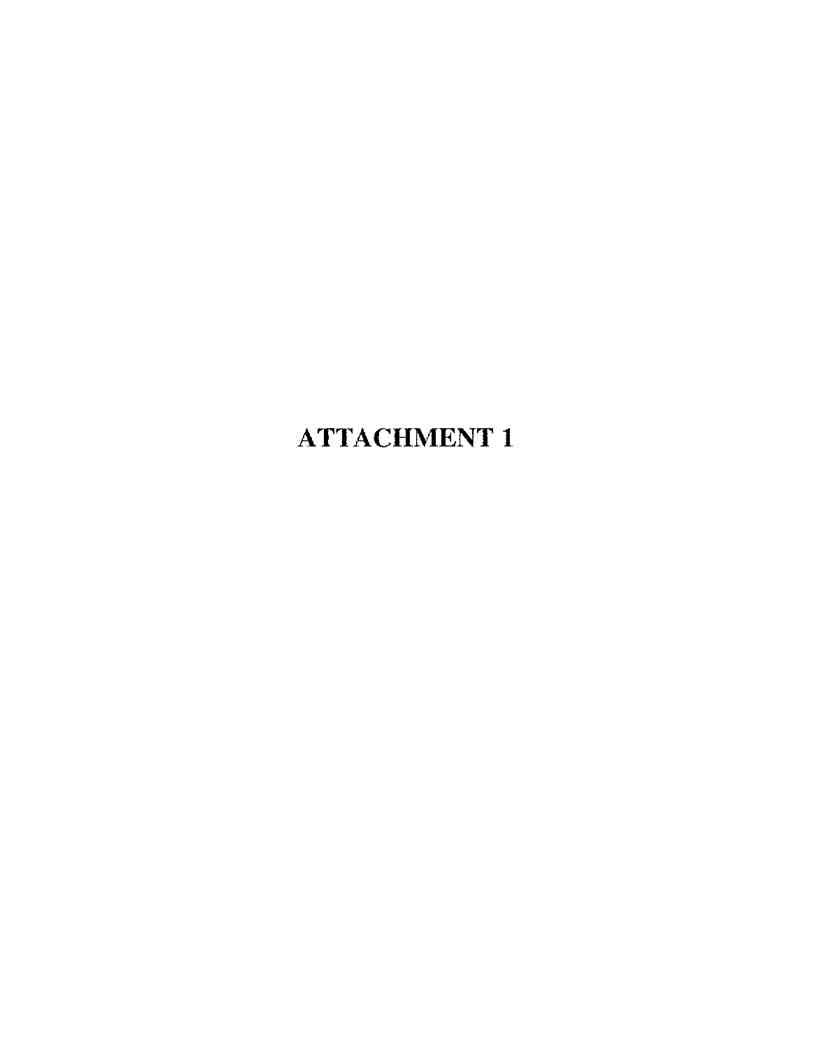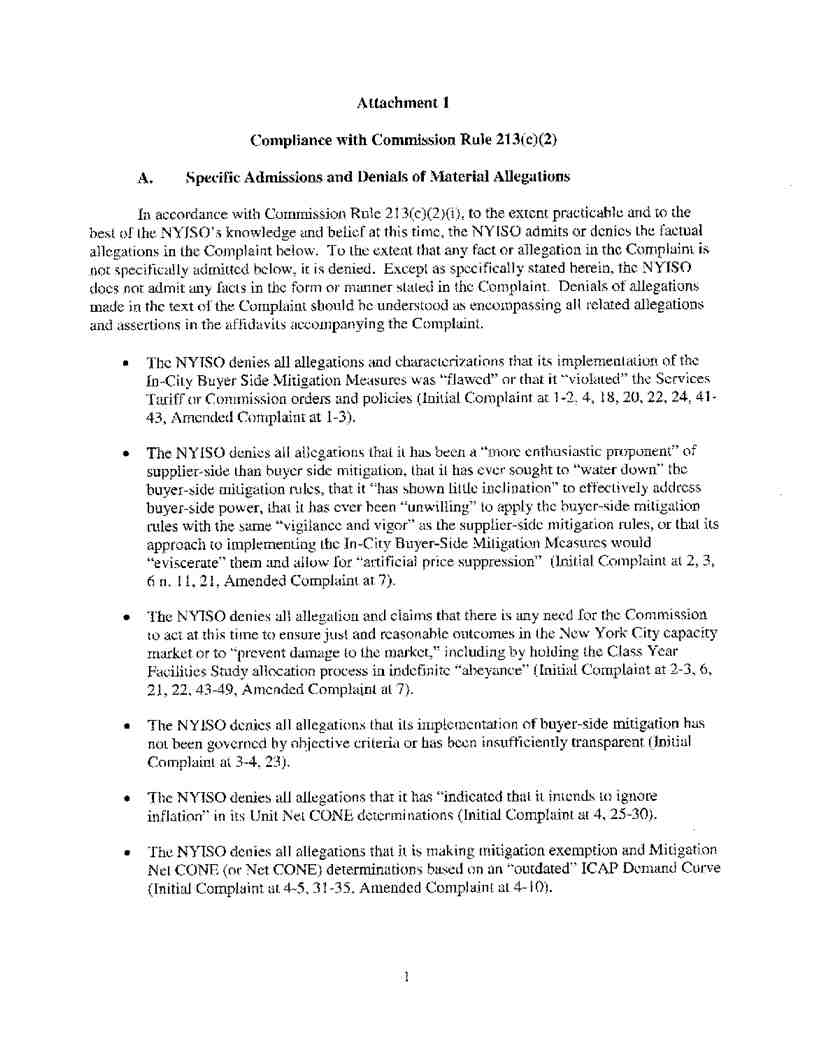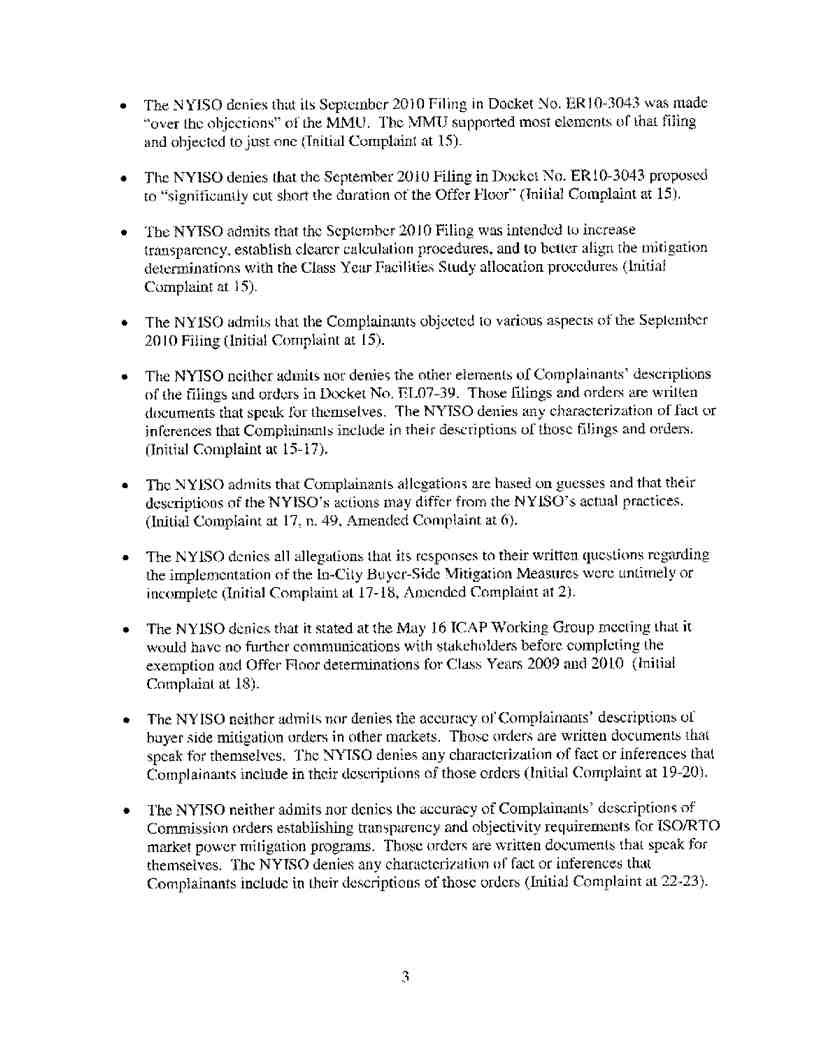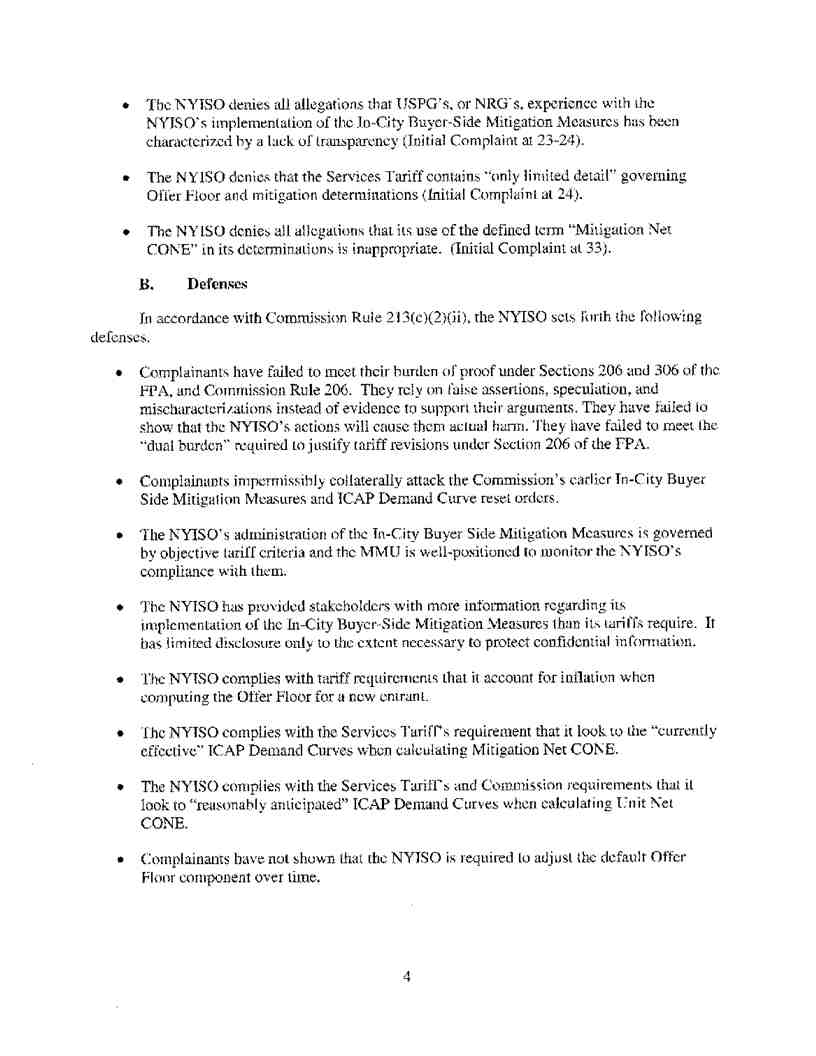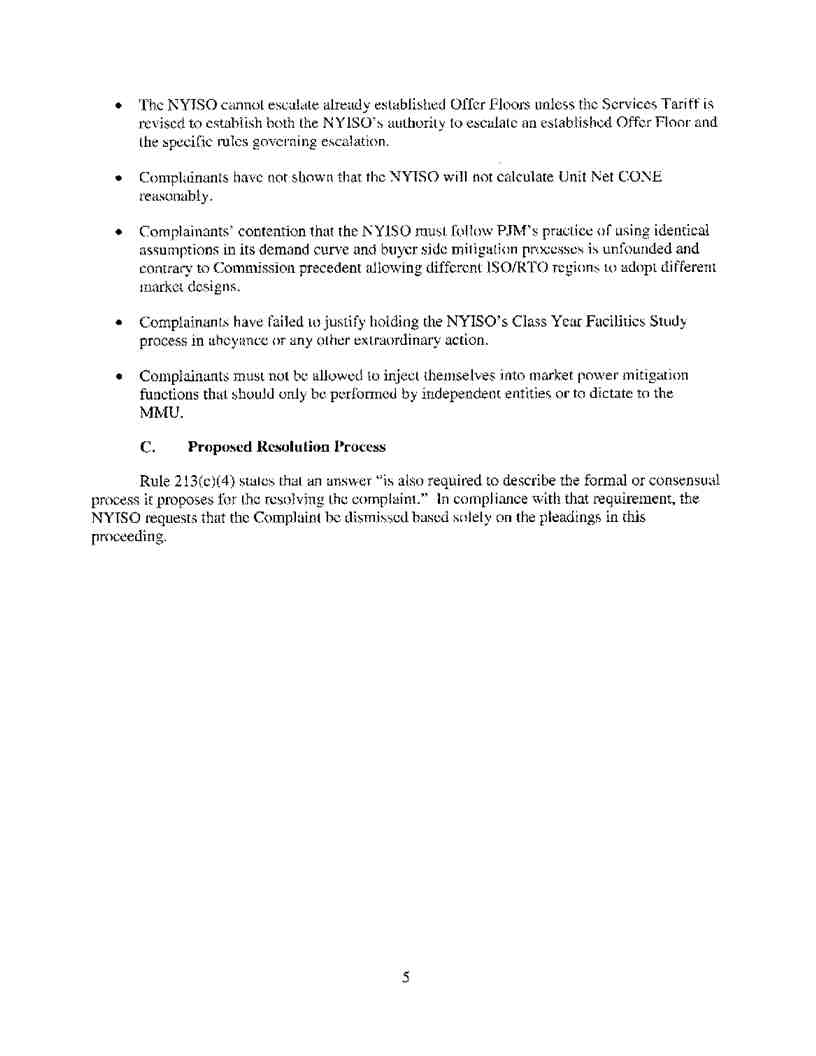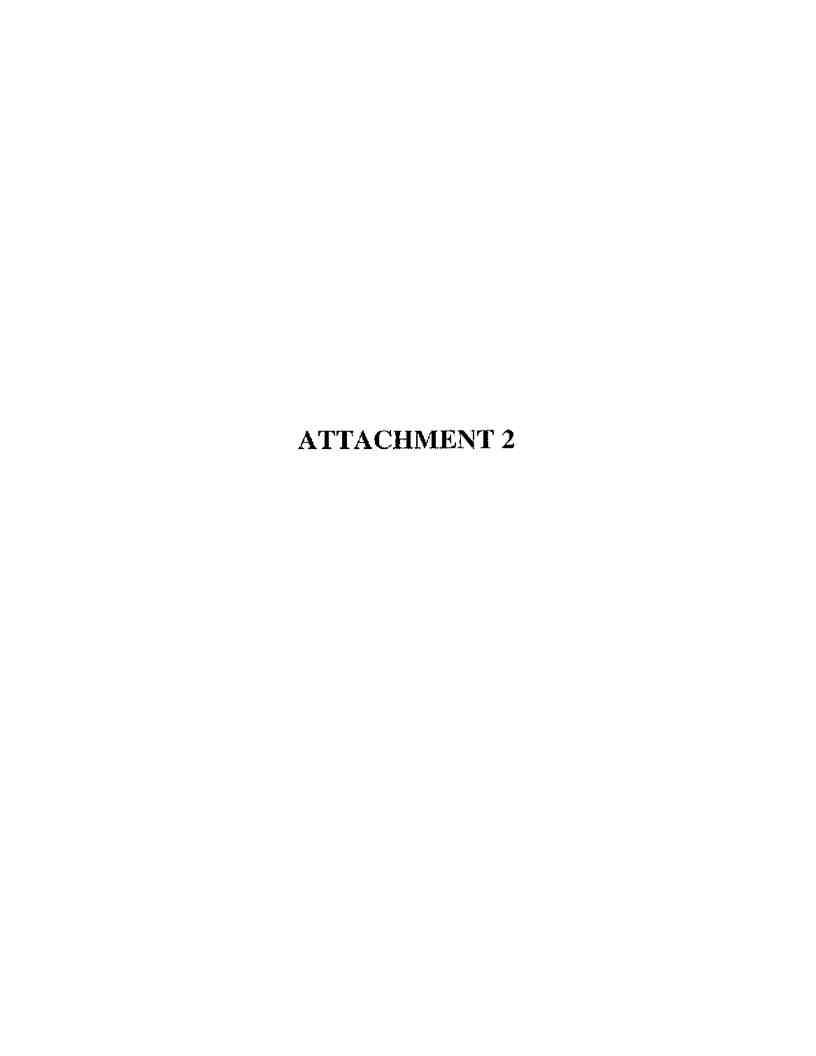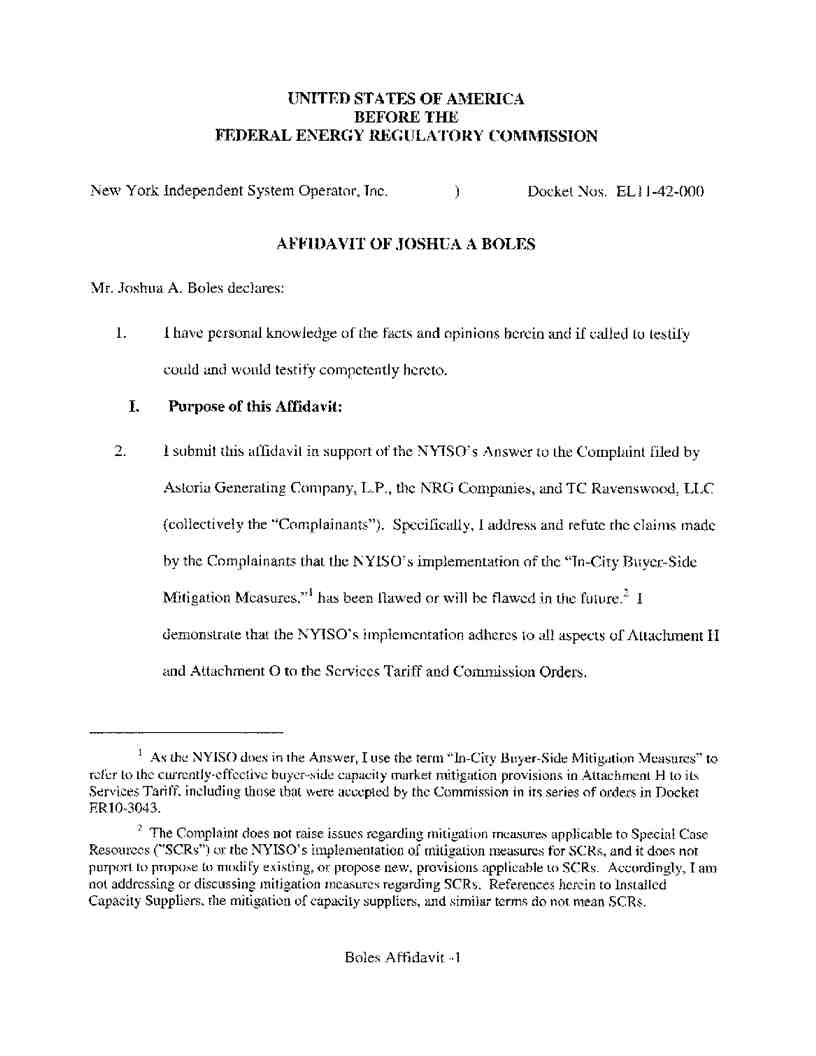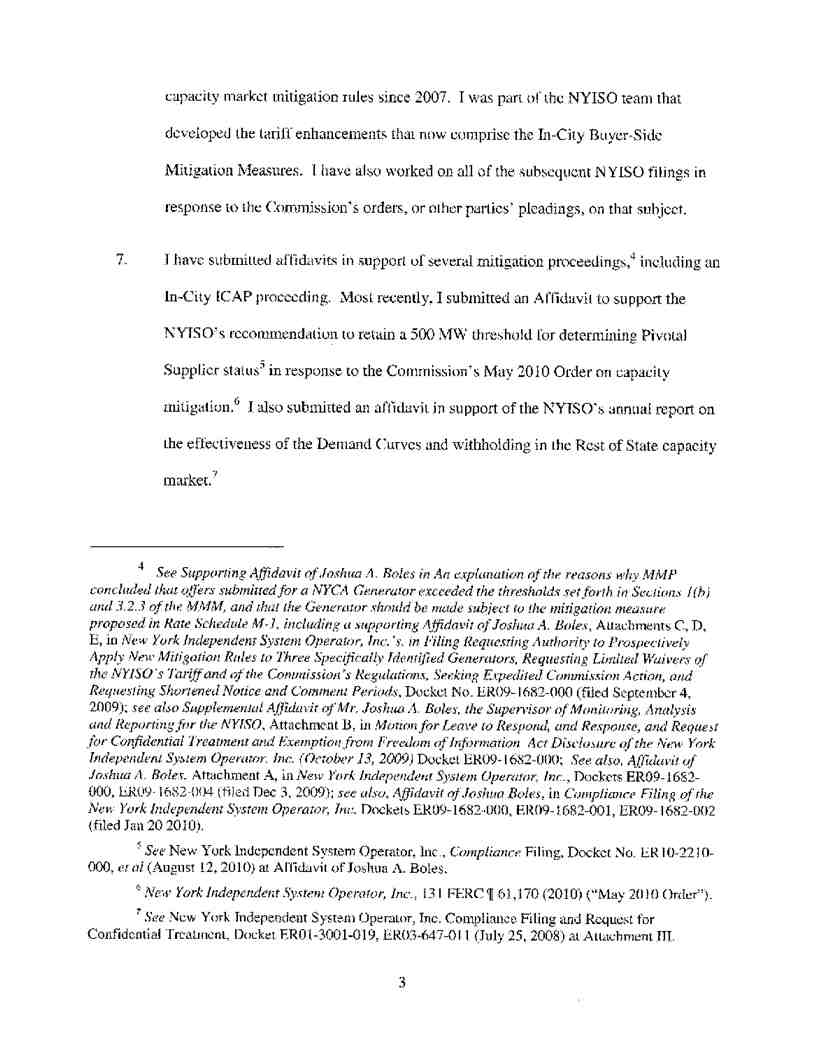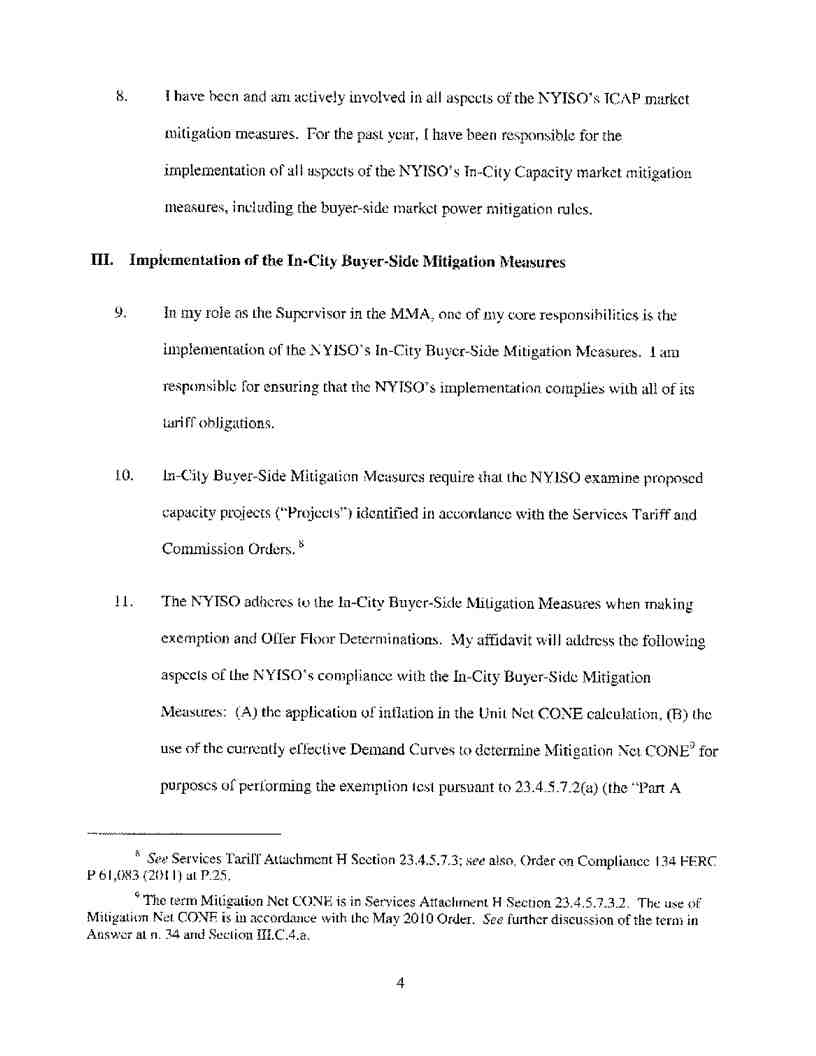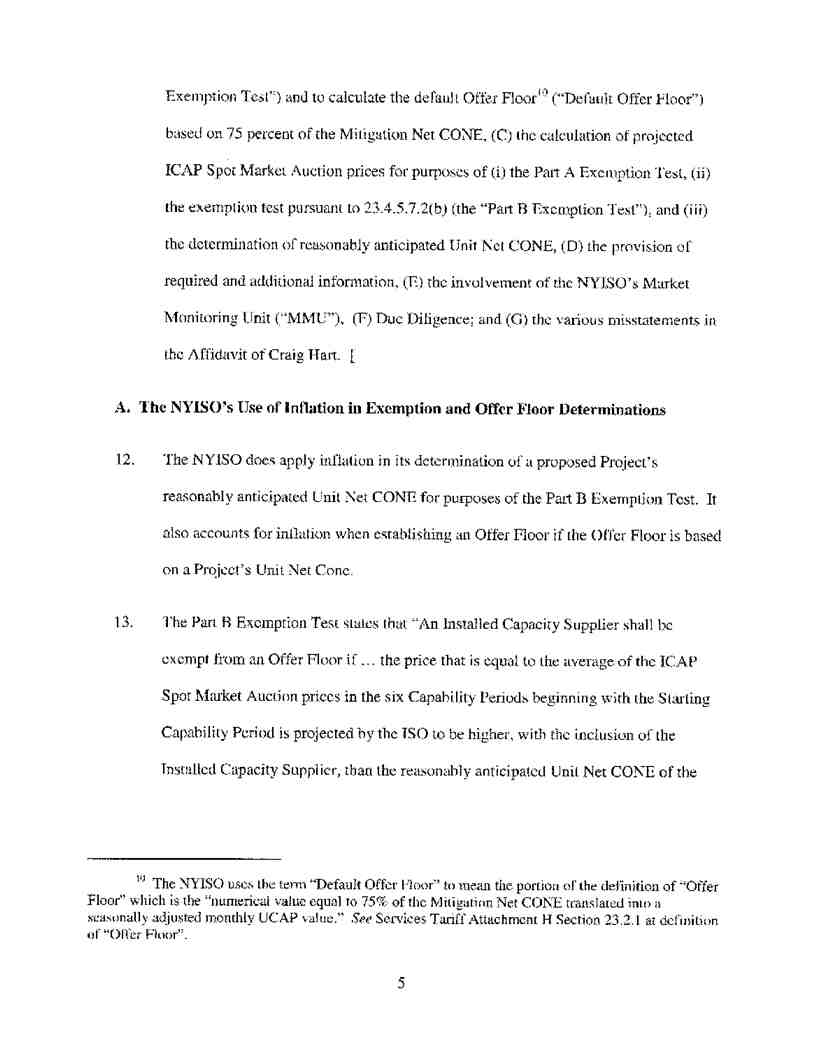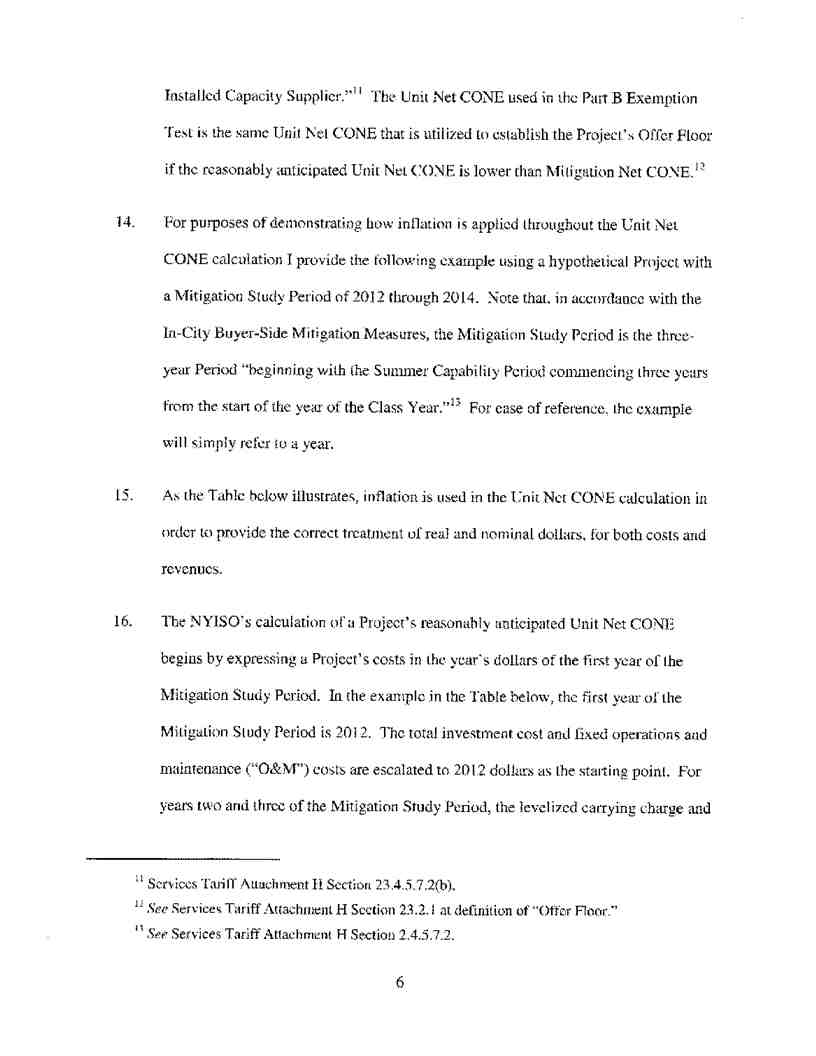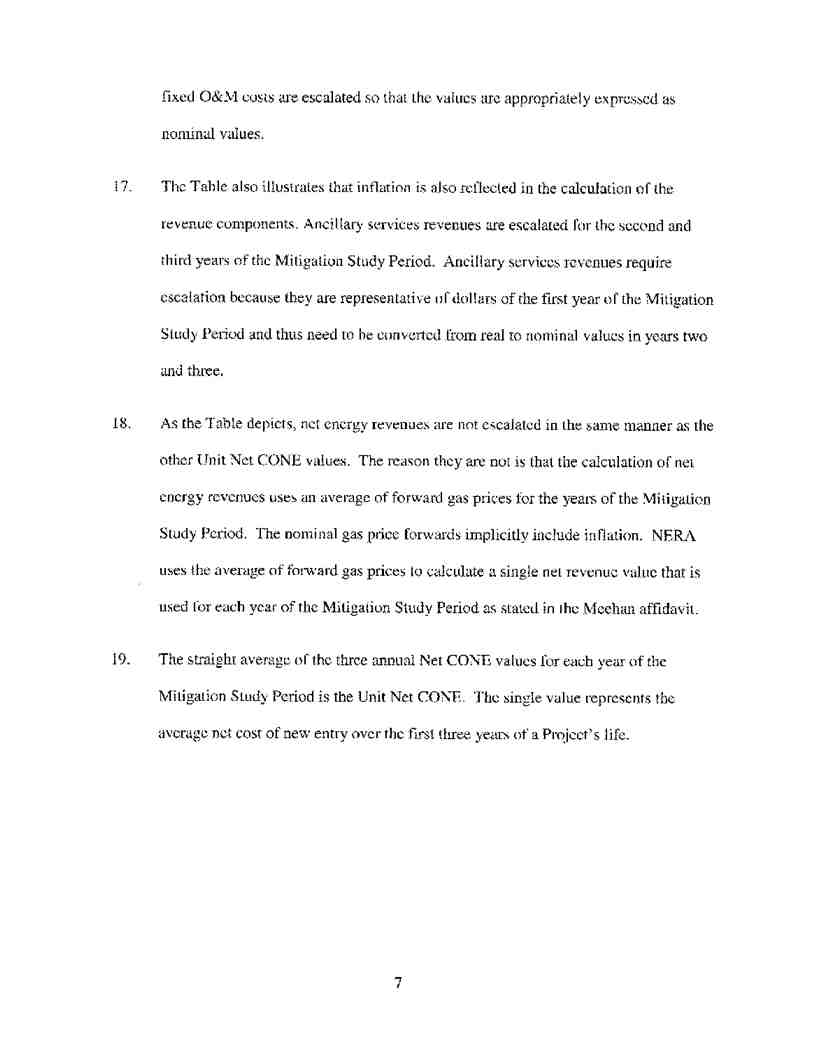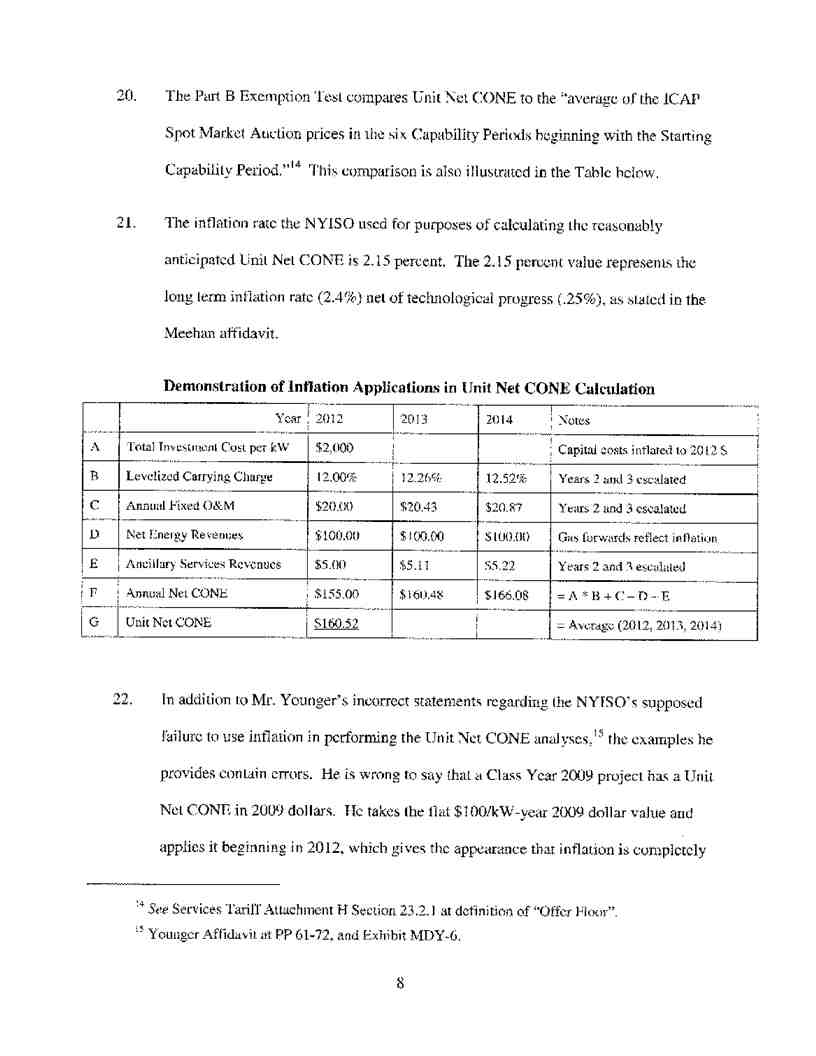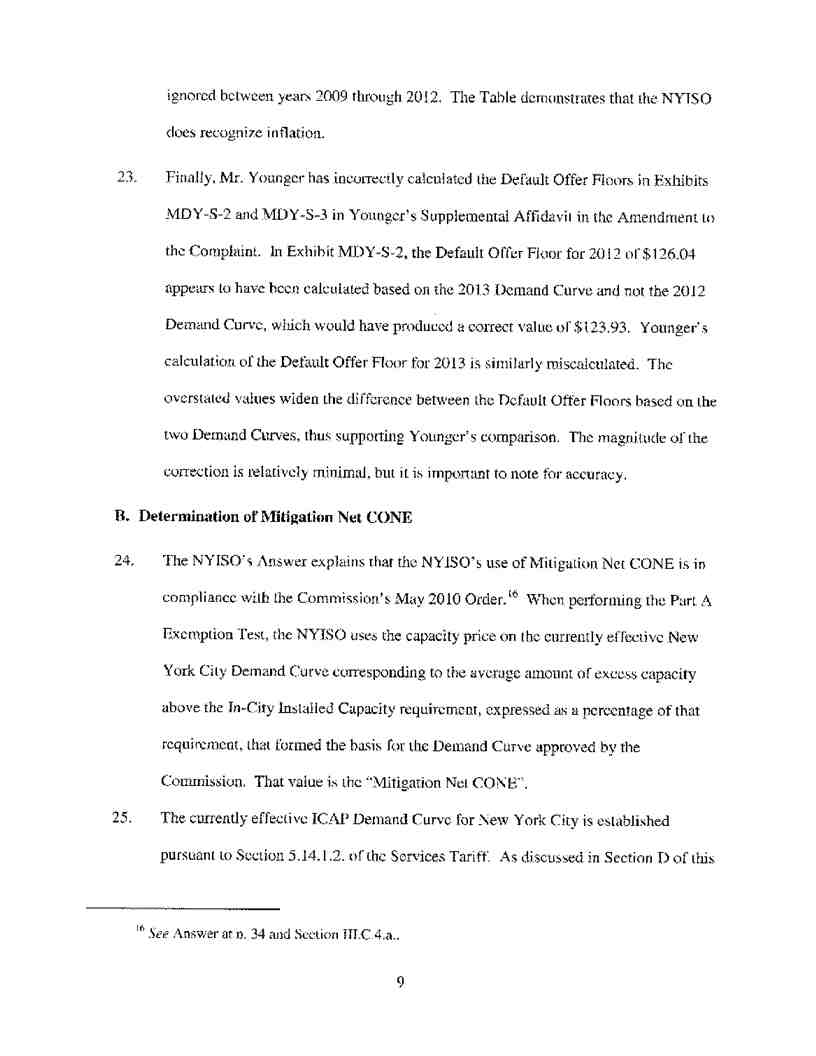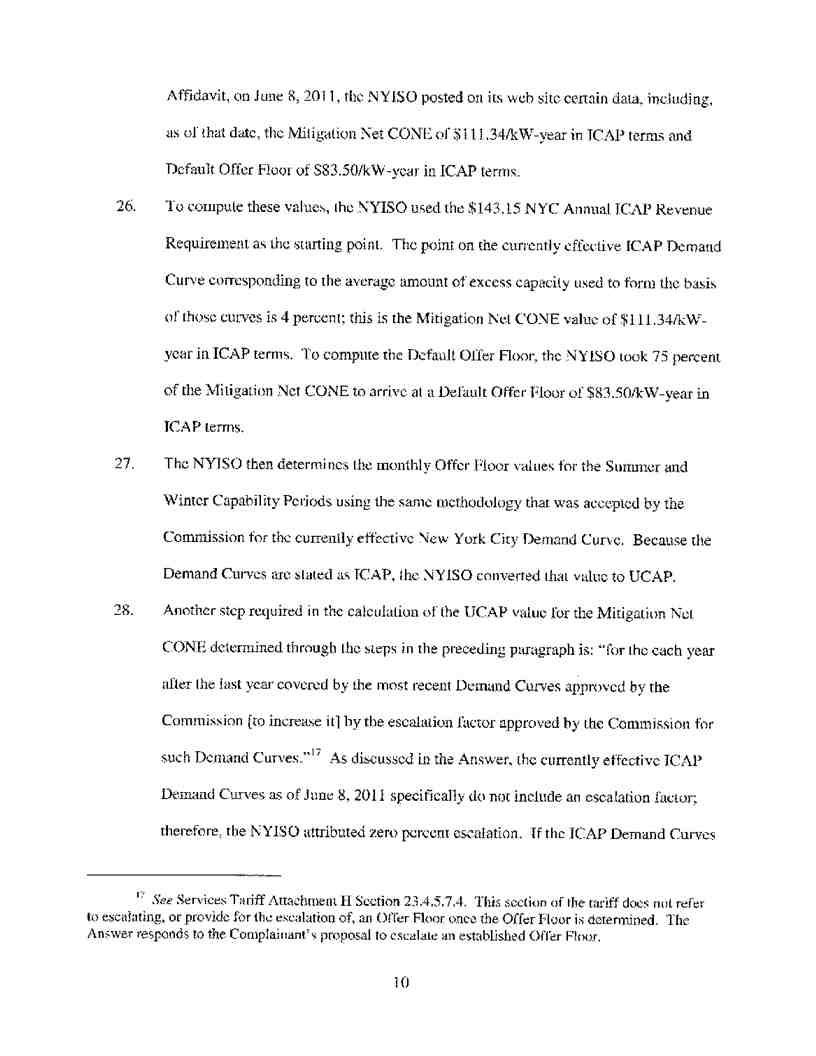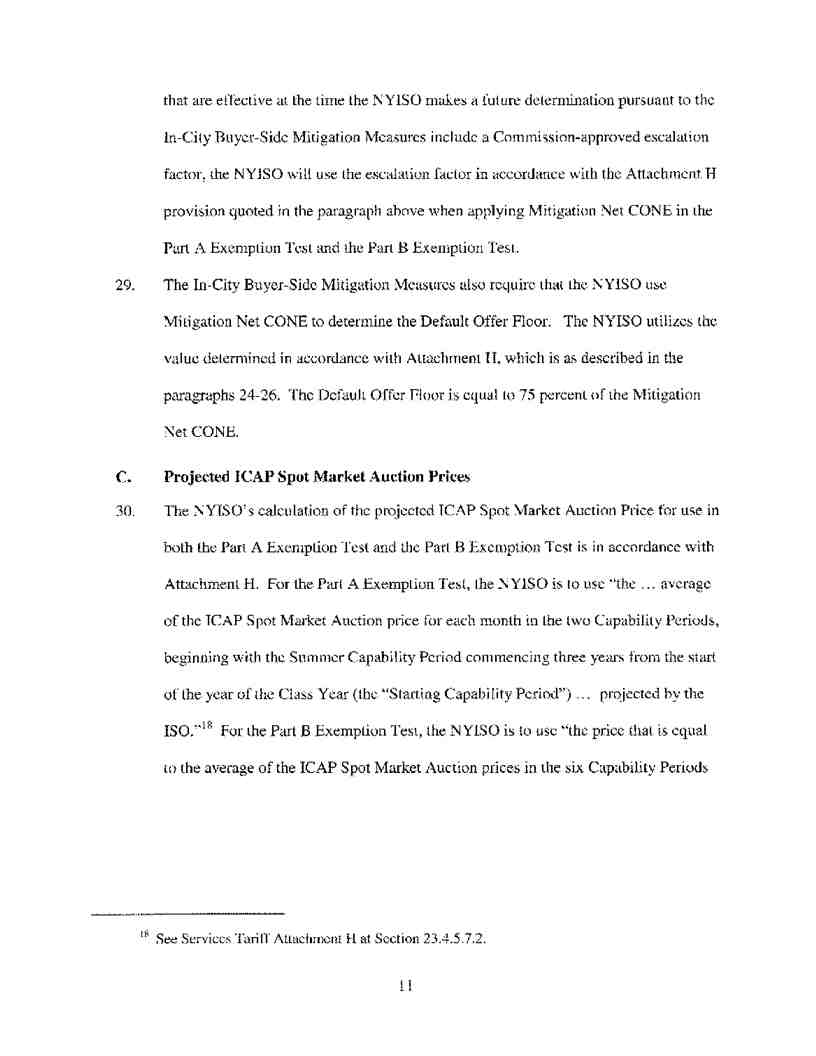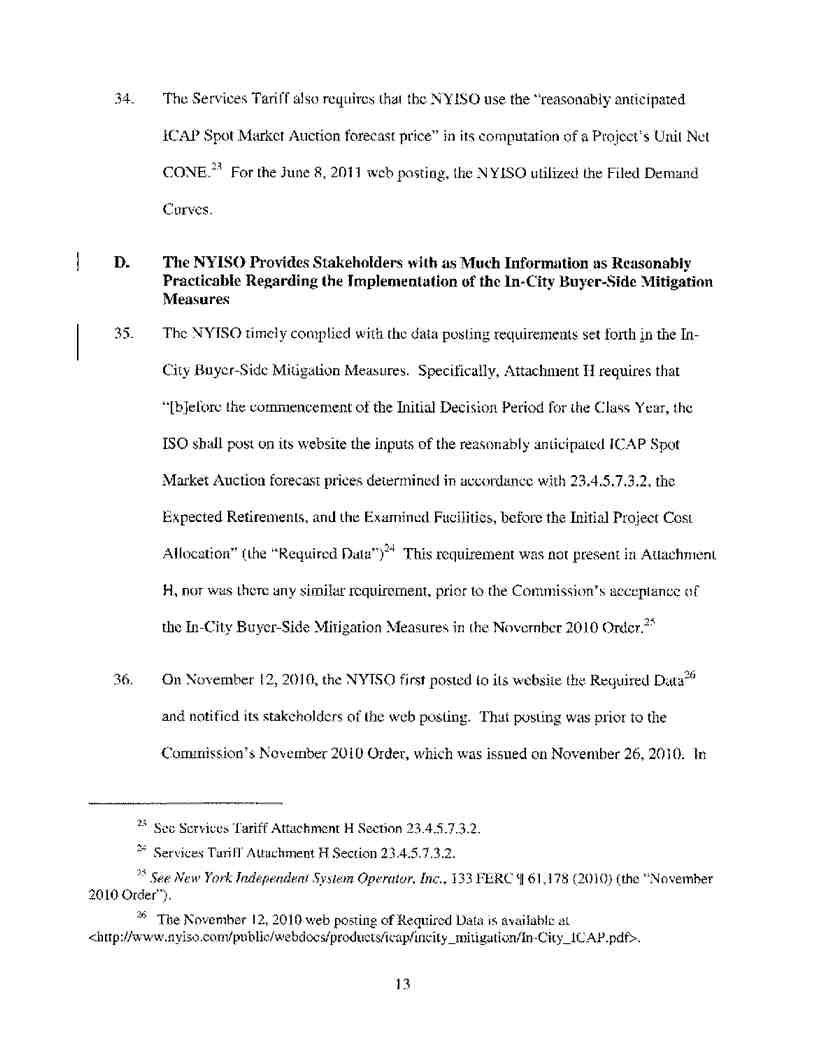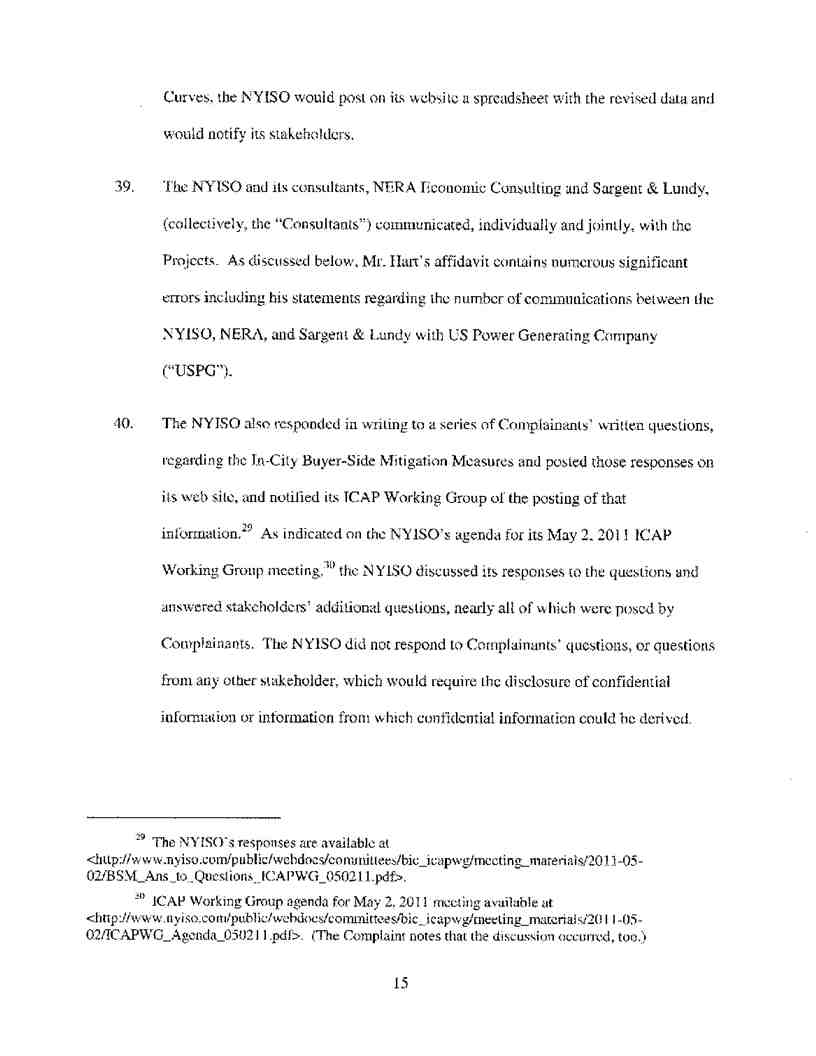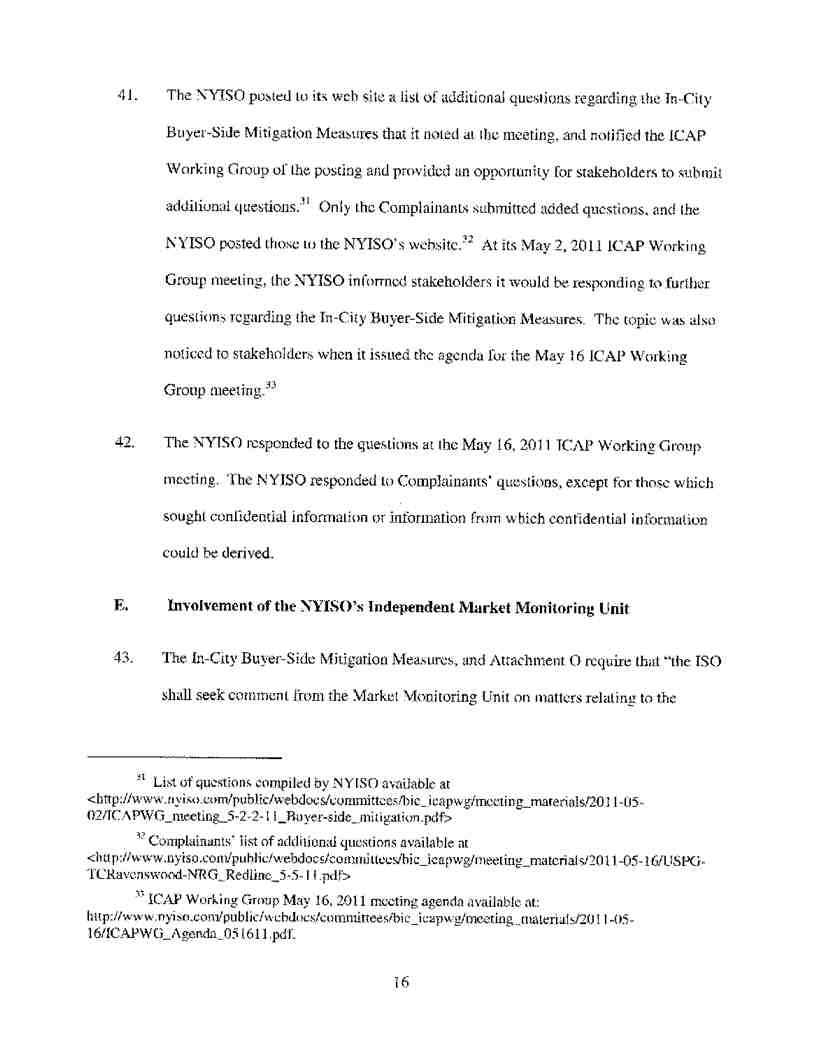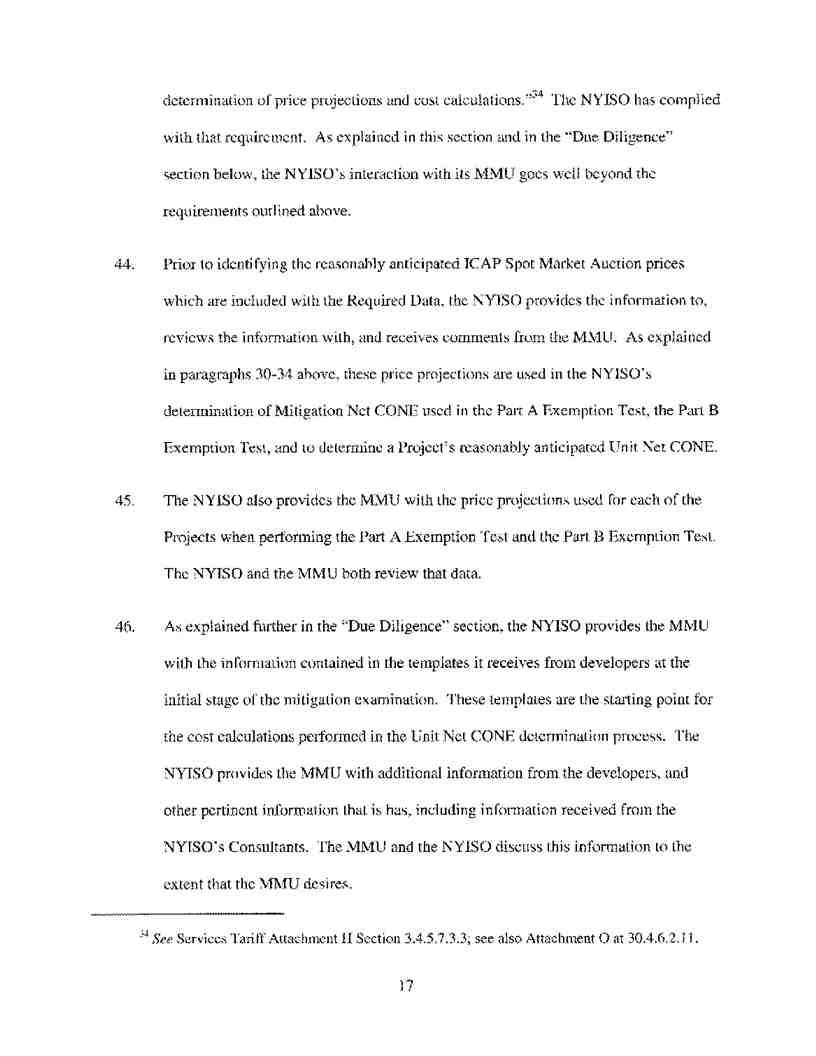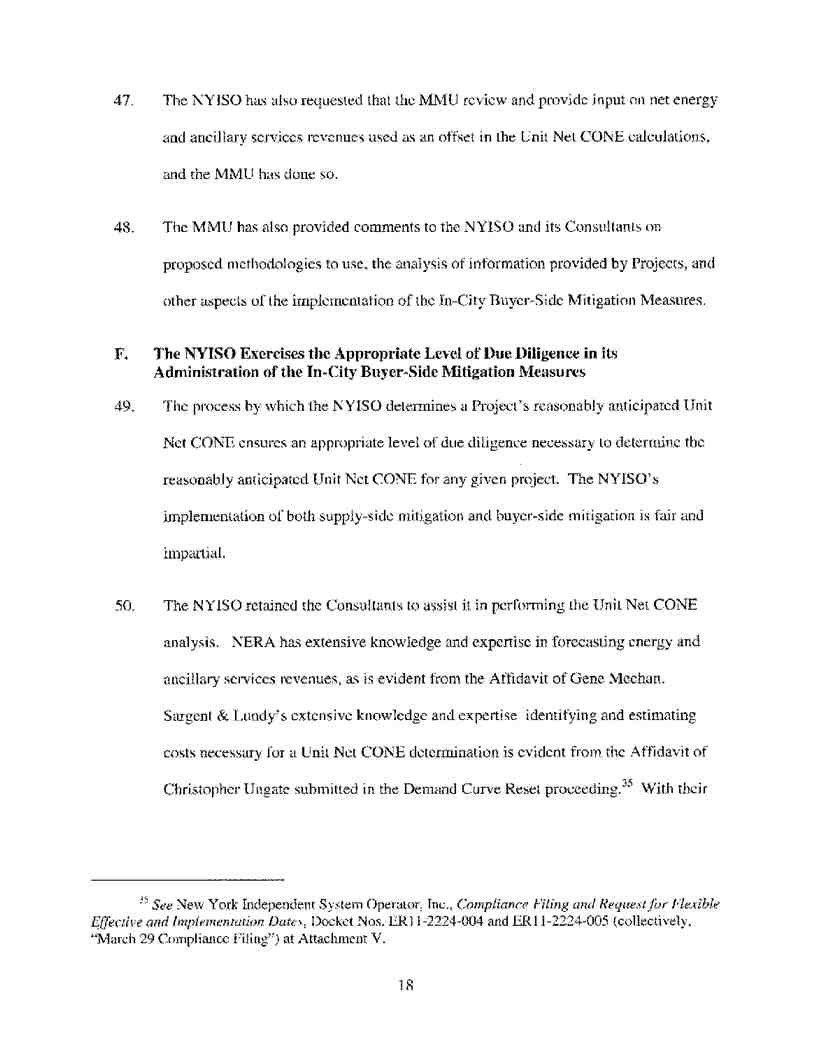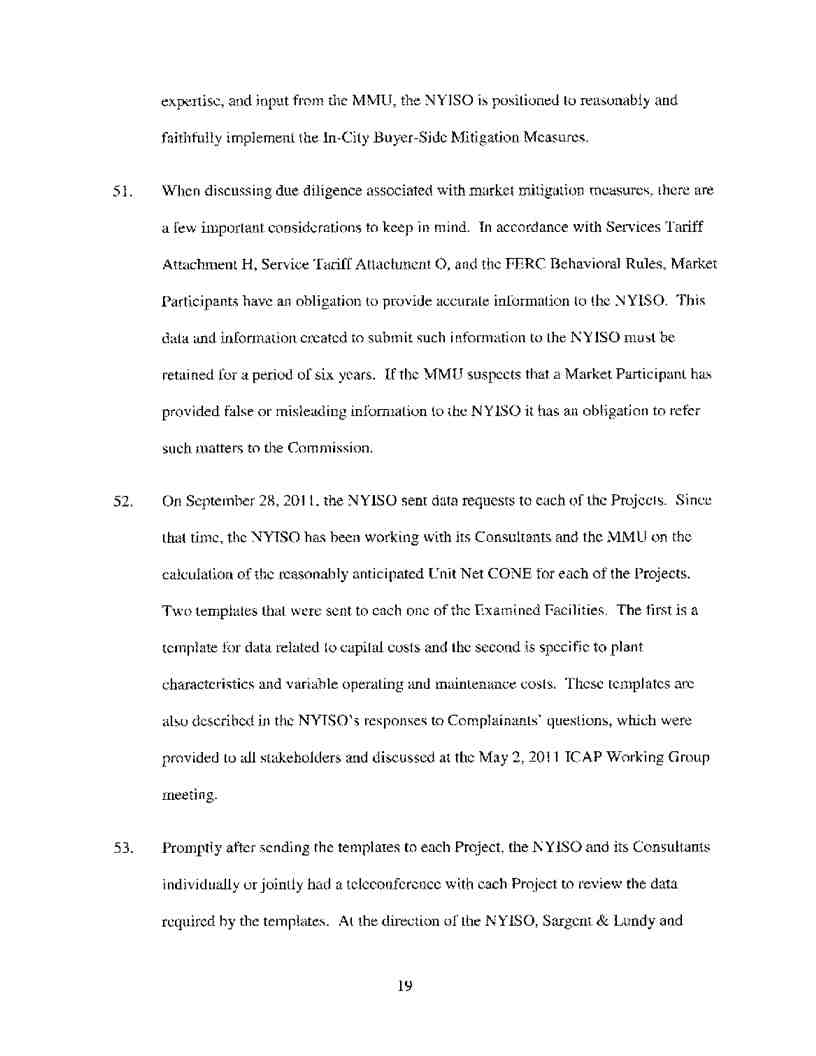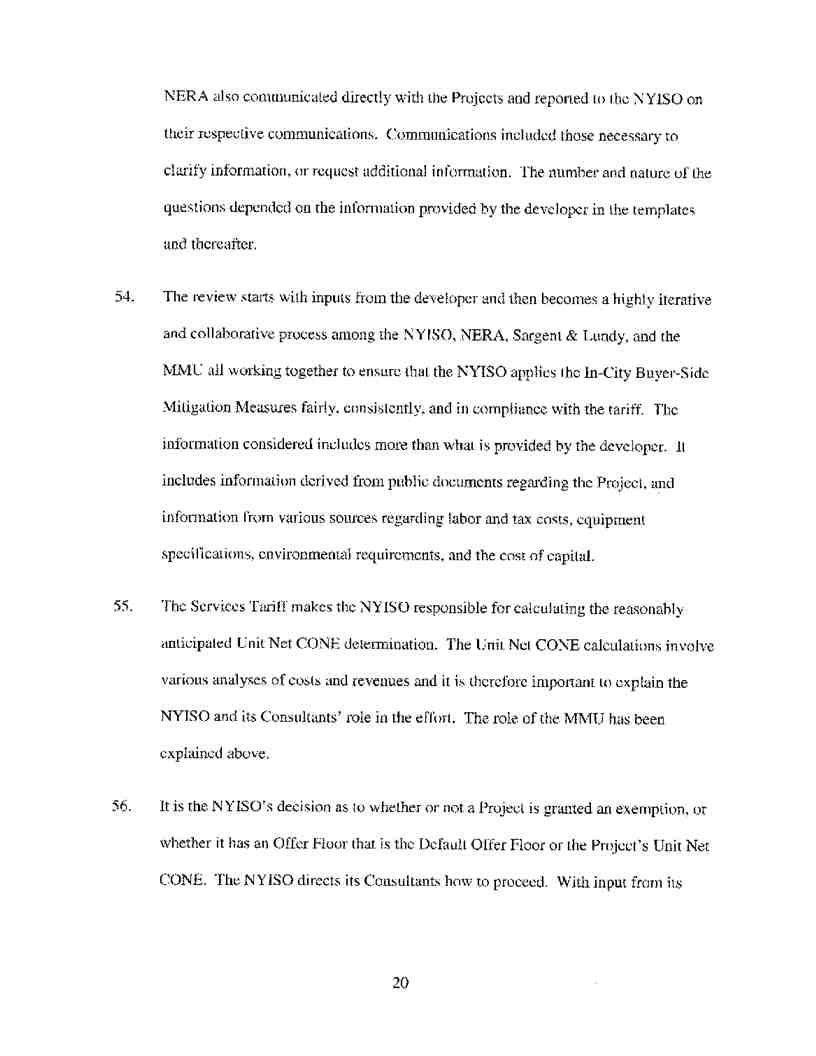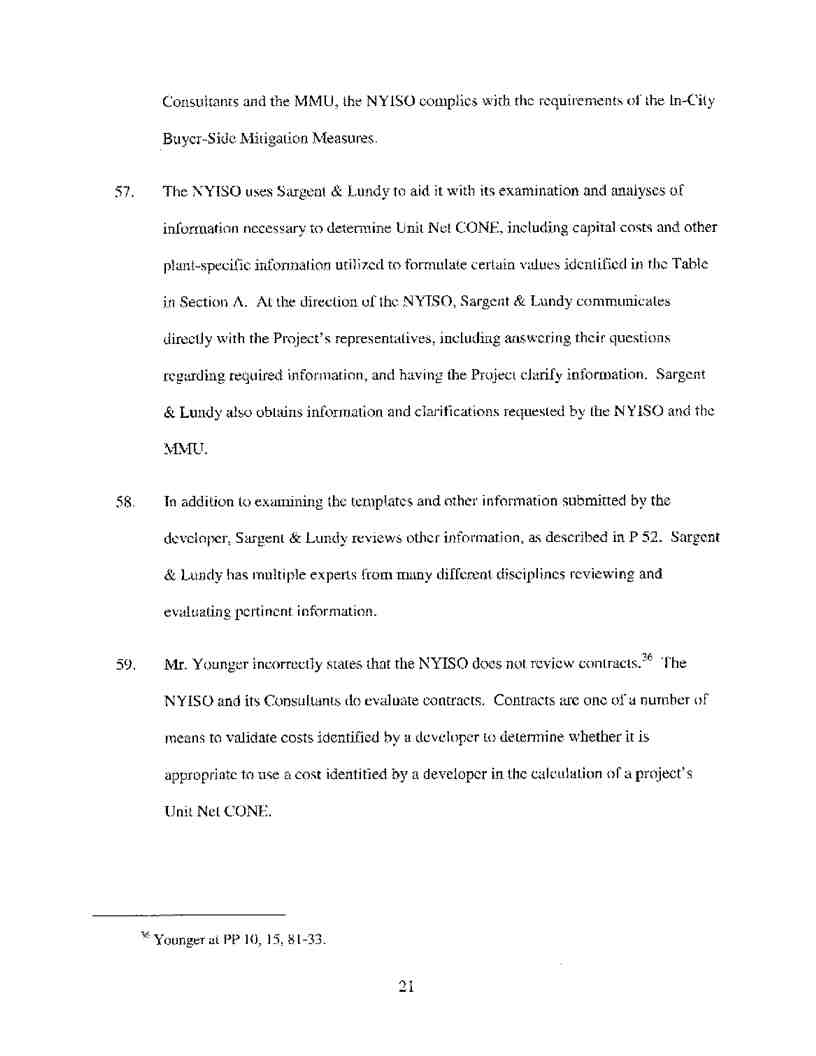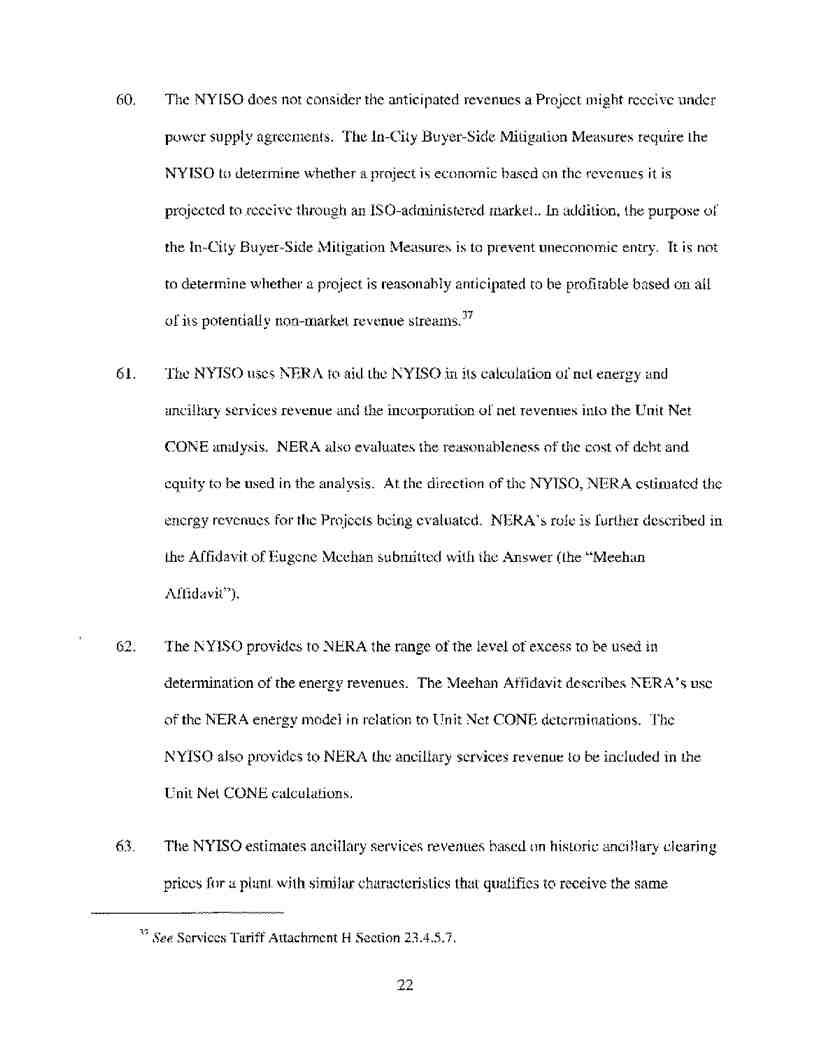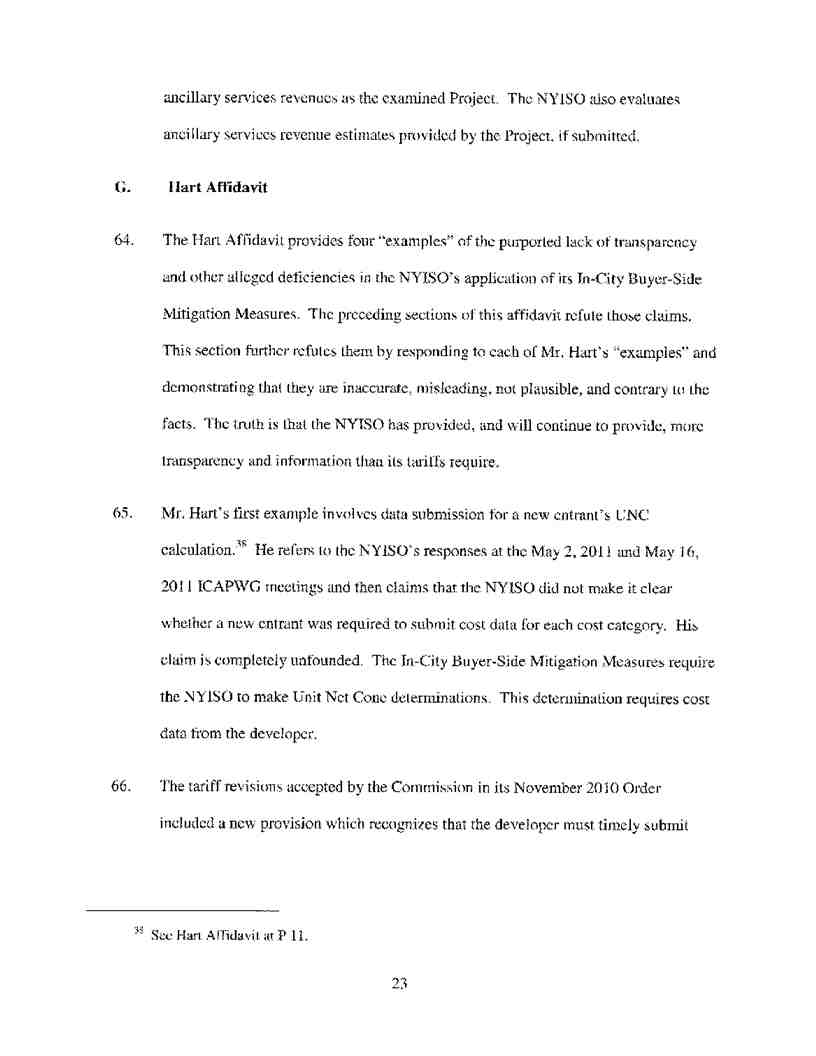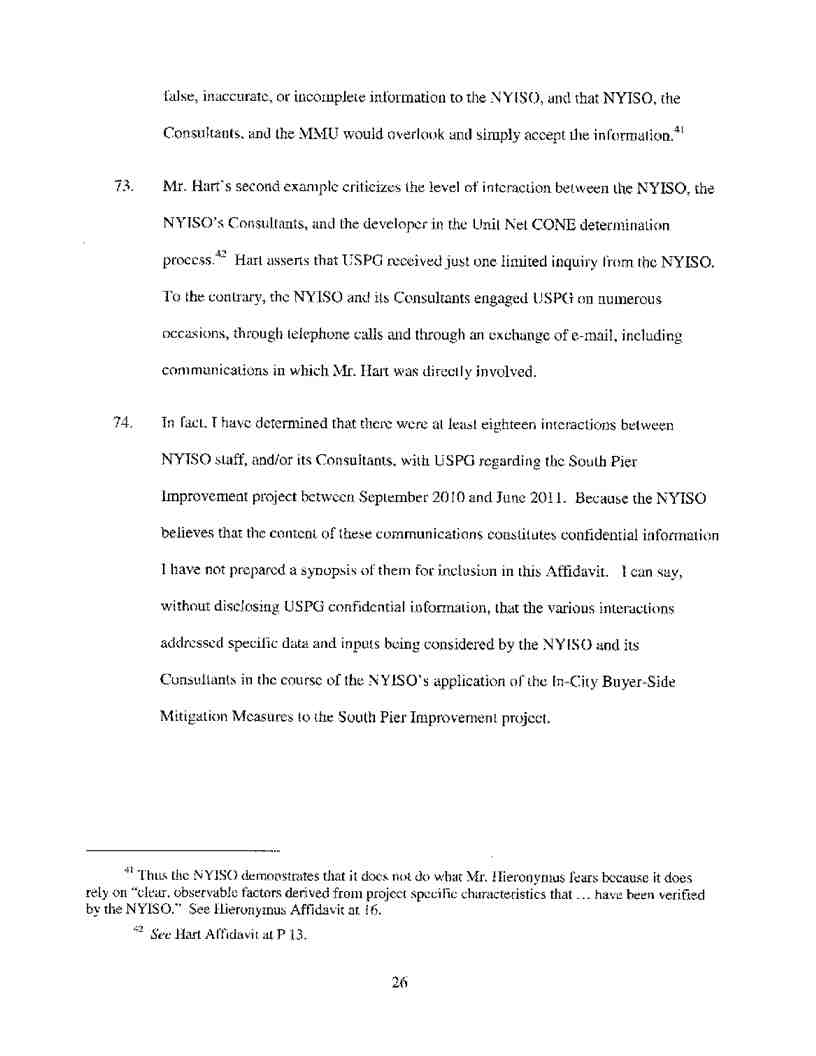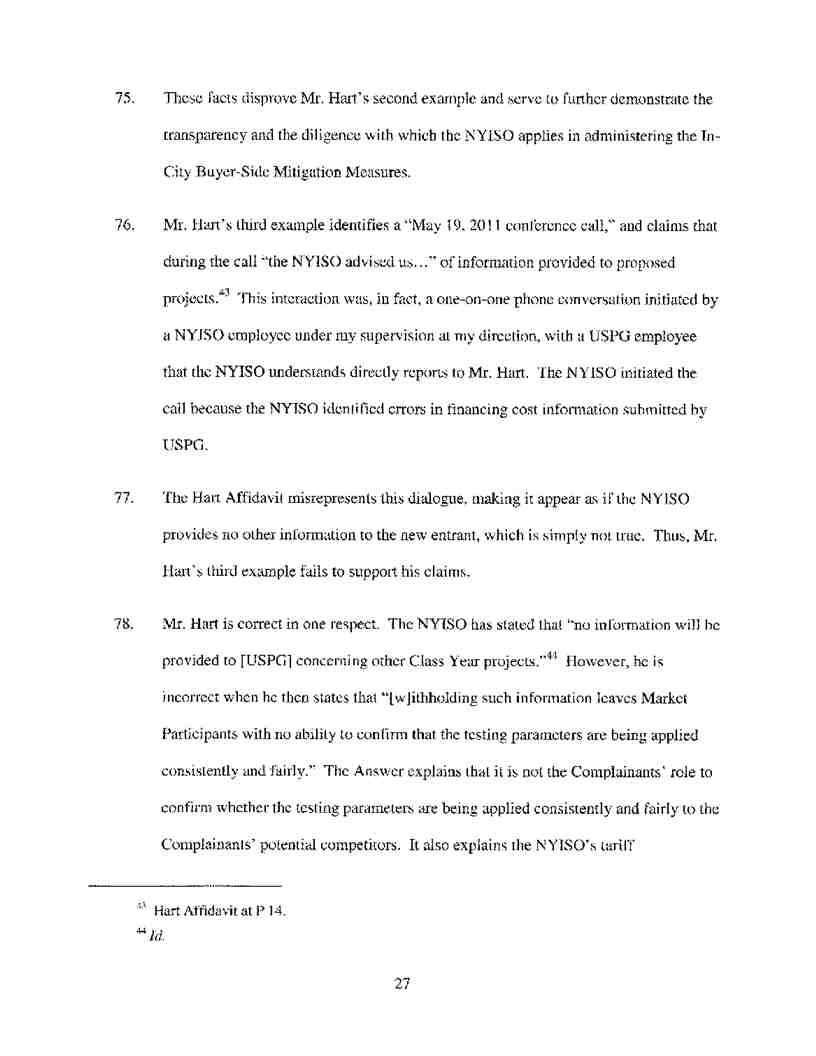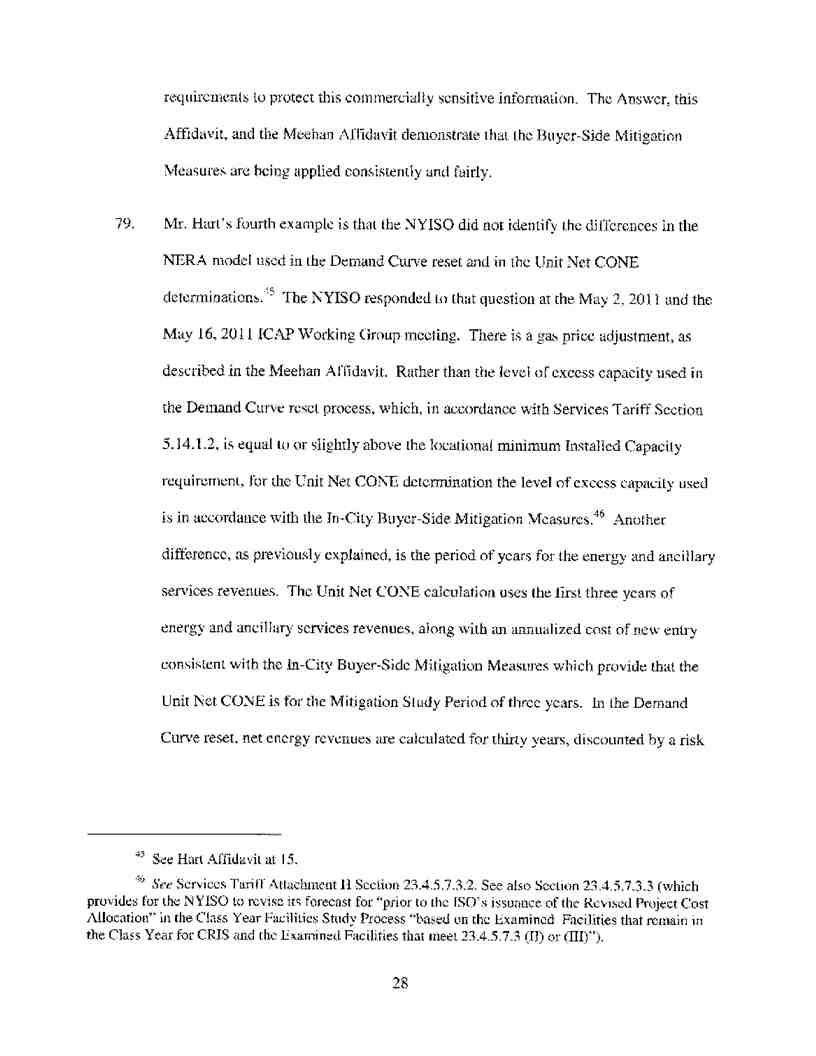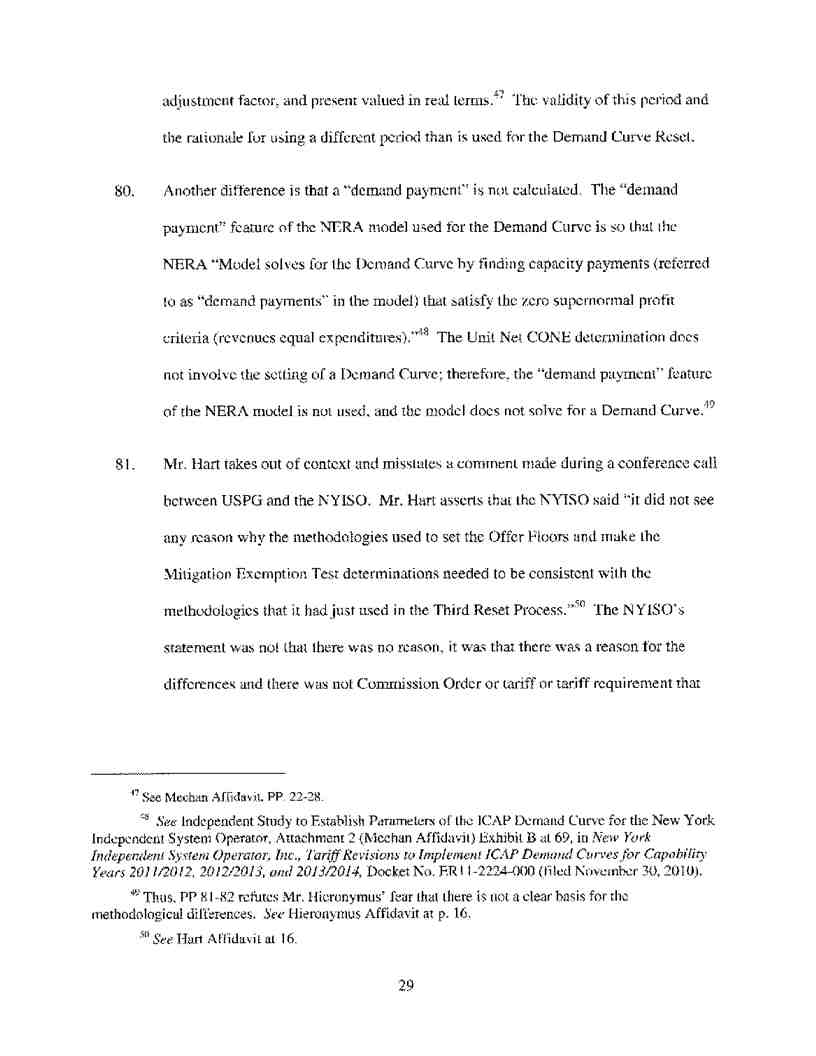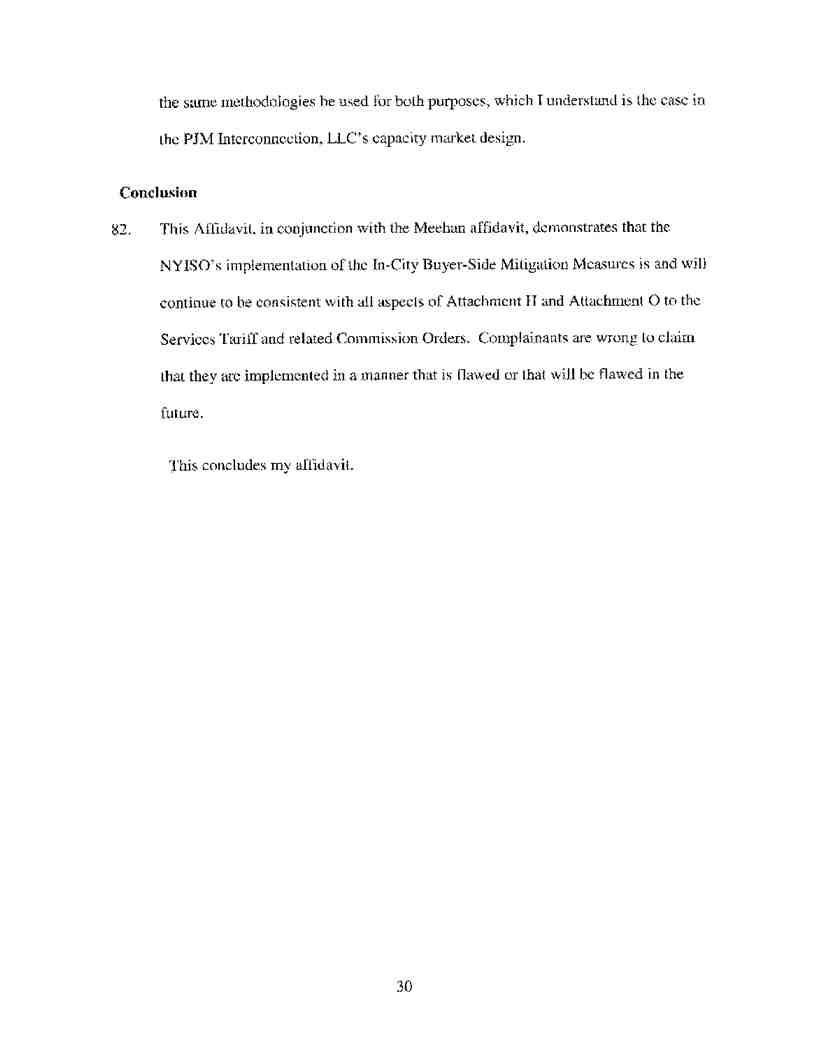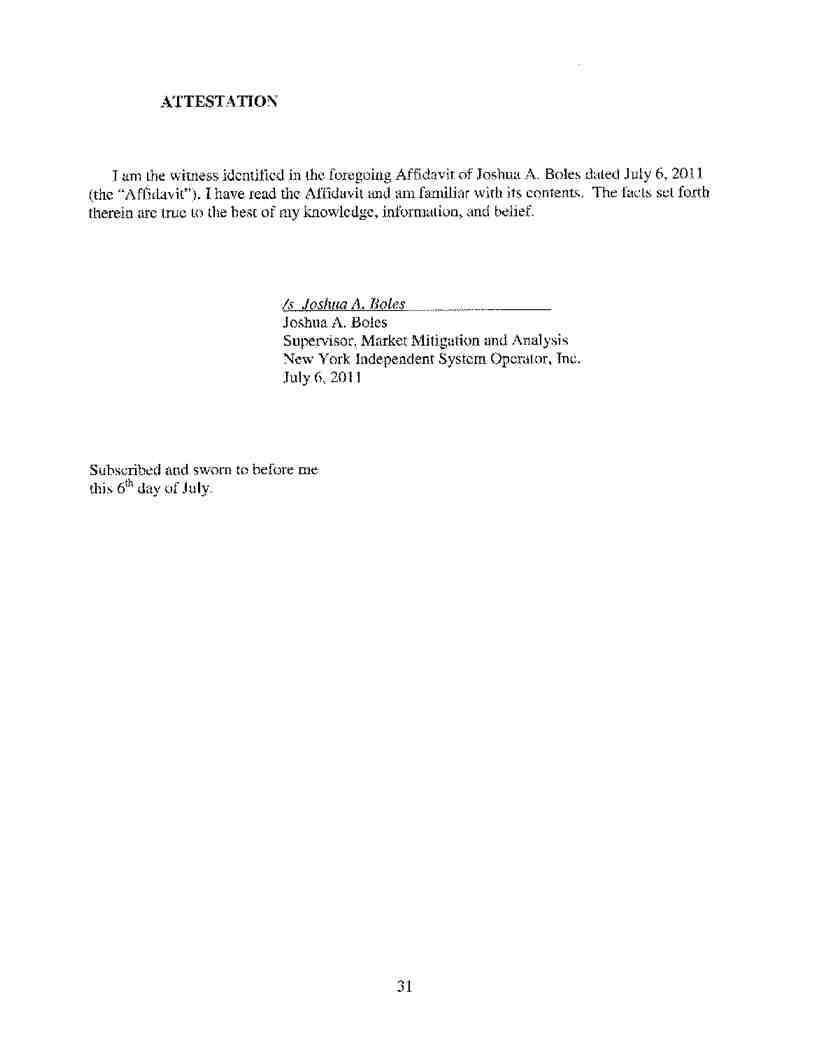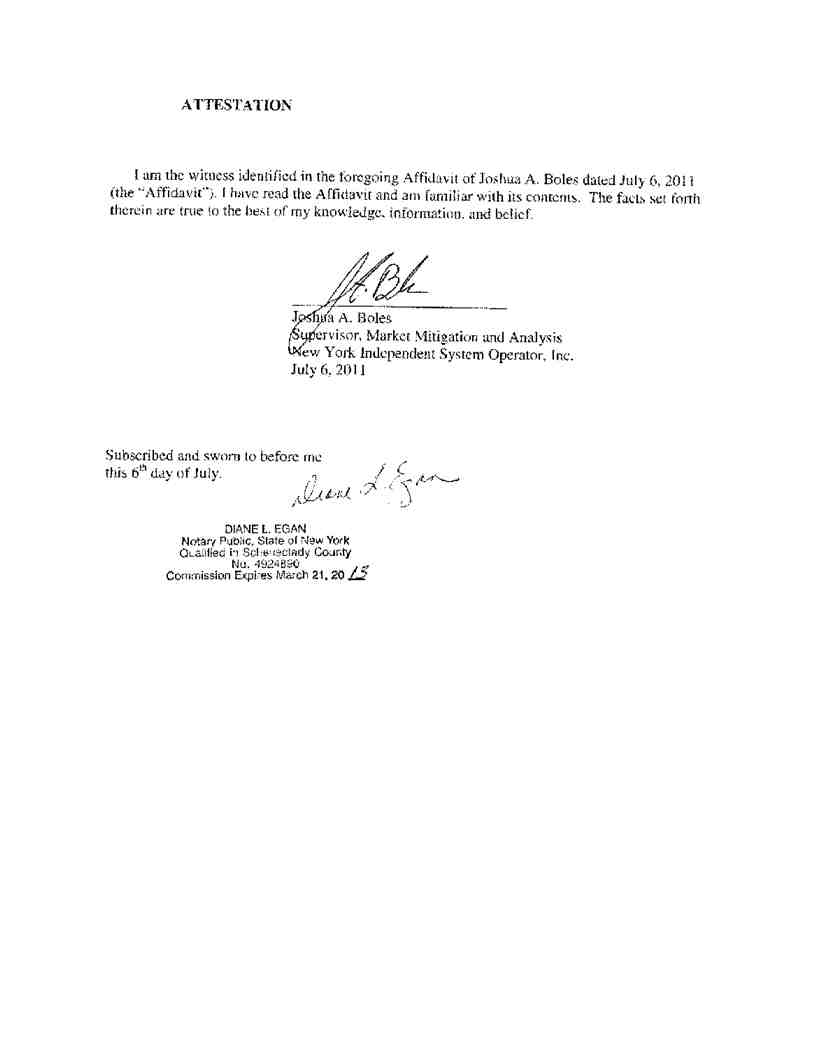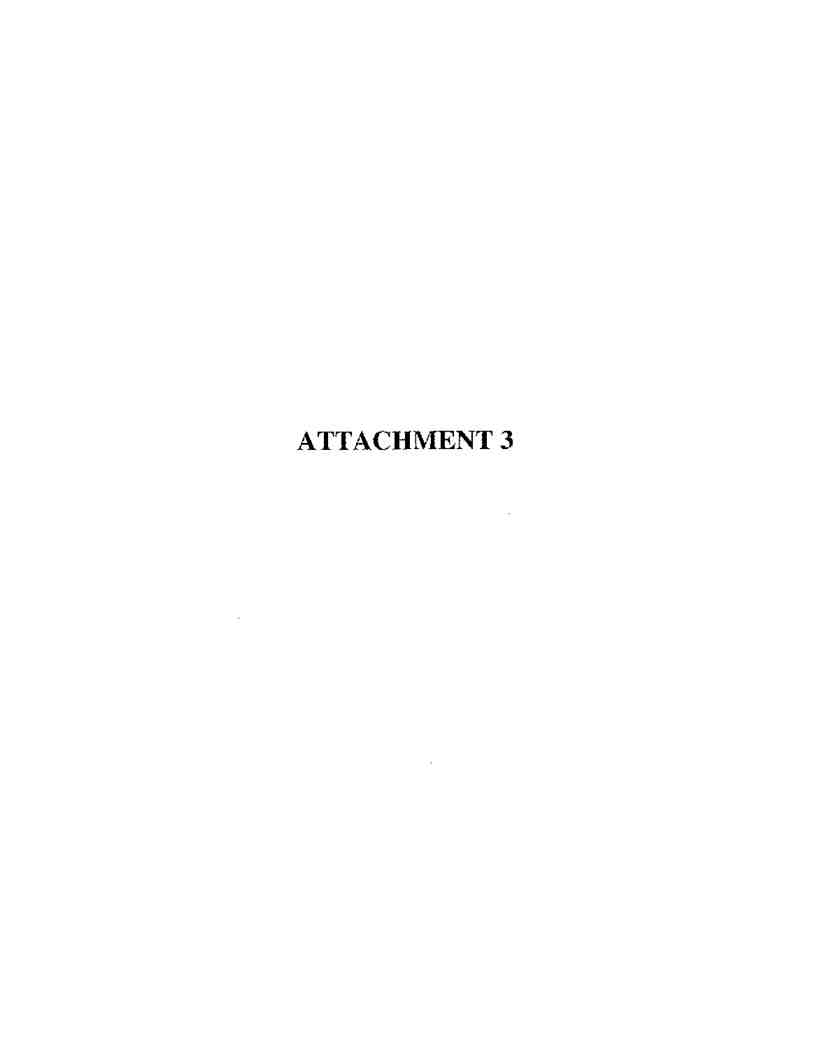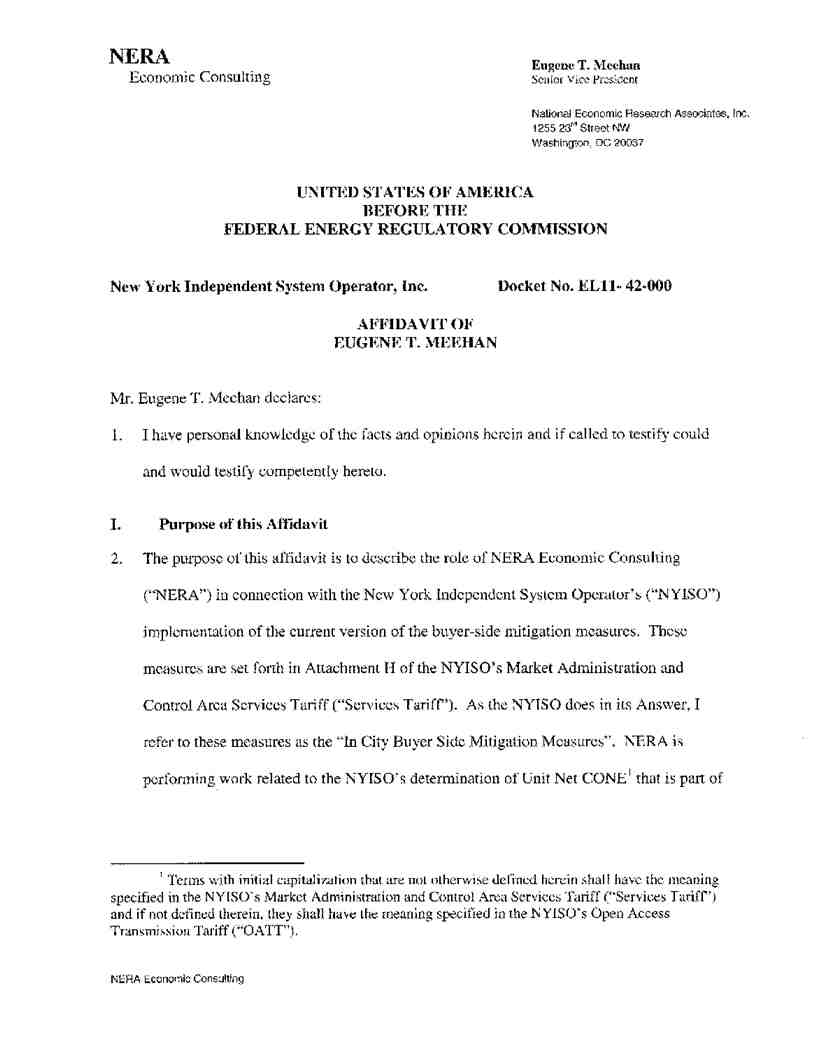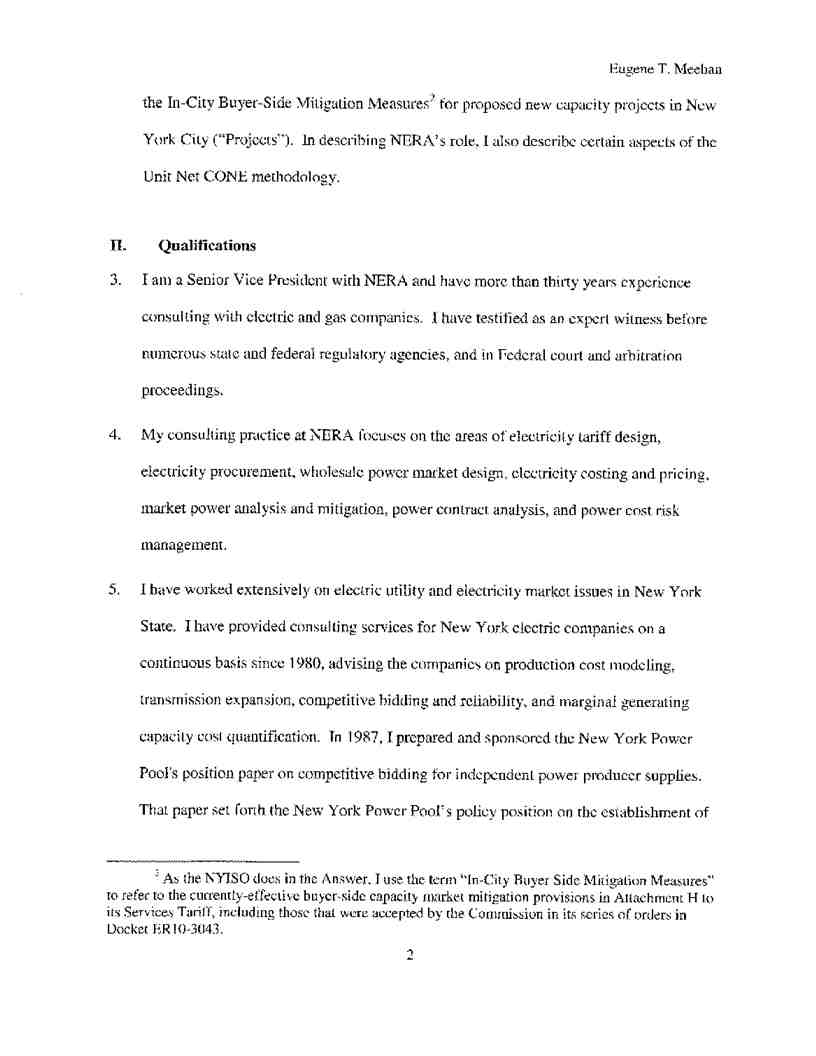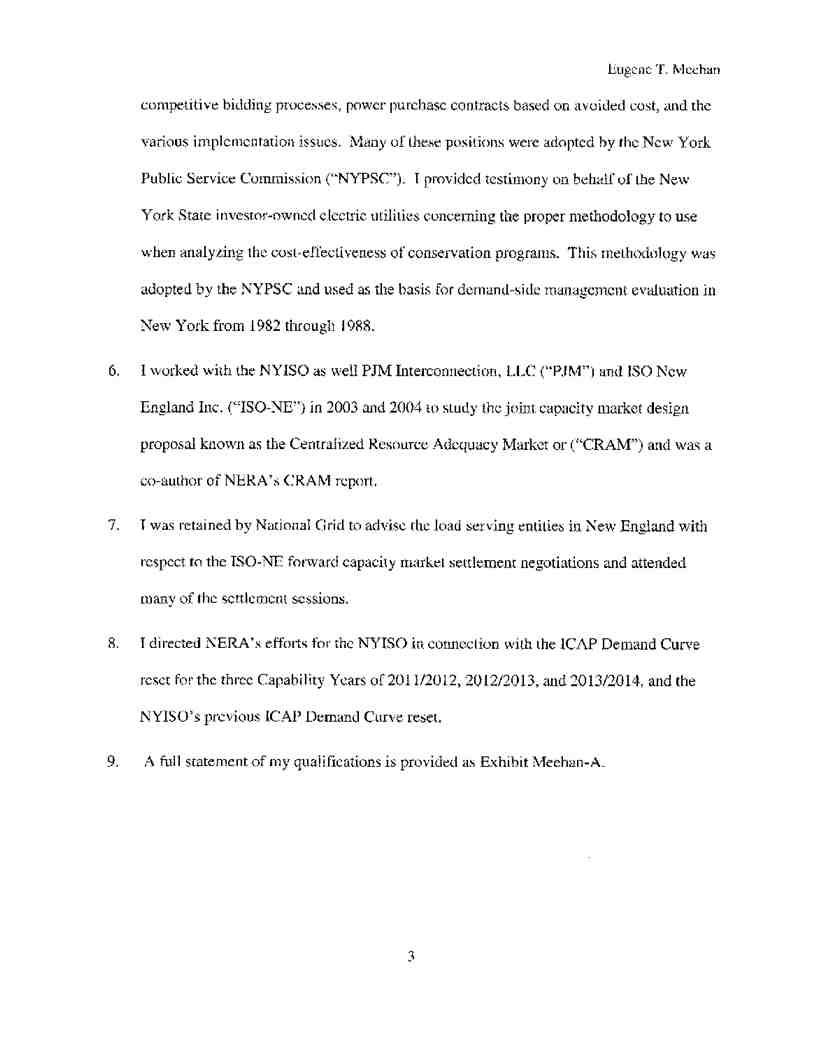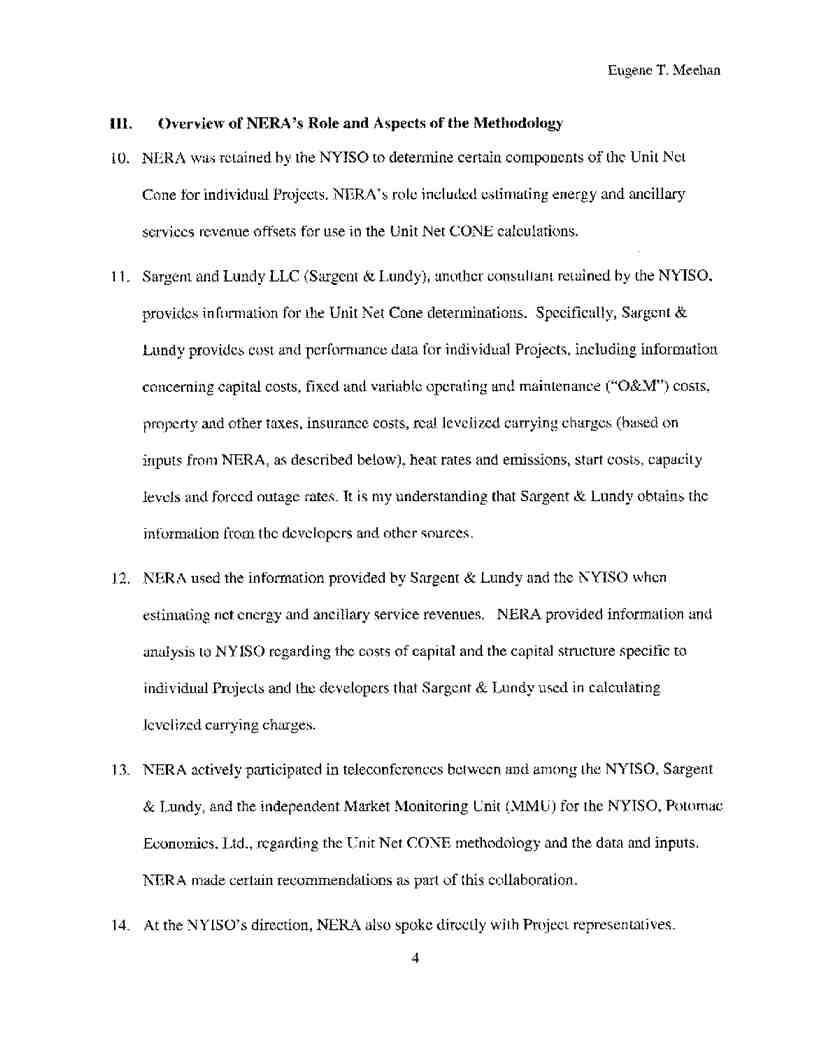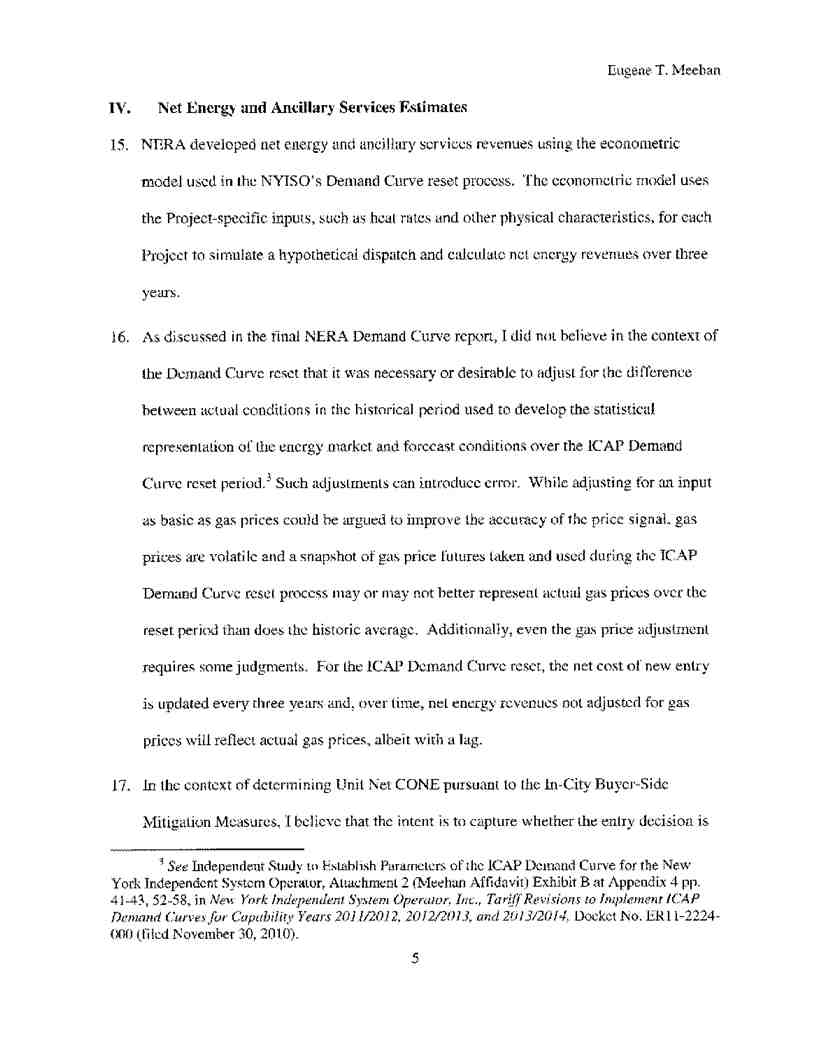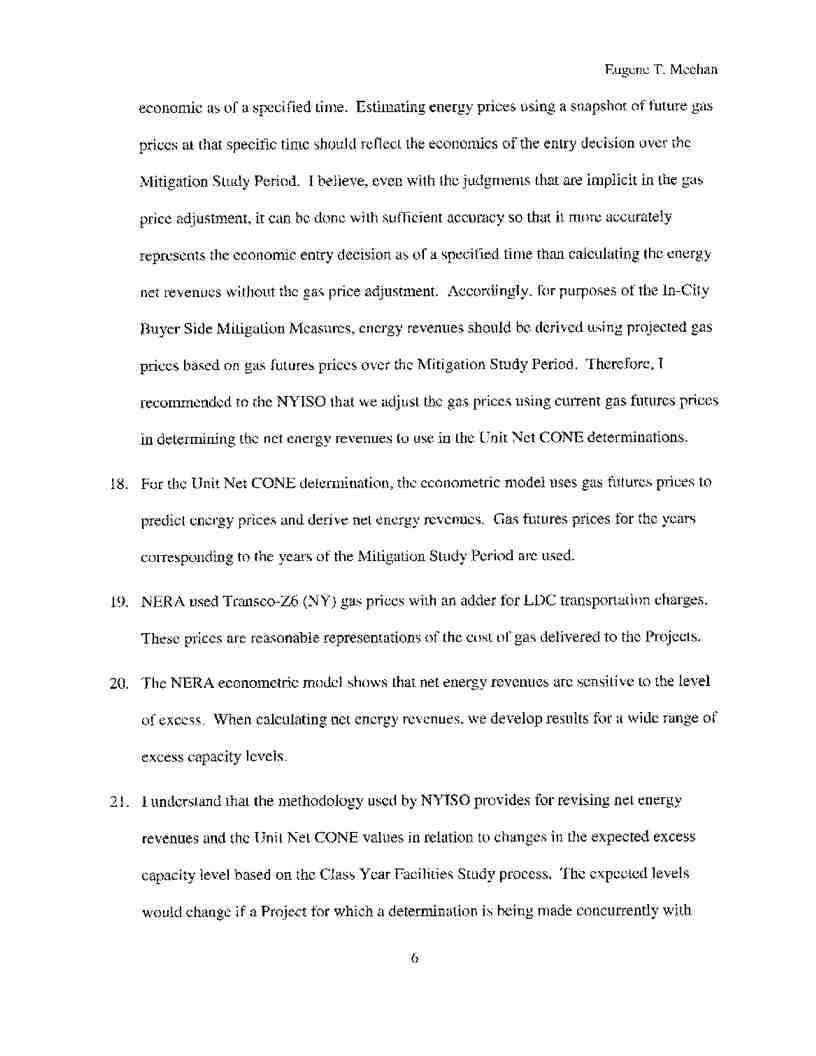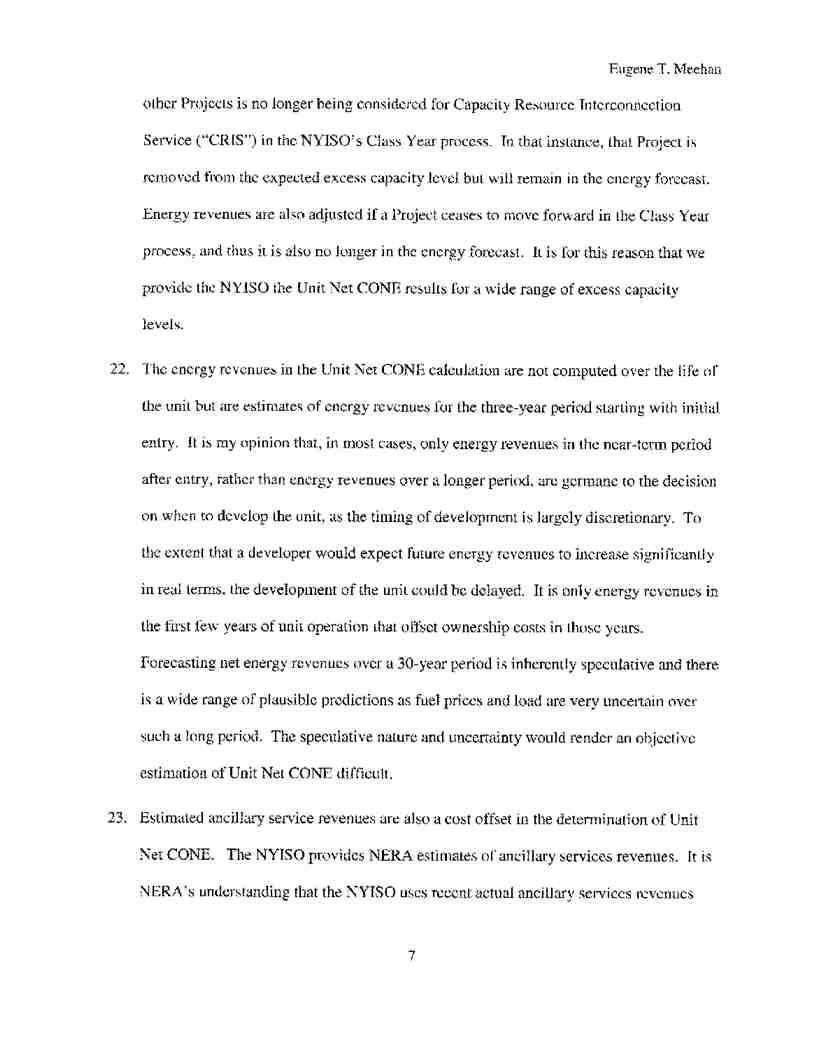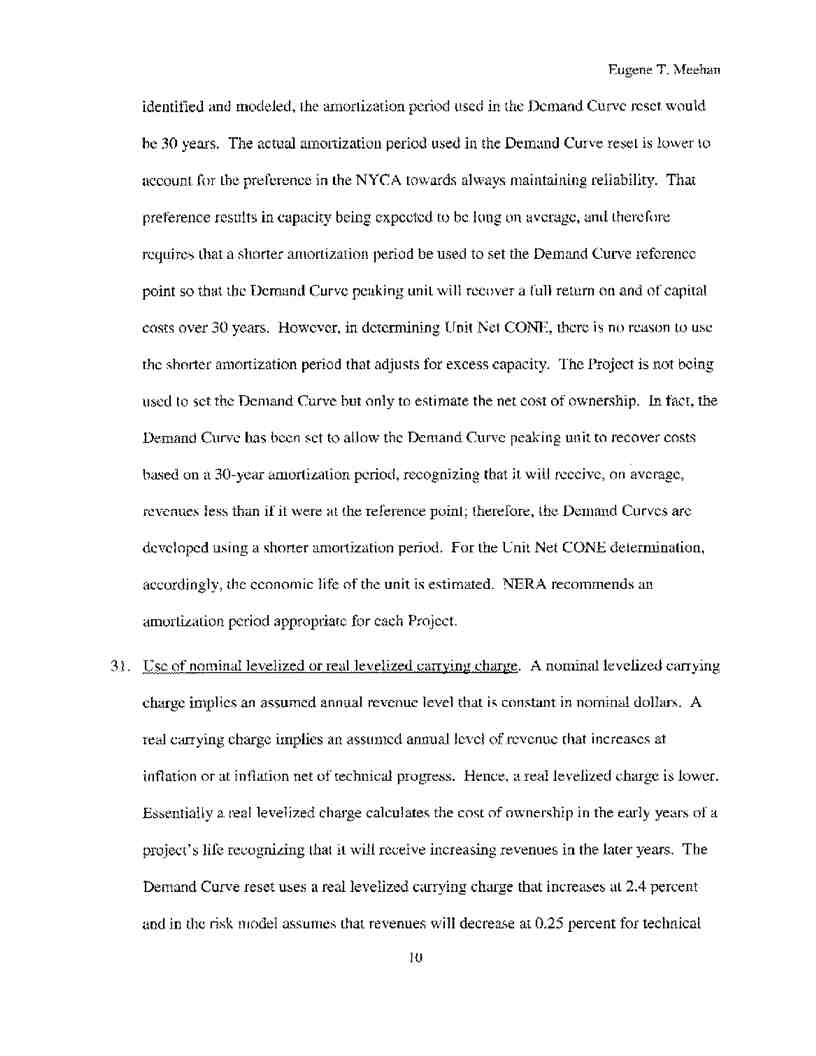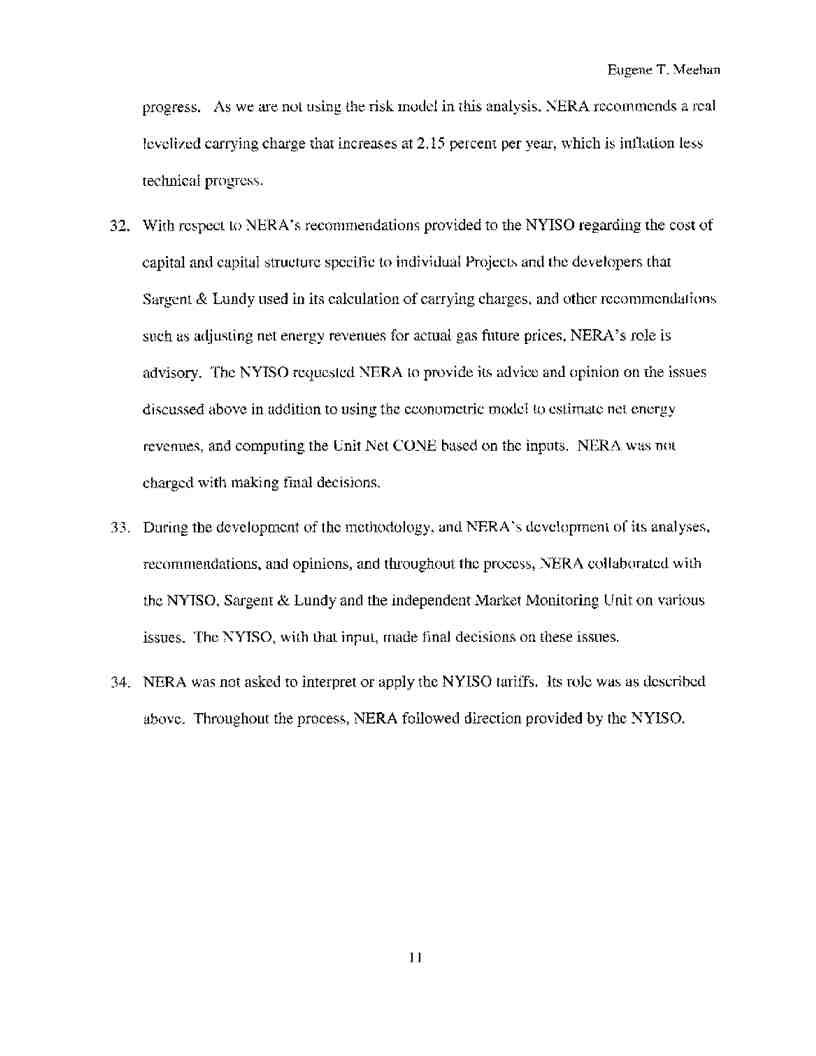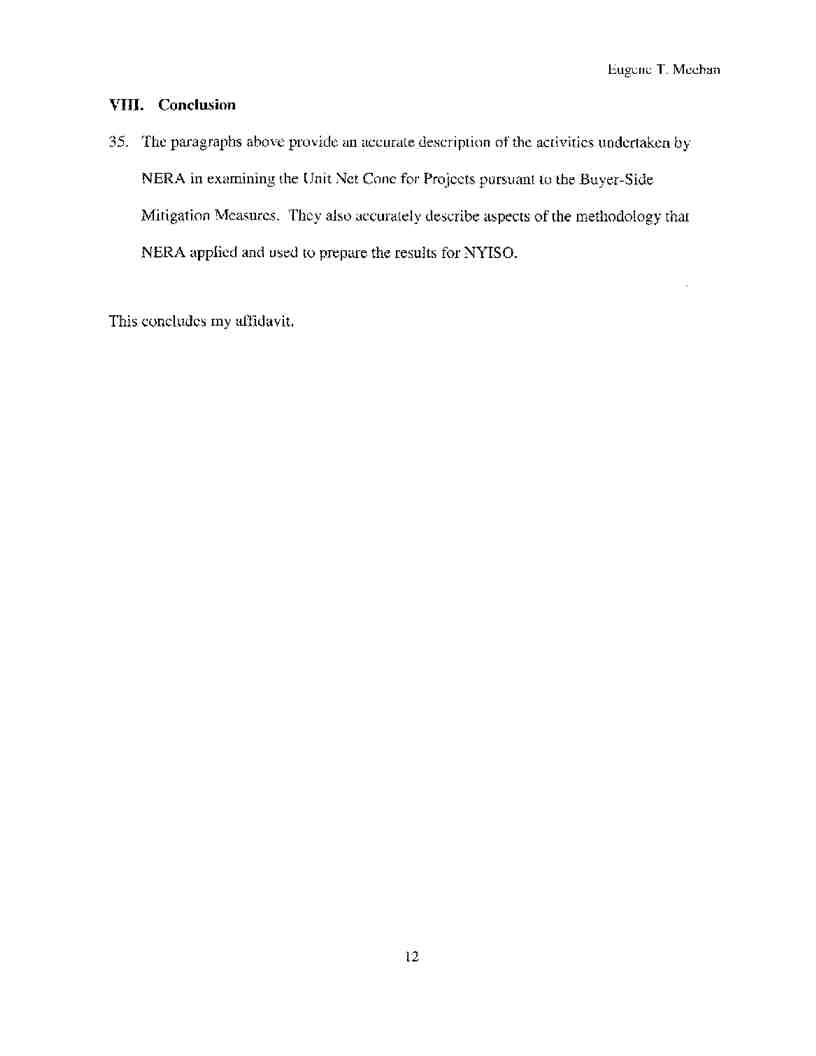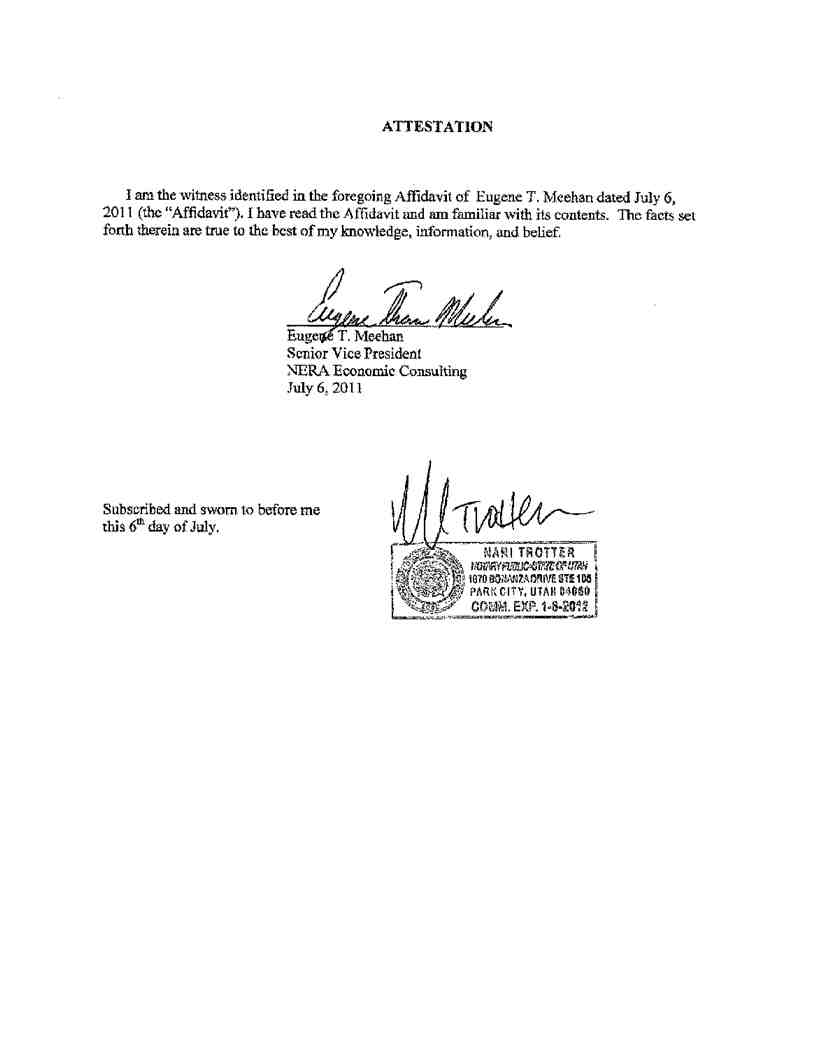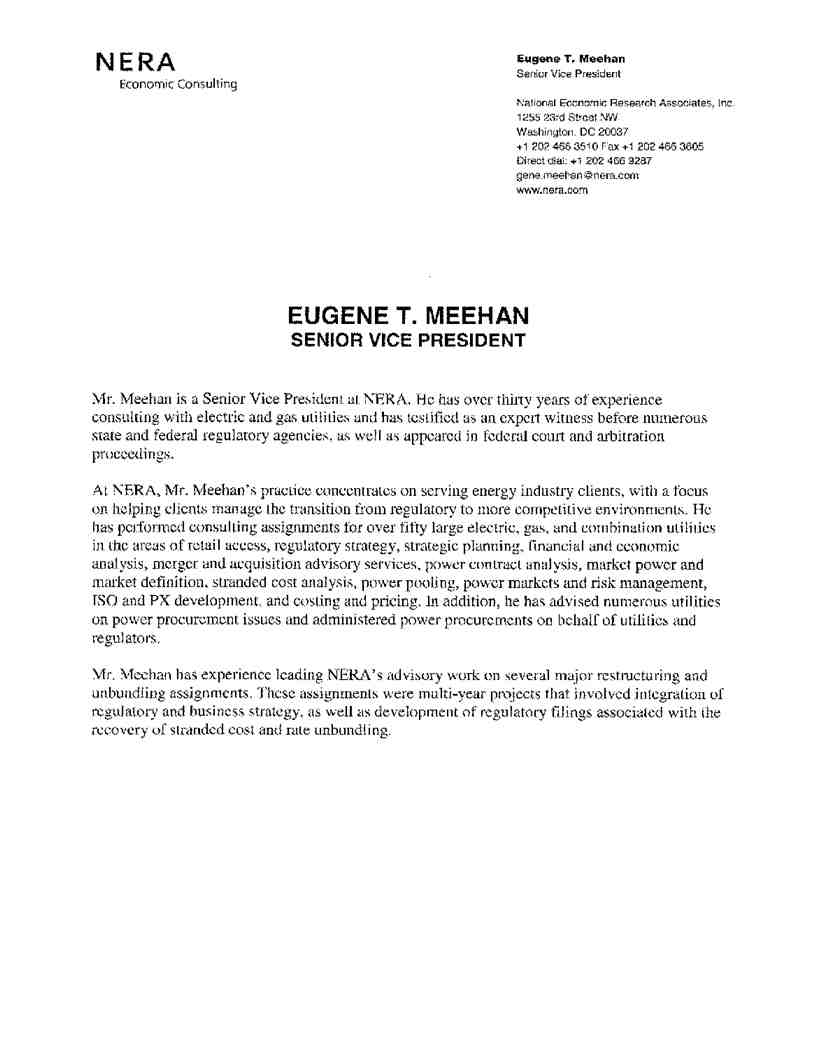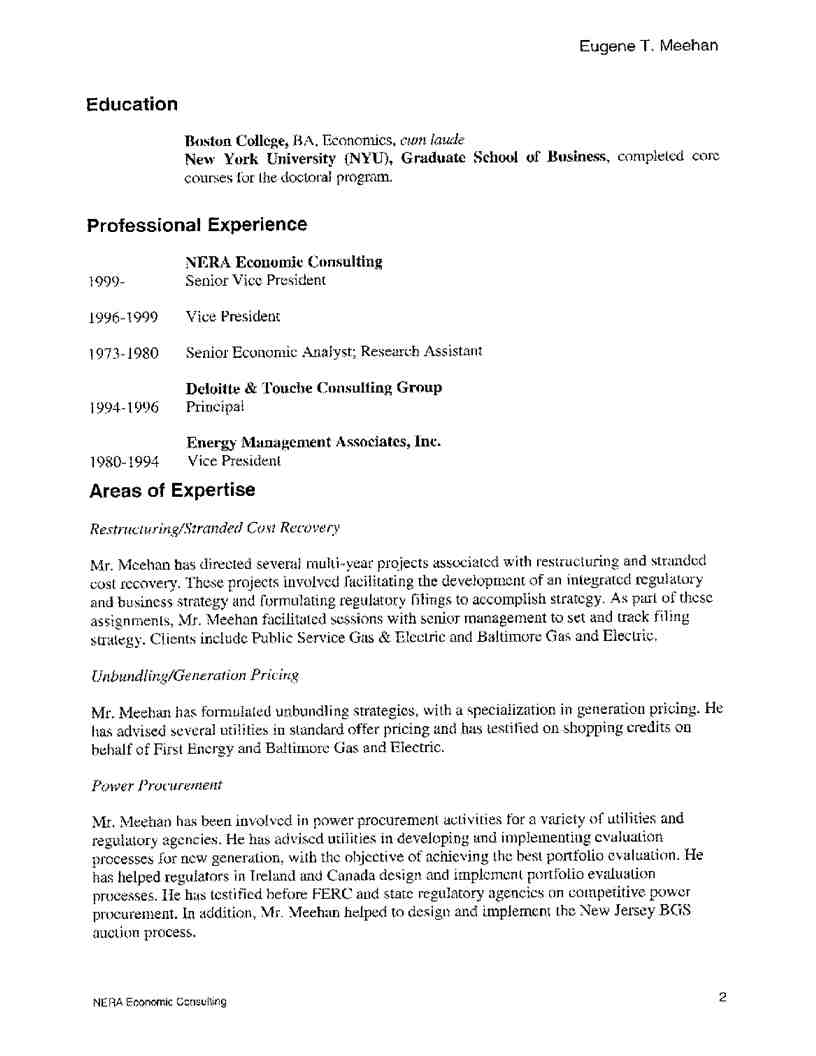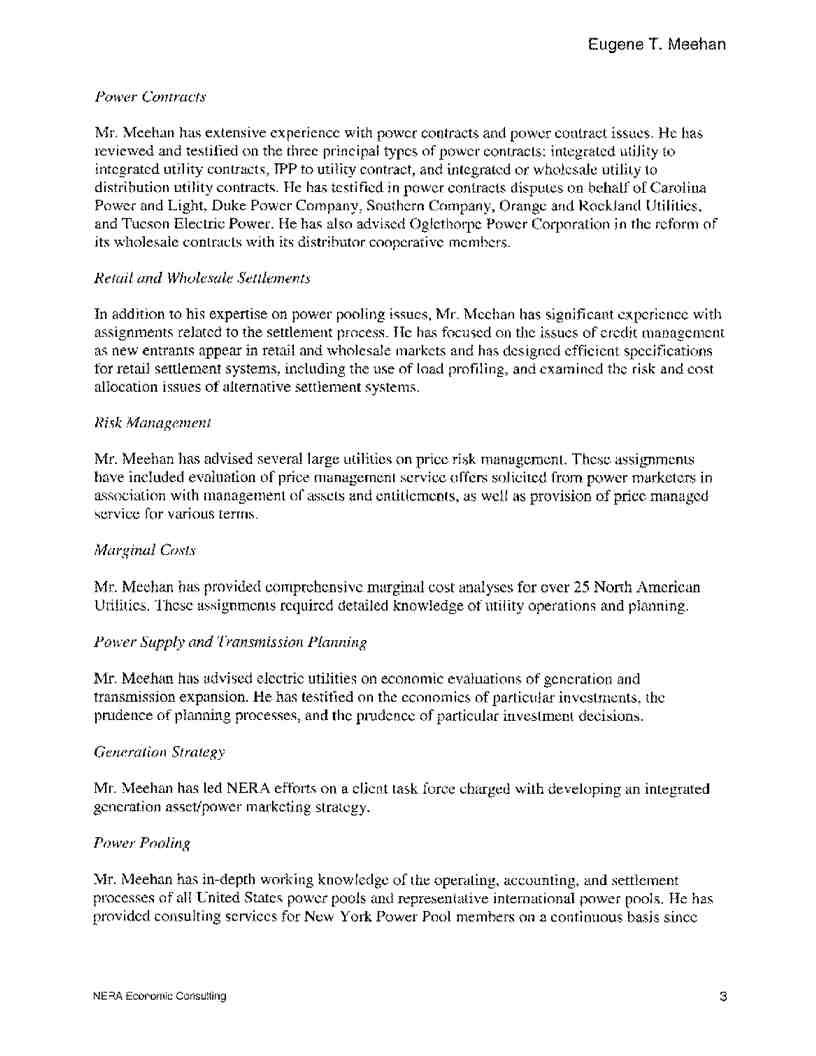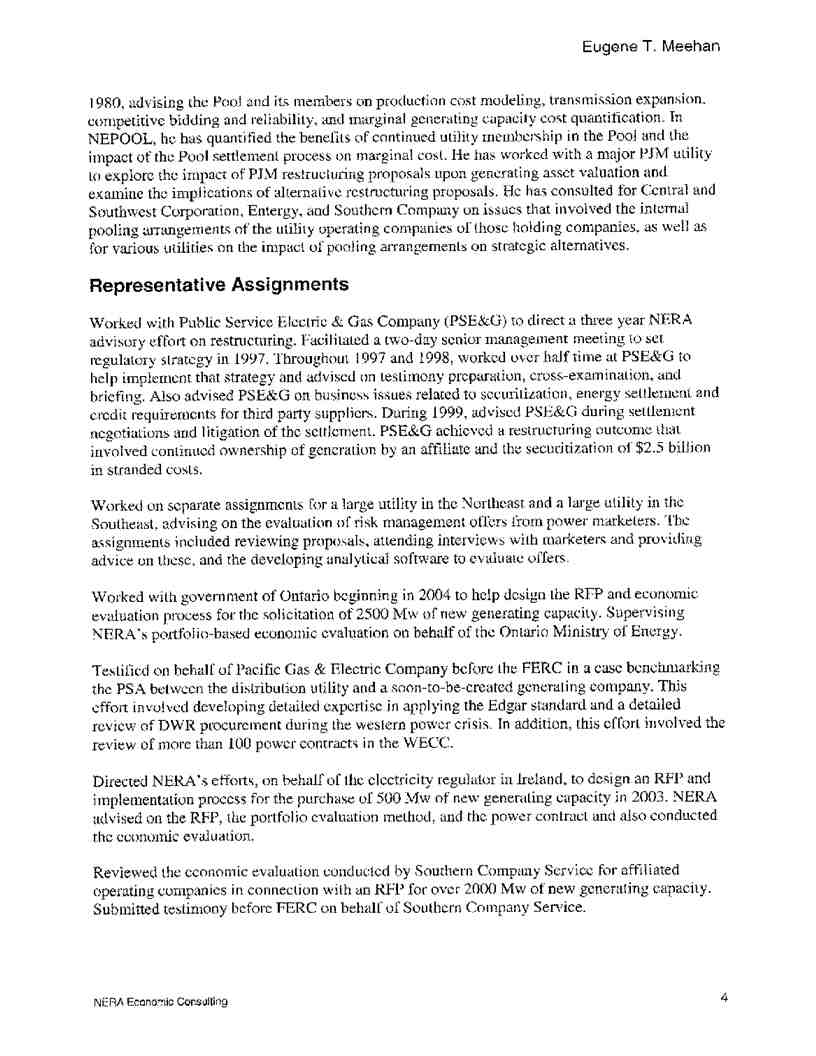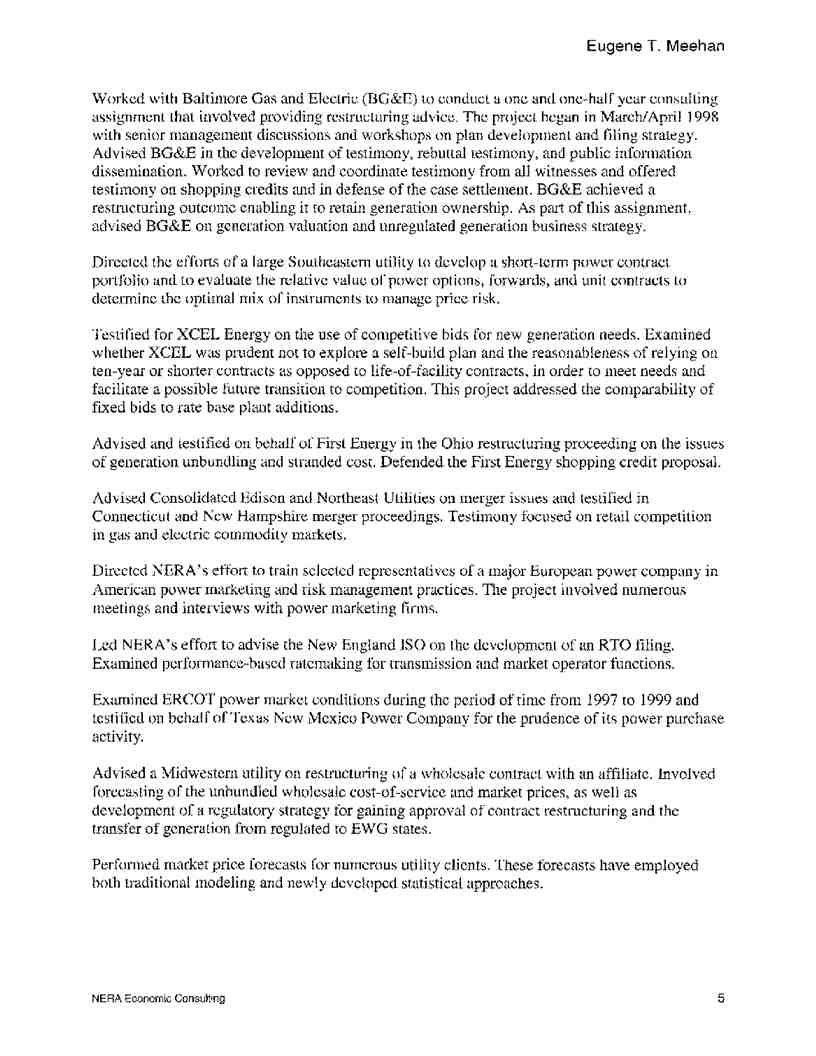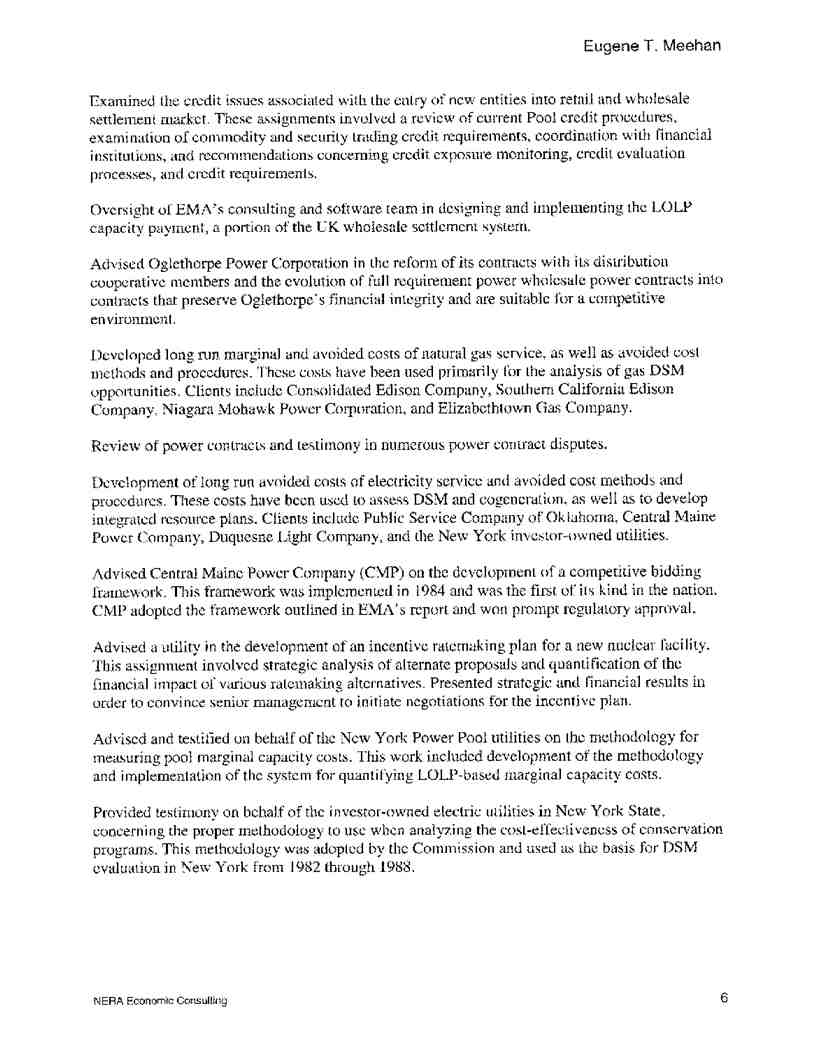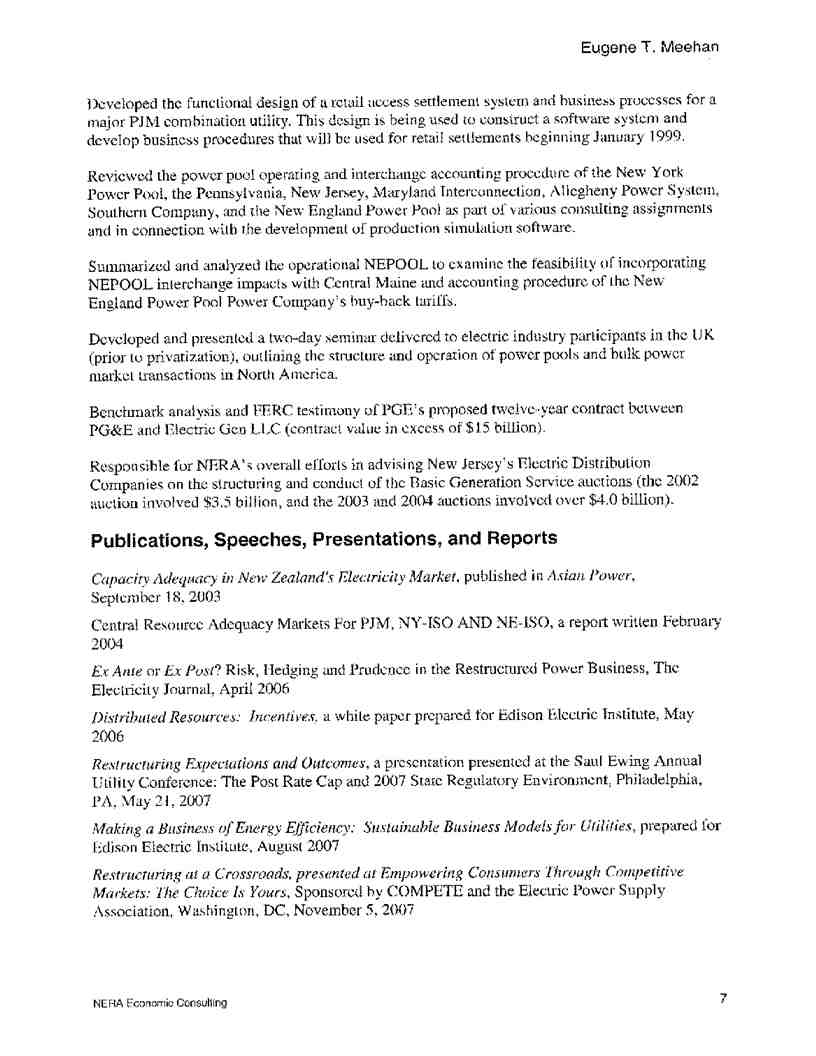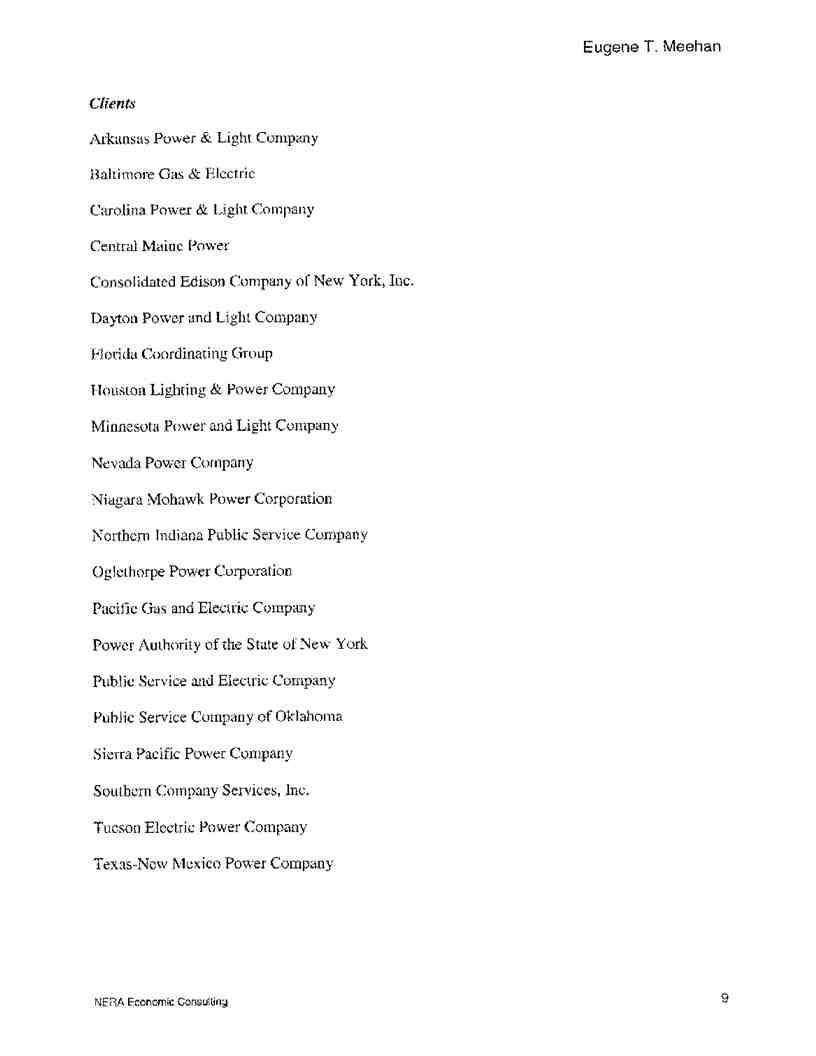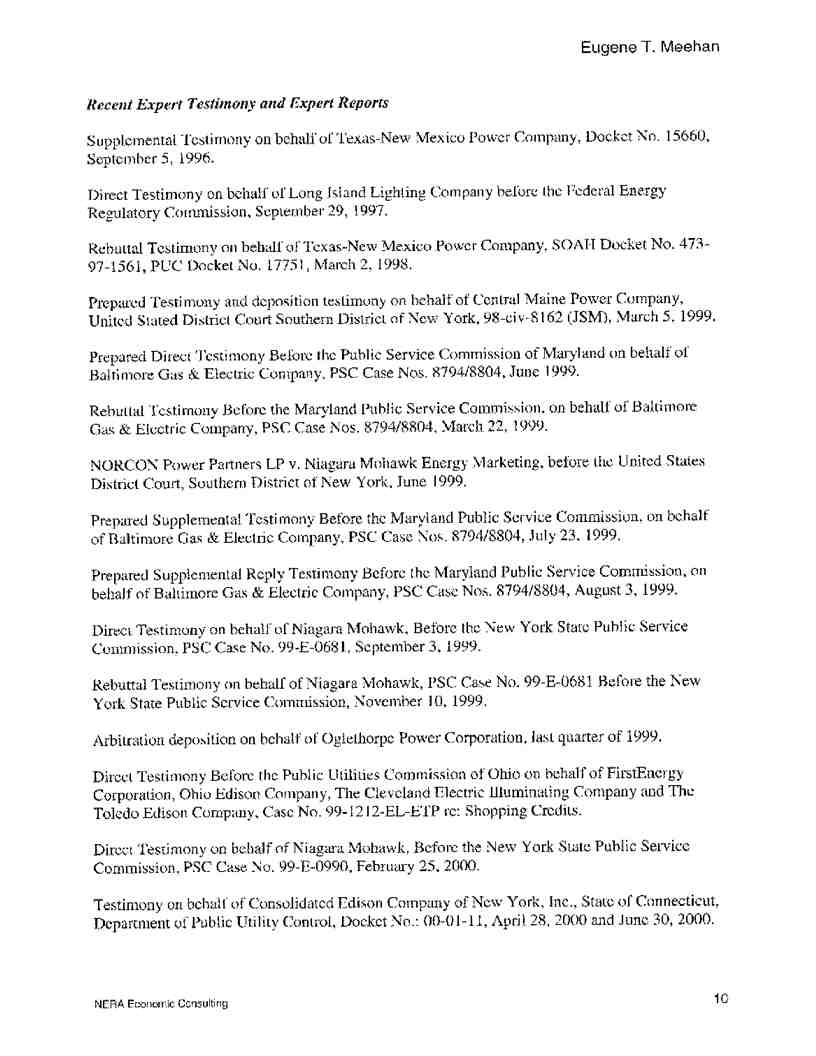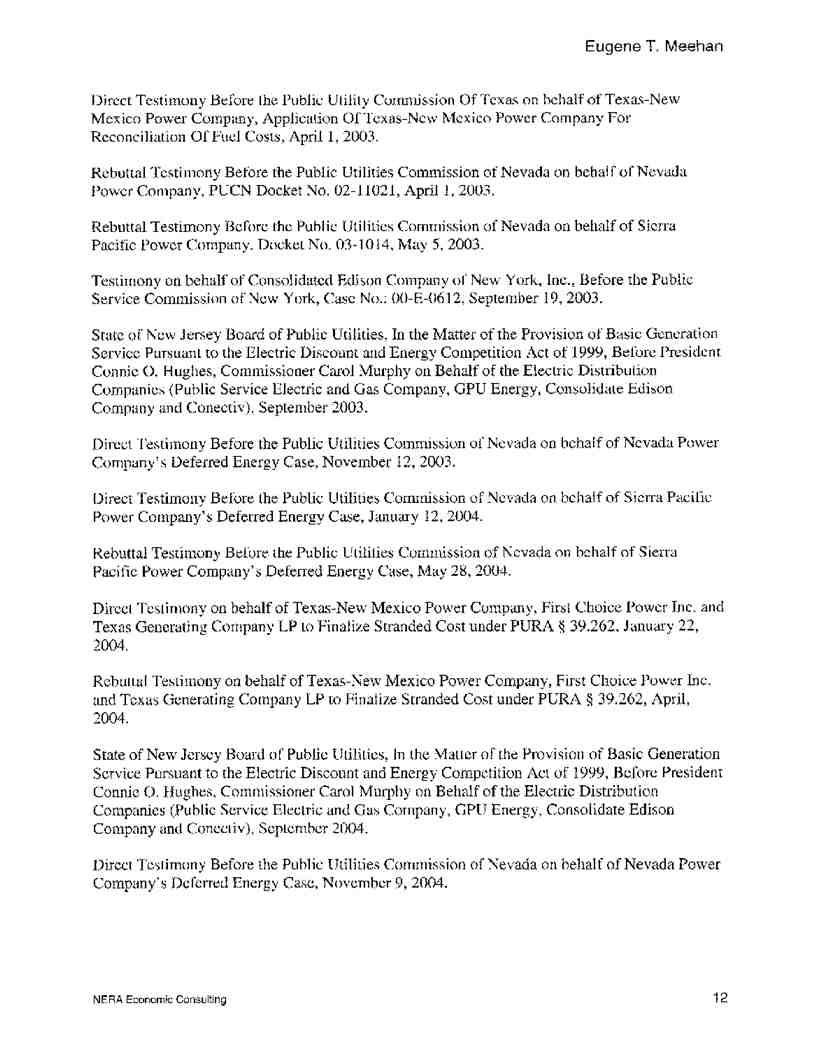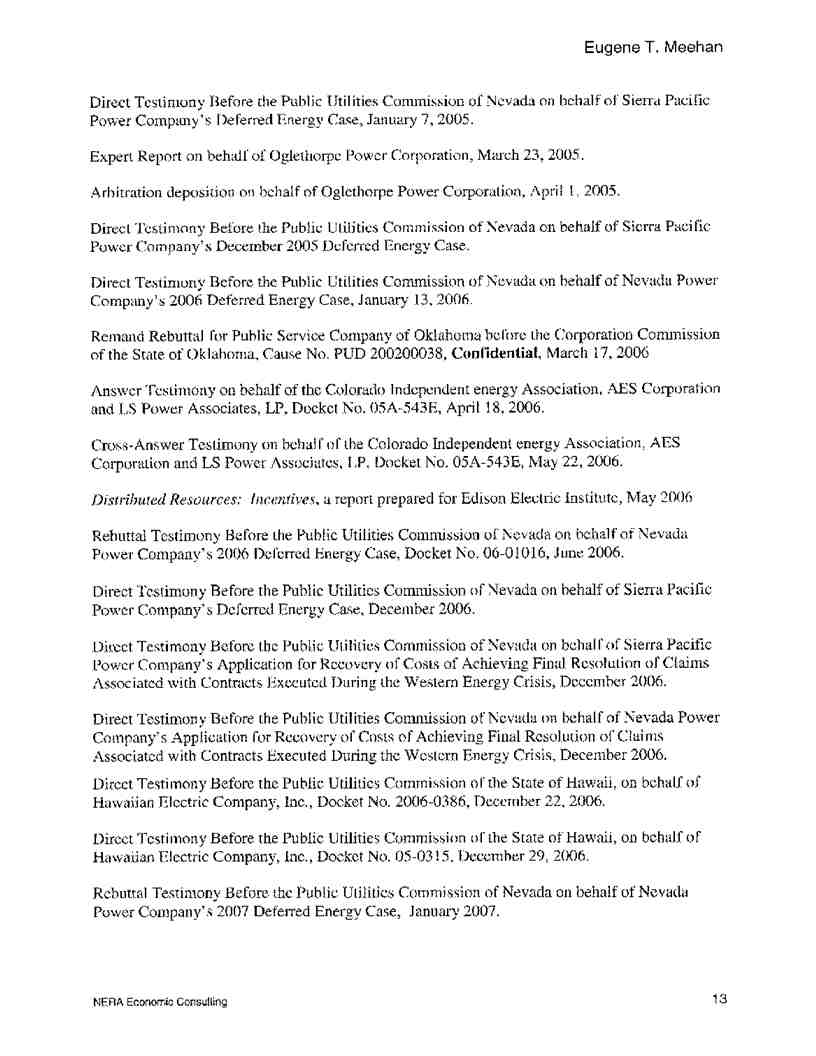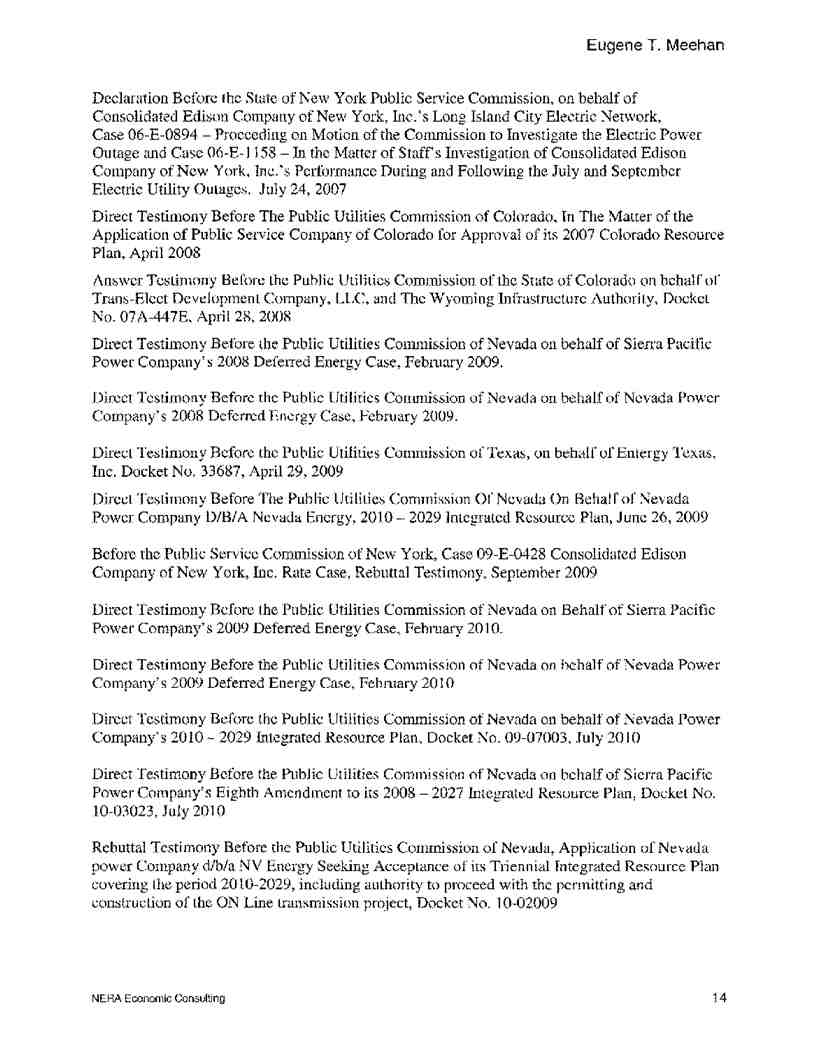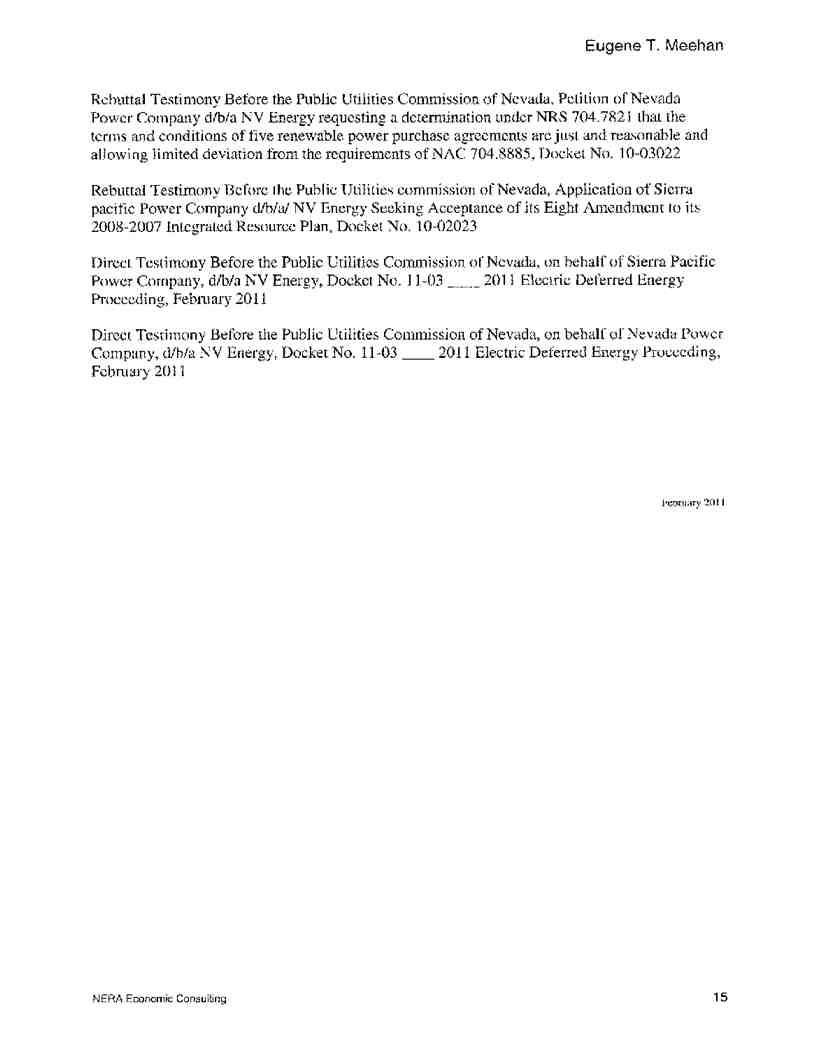HUNTON & WILLIAMS LLP
1900 K STREET, N.W.
WASHINGTON, D.C. 20006-1109
TEL202 • 955 • 1500
FAX202 • 778 • 2201
TED J. MURPHY
DIRECT DIAL: 202 • 955 • 1588
EMAIL: tmurphy@hunton.com
July 7, 2011FILE NO:
Honorable Kimberly D. Bose, Secretary Federal Energy Regulatory Commission 888 First Street, NE
Washington, DC 20426
Re: New York Independent System Operator, Inc., Errata to July 7, 2011
Answer in Docket No. EL11-42-000
Dear Secretary Bose:
On July 6, 2011, the New York Independent System Operator, Inc. (“NYISO”)
electronically submitted its Answer in the above-captioned proceeding. Two errors in that filing
have subsequently come to the NYISO’s attention. First, the affidavits of Joshua A. Boles and
Eugene T. Meehan, Attachments 2 and 3 to the Answer, were included when the NYISO
distributed the Answer to the service list on July 6, 2011, but were inadvertently omitted from
the electronic version of the Answer filed with the Commission. Second, Attachment 1 to the
Answer, i.e., the NYISO’s formal recitation of admissions, denials, and defenses under
Commission Rule 213(c)(2), was inadvertently omitted from both the electronically filed and
served copies of the Answer.
In order to correct these inadvertent omissions the NYISO is re-submitting and serving a complete version of the Answer. The complete version includes: (i) Attachment 1 to the
Answer; and (ii) copies of Attachments 2 and 3 to the Answer as they were distributed to the service list on July 6, 2011.
Respectfully submitted,
s/ Ted J. Murphy________________ Ted J. Murphy
Hunton & Williams, LLP
ATLANTA AUSTIN BANGKOK BEIJING BRUSSELS CHARLOTTE DALLAS HOUSTON LONDON LOS ANGELES
McLEAN MIAMI NEW YORK NORFOLK RALEIGH RICHMOND SAN FRANCISCO TOKYO WASHINGTON
www.hunton.com
CERTIFICATE OF SERVICE
I hereby certify that I have this day served the foregoing document upon each person designated on the official service list compiled by the Secretary in this proceeding in
accordance with the requirements of Rule 2010 of the Rules of Practice and Procedure, 18
C.F.R. § 385.2010.
Dated at Washington, DC this 7th day of July, 2011.
/s/ Ted J. Murphy
Ted J. Murphy
Hunton & Williams LLP 1900 K Street, NW
Washington, DC 20006-1109 (202) 955-1500
UNITED STATES OF AMERICA
BEFORE THE
FEDERAL ENERGY REGULATORY COMMISSION
Astoria Generating Company, L.P., NRG Power Marketing LLC, Arthur Kill Power LLC, Astoria Gas Turbine Power LLC,
Dunkirk Power LLC, Huntley Power LLC, Oswego Harbor Power LLC and TC
Ravenswood, LLC
Complainants,
vs.
New York Independent System Operator,
Inc.
Respondent.
)
)
)
)
)
)
)
)Docket No. EL11-42-000
)
)
)
)
)
)
)
ANSWER OF THE NEW YORK INDEPENDENT SYSTEM OPERATOR, INC.
Pursuant to Rule 213 of the Commission’s Rules of Practice and Procedure1 and the Commission’s June 30, 2011, Notice of Extension of Time the New York Independent System Operator, Inc. (“NYISO”) respectfully submits this answer to the June 3, 2011 Complaint Requesting Fast Track Processing (“Initial Complaint”) and the June 16 Amendment to
Complaint and Request for Shortened Comment Period (“Amended Complaint”) (collectively,
the “Complaint”) in this proceeding. As the NYISO explains in the sections that follow, the
Complaint must be denied because the Complainants2 have not met their burden of proof.
Complainants rely on little more than speculation and mischaracterization to support their
claims. They have not shown that they have suffered, or will suffer, any harm. The entire
1 18 C.F.R. § 385.213 (2011).
2 The Complainants are Astoria Generating Company, L.P., the NRG Companies, and TC
Ravenswood, LLC. These entities have participated in recent NYISO proceedings involving capacity market mitigation and ICAP Demand Curve issues as the “New York City Suppliers.”
1
Complaint makes only a single point that touches on a legitimate market design question, and even that relates to a new issue that is not yet ripe for consideration by the Commission. The Complaint includes many more arguments that are no longer ripe for consideration because they constitute impermissible collateral attacks on settled precedent.
The NYISO has complied, and will continue to comply in the future, with all applicable tariff requirements and Commission policies. Indeed, it is the Complainants that are seeking to force the NYISO to take actions that would violate both its tariff and Commission precedent. Similarly, although the Complainants wrongly accuse the NYISO of “cherry-picking” rules and inputs from pending compliance filings to use in its mitigation determinations, it is actually Complainants that selectively seek to implement tariff provisions that have not yet been
accepted, or that have been rejected, by the Commission.
There is no basis for adopting any of the tariff revisions that Complainants would impose
on the NYISO and all other stakeholders in contravention of the shared governance process for
submitting tariff revisions under Section 205 of the Federal Power Act (“FPA”). Complainants
have not shown that the NYISO’s existing tariff revisions are unjust or unreasonable, or that their
proposed vague changes would be just and reasonable as required under FPA Section 206.
There is also no justification for holding the NYISO’s Class Year3 Facilities Study
process in indefinite abeyance. Such a “remedy” would harm both project developers and the
markets without serving any legitimate purpose. As the NYISO has explained in its preliminary
3 Capitalized terms that are not otherwise defined herein shall have the meaning specified in the
NYISO’s Market Administration and Control Area Services Tariff (“Services Tariff”) and if not defined
therein, they shall have the meaning specified in the NYISO’s Open Access Transmission Tariff
(“OATT”).
2
answers in this proceeding,4 and reiterates below, Complainants’ repeated suggestions that such
an extraordinary Commission action is necessary to prevent irreparable harm to themselves or
the market are wrong. Complainants also have not justified the equally extraordinary step of
shifting market power mitigation responsibilities from the NYISO to the independent market
monitoring unit (“MMU”) in contravention of the NYISO tariff and Commission precedent.
Finally, the Complainants must not be permitted to usurp the roles of the NYISO and the
MMU in detecting and mitigating market power in the New York City (“In-City”) capacity
market. Allowing them to do so would create a real risk that economic new investments would
be discouraged.
I.EXECUTIVE SUMMARY
The Complaint must be denied because Complainants have not met their burden of proof under FPA Sections 206 and 306 or Commission Rule 206. Instead of presenting clear evidence of NYISO tariff violations that have resulted, or will result, in actual harm to them,
Complainants rely on incorrect and speculative assertions and assumptions, as well as
mischaracterizations of the Services Tariff and the NYISO’s own statements. Many of their
arguments must also fail because they are collateral attacks on earlier Commission orders.5 The critical flaws underlying Complainants’ various claims are summarized below and then refuted in detail in subsequent sections of this Answer.6
4
See Preliminary Answer of the New York Independent System Operator, Inc. (June 6, 2011) at
2-3, Answer to the Amendment to Complaint and Request for Shortened Comment Period (June 17, 2011)
at 2-3, Docket No. EL11-42-000.
5 See Section III.B below.
6 In addition, Attachment 1 to this Answer addresses the formal requirements of Commission Rule 213(c)(2) in order to ensure the NYISO’s compliance with them.
3
Complainants claim that the NYISO’s implementation of the “In-City Buyer Side
Mitigation Measures”7 is not governed by objective tariff criteria and lacks sufficient
transparency. The truth is that Attachment H to the Services Tariff includes detailed rules
governing each facet of the NYISO’s administration of the In-City Buyer Side Mitigation
Measures.8 The NYISO has provided market participants with more information regarding its
implementation of those rules than Attachment H and Commission policy require. At the same
time, it has appropriately limited access to information that, if shared publicly, would violate
tariff and Commission policy requirements that protect confidential information.9 The NYISO
affords similar protection for confidential information when it administers its supplier-side
capacity mitigation measures. Complainants have never objected to that treatment and have
provided no basis for weakening the protection of their competitors’ confidential information.
The NYISO has not cut-off further communication with market participants regarding its
administration of the In-City Buyer Side Mitigation Measures. To the contrary, the NYISO has
told stakeholders that it intends to continue the discussion on a number of issues, including two
that receive considerable attention in the Complaint. The NYISO told stakeholders, prior to the
Complainants’ filing, that it was evaluating the question of whether Offer Floors, once
determined, should escalate, and would follow up on that question with stakeholders.10 The
Complaint obfuscates this issue unnecessarily by incorrectly asserting that the NYISO does not
7 The NYISO uses “In-City Buyer Side Mitigation Measures” to refer to the currently-effective buyer-side capacity market mitigation provisions in Attachment H to its Services Tariff, including those that were accepted by the Commission in its series of orders in Docket ER10-3043.
8 See Sections III.C.1.a.i and iii below.
9 See Sections III.C.1.a.ii and iii below.
10 See Sections II.D and III.C.5.b below.
4
account for inflation when calculating the Offer Floor. In fact, the NYISO does.11 In any event,
the NYISO’s view is that providing for the escalation of Offer Floors after they are determined,
could improve the In-City Buyer Side Mitigation Measures. The Services Tariff, however,
currently does not authorize escalation of an established Offer Floor, specify the escalation rate,
or provide any other guidance as to how escalation should be performed. The NYISO believes
that the necessary design elements should and can be developed through a process that considers
stakeholder input.12
Similarly, the NYISO told stakeholders, prior to the Complainants’ filing, that it intends
to provide a numerical example to demonstrate how the buyer-side Offer Floor is calculated.
The NYISO disagrees with certain aspects of the “benchmarking analysis” that Complainants
assert the NYISO must be compelled to undertake, including their notion that it must be done
before the In-City Buyer Side Mitigation Measures are implemented. Nevertheless, the NYISO
is striving to provide stakeholders with a useful illustration in response to Complainants’ May
2011 request for an analysis. The NYISO intends to do so as soon as reasonably practicable
given the limitations on its resources.13
Complainants assert that greater transparency is needed so that they may review the
NYISO’s implementation of the In-City Buyer Side Mitigation Measures in order to ensure that
the NYISO has complied with its tariff. The role that Complainants envision for themselves is
neither necessary nor appropriate. It is unnecessary because Potomac Economics, Ltd., the
independent MMU for the NYISO, already works closely with the NYISO and assists it in its
implementation of the In-City Buyer Side Mitigation Measures, to the extent permitted by
11 See Section III.C.2 below.
12 See Section III.C.5.b below.
13 See Section II.D below.
5
Commission Order No. 719 and the Services Tariff. If the NYISO were to fail to follow its tariff, the MMU is responsible for referring the matter to the Commission.14 The MMU has authorized the NYISO to state that it has not, to date, identified any tariff compliance concerns with respect to the NYISO's implementation of the In-City Buyer Side Mitigation Measures. Complainants are therefore in effect arguing that the Commission must allow them to second guess both the NYISO’s and the MMU’s determinations.
Complainants’ proposal to appoint themselves as de facto market monitors is also
inappropriate because they lack the independence to be entrusted with market monitoring and
market power mitigation responsibilities. As owners of substantial In-City generating resources,
Complainants have a clear economic incentive to try to discourage new entry that might compete
with them, regardless of whether that entry would be economic. Providing greater
“transparency” in order to enable Complainants to play a larger role in the market monitoring
function, would thus likely discourage new entry, not encourage it as they claim.15
Complainants also accuse the NYISO of “cherry-picking” the rules and inputs used under the In-City Buyer Side Mitigation Measures. Their assertion is exactly backwards. The NYISO is following the Services Tariff’s requirements. Where Commission-accepted tariff language directs the NYISO to use “currently effective” values, that is what the NYISO does. 16
Conversely, where Commission-accepted language requires the use of “reasonably anticipated”
values, the NYISO will use them.17 It is Complainants that would have the NYISO ignore its
14 See Section II.C and below
15 See Section III.C.4.a below
16 See Section III.C.4.a below
17 See Section III.C.4.b below
6
tariff and use not yet accepted ICAP Demand Curve values that would favor their own financial interests.
Complainants fail to demonstrate that the market, or they themselves, would actually be
harmed even if the NYISO were to make the implementation errors that they allege (which the
NYISO does not concede.) Even if one were to accept all of the Complaints’ claims, the
combined impacts of the NYISO’s supposed “errors” would not harm either Complainant that
has disclosed that it has a project that is currently being examined under the In-City Buyer Side
Mitigation Measures.
Complainants have failed to show that the NYISO’s practices are in any way inconsistent with the Services Tariff or Commission policy. They have presented no evidence demonstrating that the tariff is not just and reasonable. They have only offered general concepts for alternative tariff provisions, and they have not even demonstrated that those concepts are just and
reasonable. They have therefore not met the “dual burden” of proof to justify tariff revisions
under Section 206 of the FPA. The mere fact that a NYISO determination results in lower
revenues for Complainants, or in new capacity resources clearing the market before those owned by Complainants, does not mean that the determination is an “error,” a tariff violation, or a
justification for revising the Services Tariff.
Complainants also have not presented any evidence that would justify granting the other
forms of extraordinary relief that they seek. For example, they have not demonstrated that there
is any need to hold the NYISO’s Class Year Facilities Study process in abeyance.18 They have
not even acknowledged the harm that this “remedy” would cause. Similarly, they have fallen far
short of justifying the extraordinary measures of: (i) transferring the responsibility for mitigation
18 See Section III.E below.
7
functions that the NYISO is responsible for performing under its tariff to the MMU;19 or (ii)
overriding the MMU’s discretion to determine what issues warrant its attention and how it
should use its resources. Their requests also would violate the existing Services Tariff.
In short, Complainants have not met their burden of proof and have failed to show that
the NYISO: (i) is calculating Unit Net CONE in a manner that is inconsistent with the Services Tariff or Commission precedent;20 (ii) is impermissibly making mitigation determinations using “outdated” ICAP Demand Curve and Mitigation Net CONE (or Net CONE) data;21 (iii) “does
not plan to adjust Offer Floors;”22 (iv) has erred to the extent that it has not followed PJM’s
example of using the exact same assumptions for ICAP Demand Curve and mitigation
purposes;23 or (v) would fail to review contracts that are necessary for it to make reasonable
Unit Net CONE determinations.24
Accordingly, there is no basis for the Commission to: (i) require the NYISO to “correct”
supposed “flaws” in its implementation of the In-City Buyer Side Mitigation Measures or to
“clarify” the tariff in order to make such “corrections;”25 (ii) direct the NYISO to file tariff
revisions “clarifying” how the mitigation and Offer Floor determinations are made in order to
establish more objective tariff criteria or greater transparency;26 (iii) order the NYISO to file a
“benchmarking analysis;”27 (iv) compel the MMU to file a report regarding the NYISO’s
19 See Section III.G below.
20 See Section III.C.2 below.
21 See Section III.C.4 below.
22 See Section III.C.2 below.
23 See Section III.C.3 below.
24 See Section III.C.6 below
25 See Sections III.B,C and D below.
26 See Section III.C.1 below.
27 See Sections II.D and III.C.1.b below.
8
implementation of the In-City Buyer Side Mitigation Measures;28 or (v) “consider” whether the MMU should implement the In-City Buyer Side Mitigation Measures in the future.29 Instead, the Commission should deny the Complaint in its entirety.
II.BACKGROUND
A.Overview of the In-City Buyer Side Mitigation Measures
The In-City capacity markets are organized around a series of NYISO-administered
ICAP auctions. Because the In-City capacity market has traditionally been highly concentrated, it has been subject to market power mitigation measures since the NYISO’s inception in 1999.30 The current capacity mitigation regime was developed through multiple rounds of proceedings before the Commission31 beginning in 2007, and went into effect in 2008. The mitigation
measures include an ICAP Spot Market Auction offer cap and a must-offer provision to mitigate withholding by Pivotal Suppliers of ICAP. The In-City ICAP mitigation measures also include a set of buyer-side mitigation measures which are designed to guard against the exercise of buyerside market power in the In-City ICAP markets.32
28 See Section III.G below.
29 See Section III.G below.
30
See Consol. Edison Co. of New York, Inc., 84 FERC ¶ 61,287 (1998) (accepting a $105/kW-
year offer and revenue cap on ICAP sales by New York City generators divested by Consolidated Edison
Company of New York, Inc.)
31
The existing mitigation structure was most recently addressed by the Commission in its May
2010 Order, New York Independent System Operator, Inc., 131 FERC ¶ 61,170 (2010), and in its
subsequent orders addressing the NYISO’s proposed enhancements to the In-City Buyer Side Mitigation
Measures, New York Independent System Operator, Inc., 133 FERC ¶ 61,178 (2010) (November 2010
Order); New York Independent System Operator, Inc., 134 FERC ¶ 61,083 (2011); New York
Independent System Operator, Inc., Letter Order, Docket No. ER10-3043-003 (March 17, 2011).
32 Id. at P 2.
9
Unless exempt from the buyer-side mitigation measures, ICAP Suppliers (other than
Special Case Resources (“SCRs”))33 that enter the In-City Capacity market are required to offer
UCAP into the ICAP Spot Market Auctions and must do so at a price no lower than the Offer
Floor. An ICAP’s Supplier’s Offer Floor is set at the lower of Unit Net CONE or 75% of
Mitigation Net CONE.34 To prevent circumvention of the Offer Floor, capacity that is subject to
an Offer Floor can only be offered into the ICAP Spot Market Auction;35 it cannot be certified
towards bilateral capacity transactions or sales in a Capability Period or Monthly Auction. The
Offer Floor is thus a deterrent to uneconomic entry because an Installed Capacity Supplier that is
subject to it would only receive capacity revenue in months when its Offer Floor was below the
ICAP Spot Market Auction Market-Clearing Price. A new Installed Capacity market entrant is
exempt from the Offer Floor if it passes the NYISO’s mitigation exemption tests set forth in
Services Tariff Attachment H.
B. Recent Enhancements to the In-City Buyer Side Mitigation Measures
33
The Complaint, with the sole exception of the Affidavit of William Hieronymus (“Hieronymus
Affidavit”) does not raise issues regarding mitigation measures applicable to Special Case Resources
(”SCRs”) or the NYISO’s implementation thereof. Nor does it appear to propose to modify existing, or
propose new, provisions applicable to SCRs. Accordingly, references herein to Installed Capacity
Suppliers, the mitigation of capacity suppliers, and similar terms do not refer to SCRs. However, should
Complainants argue, or the Commission consider Complainants’ statement regarding SCRs, through Mr.
Hieronymus, to be at issue in this proceeding, the NYISO denies any such claim and wiould respectfully
seek to supplement this Answer. See Hieronymus Affidavit at 13 (referring to “the substantial amount of
demand-side capacity and capacity bids from renewable resources that may be subsidized or compelled to
be built for public policy reasons.”)
34 The NYISO proposed to add “Mitigation Net CONE” to the definition section of Attachment H in its compliance with the Commission’s May 20, 2010 order, New York Independent System Operator, Inc., 131 FERC ¶ 61,170 (2010) (“May 2010 Order”). See New York Independent System Operator,
Inc., Compliance Filing, Docket No. ER10-2210-000, et al (August 12, 2010) (“August 2010 Compliance Filing”). The August 2010 Compliance Filing is currently pending before the Commission; however, the Commission has already accepted the use of the term “Mitigation Net CONE” in Attachment H. See
Services Tariff Attachment H Section 23.4.5.7.3.2.
35 See Attachment H, Section 23.4.5.7.1. The Services Tariff provides that an Installed Capacity Supplier subject to an Offer Floor shall cease to be subject to it for that portion of its UCAP that has cleared for any twelve, not-necessarily consecutive, months (the “Duration Rule”). See Services Tariff Attachment H Section 23.4.5.7.
10
Prompted by its experience implementing the In-City buyer-side mitigation measures,
and by stakeholder comments, the NYISO began exploring possible improvements to the
measures in 2009. The effort became more focused after the MMU issued its 2009 State of the
Market Report36 in April 2010. That report concluded that the In-City supply-side mitigation
measures appeared to be working well but that it was too early to evaluate whether the buyer-
side Offer Floor had been effective. The MMU noted that it had reviewed the “detailed
thresholds and testing procedures used to implement the offer floor” and recommended that the
NYISO review “the thresholds and procedures used to implement the offer floor, and identify
those that may: cause uneconomic entry to be exempted from the floor; or erect an inefficient
barrier to economic entry.”37
Subsequently, in May 2010, the NYISO proposed a number of improvements to the In-
City buyer-side mitigation measures for stakeholders to consider.38 Over the course of several
months, and six stakeholder meetings, the NYISO’s preliminary suggestions evolved into
proposed tariff enhancements that were approved in its stakeholder process and filed under
Section 205 of the FPA on September 27, 2010.39 Notwithstanding Complainants’ suggestions
36 See Potomac Economics, LLC, April 2010. 2009 State of the Market Report. Available at:
http://www.nyiso.com/public/webdocs/documents/market_advisor_reports/2009/2009_NYISO_SOM_Fina
l_4-30-2010.pdf.
37 Id. at 180.
38 By contrast, the NYISO did not propose any changes to its supplier-side capacity mitigation rules, in part because the MMU did not recommend any such changes.
39
See Proposed Enhancements to In-City Buyer-Side Capacity Mitigation Measures, Request for
Expedited Commission Action, and Contingent Request for Waiver of Prior Notice Requirement, Docket
No. ER10-3043-000 (September 27, 2010) (“September Filing”) The September Filing was clear that
“any exemption or Offer Floor determinations” under the version of Attachment H effective prior to the
effectiveness of the revisions that it proposed “would not be altered or affected by the amendments
proposed in this filing.” See September Filing at 14. See also, Request for Leave to Answer and Answer
of the New York Independent System Operator, Inc., filed November 1, 2010 (“November Answer”) at 14,
n. 39, Docket No. ER10-3043-000.
11
to the contrary,40 the enhancements were carefully designed to “increase transparency to all
Market Participants, provide potential new entrants with greater certainty at the time that they must make critical investment decisions, and prevent new entrants from facing either under- or over-mitigation while protecting the market from the consequences of both.”41 With the single exception of the proposed duration for which a mitigated Installed Capacity Supplier would be subject to the Offer Floor, the MMU supported the NYISO’s entire package of proposed
enhancements finding that they “improved clarity to how the various tests will be applied and how the mitigation will be implemented.”42
On November 26, 2010, the Commission issued an order that generally accepted the
NYISO’s proposed tariff enhancements, subject to conditions.43 Contrary to Complainants’
mischaracterizations, the November 2010 Order was not a rebuke to what they depict as a
NYISO attempt to “significantly cut short the duration of the Offer Floor” in order to “water
down” the In-City buyer-side mitigation measures.44 In reality, the Commission rejected one
component of the NYISO’s proposed enhancements to the Offer Floor duration rule45 (the
40
See Initial Complaint at 22-23.; Younger Affidavit at 9-12, 30-31.
41
See September Filing at 1.
42
See Motion to Intervene and Comments of the New York ISO’s Market Monitoring Unit filed
October 22, 2010, Docket No. EL10-3043-000, at 2. Complainants are therefore at best disingenuous
when they state that the September 27 Filing was made “over the objections of .the MMU... ” See
Initial Complaint at 15.
43
See November 2010 Order at PP 49-52, 71-74. The aspects of the proposed tariff
enhancements that the November 2010 Order required the NYISO to revise or further justify are not the
subject of the Complaint: e.g., the rules governing the duration of mitigation and the application of the previously effective “reasonably anticipated entry date rule” when examining a project in a Class Year prior to 2009 for which a mitigation determination had not yet been issued.
44 Initial Complaint at 15. Indeed, the NYISO proposed, over the objections of load interests, to maintain a then-existing tariff rule establishing a three year minimum Offer Floor duration. That
proposal, which is hardly consistent with Complainants’ misleading depiction of the NYISO’s purpose, was rejected by the November 2010 Order. See November 2010 Order at P 51.
45 See Services Tariff Attachment H Section 23.4.5.7.
12
“Duration Rule”) because it concluded that an alternative to the NYISO-proposed rule would, with one modification, be superior.46 Complainants’ objections to other NYISO-proposed
enhancements were generally rejected and the NYISO’s objective of fostering greater
transparency, certainty, and consistency with other rules was satisfied. Complainants submitted a request for rehearing of the November 2010 Order, which is still pending, but which raised
only relatively narrow issues.47
When it made the September Filing, the NYISO indicated that action on identified
additional potential enhancements to the In-City Buyer Side Mitigation Measures was being
deferred to allow more time for further stakeholder consideration, in some cases as a result of
stakeholder votes48 expressly asking the NYISO to do so, and in others, as a result of NYISO
46
See November 30 Order at P 48 (“Under the current rules, mitigation will be lifted after the
later of when the capacity surplus (included that created by the new entry) is expected to be absorbed
(based on historical load growth) or three years. NYISO proposes to maintain this approach in its first
methodology option in its proposed Services Tariff section 23.4.5.7(a), but proposes to use forecasted
instead of historical load growth in the determination... We find that, although the capacity absorption
concept that we previously accepted conceptually is a reasonable one for determining when new resources
are likely to become economic, actually observing that the new capacity is accepted in the market at a
price approximating its cost of entry, as reflected in NYISO’s second duration methodology in proposed
section 23.4.5.7(c) discussed below, is not subject to the ambiguities and complexities inherent in a
method that relies on forecasts of load growth and other factors to estimate when the absorption of surplus
capacity has occurred. Therefore, we reject the first offer floor duration methodology in proposed section
23.4.5.7(a).”)
47
See Request for Clarification or in the Alternative Rehearing of the New York City Suppliers,
Docket No. ER10-3043-002 (December 22, 2010) (seeking clarification or rehearing with respect to the
timing of exemption testing.)
48
The NYISO’s stakeholder Business Issues Committee voted to hold additional discussions
regarding the appropriate treatment of facilities that are “repowered” or that uprate their Capacity. See
<http://www.nyiso.com/public/webdocs/committees/bic/meeting_materials/2010-08-
04/Final_Motions_revised.pdf> (Motions 4 and 4A). The stakeholder Management Committee likewise
voted for additional discussions regarding the timing and manner of Offer Floor determinations for a
facility initially found to be only partially deliverable (and therefore initially permitted to sell only the
deliverable portion of its Capacity) that subsequently seeks permission to sell additional capacity. See
<http://www.nyiso.com/public/webdocs/committees/mc/meeting_materials/2010-08-
25/082510_final_Motions.pdf> (Motion 5).
13
Board of Directors’ decision.49 As with any other tariff revision proposal, the NYISO will
present it first to stakeholders for their review and vetting at ICAP Working Group meetings, and if there is support for a proposal, present it for a vote in the NYISO’s stakeholder process.
C. The NYISO’s Administration of the In-City Buyer-Side Mitigation Measures
The NYISO diligently fulfills its market monitoring and mitigation responsibilities,
including those regarding the In-City Buyer-Side Mitigation Measures. The NYISO recognizes
the necessity of both supply-side and buyer side mitigation rules and is not an “enthusiastic
proponent”50 of one relative to the other. There is no evidence or precedent suggesting that the
NYISO is more diligent-, or aggressive in its implementation of supplier-side measures. As
noted above, the NYISO proposed enhancements to the buyer-side measures, but not its supplier-
side capacity mitigation rules, because there was a clear basis for improving the former but not
the latter. Further, when the Commission asked the NYISO to evaluate the narrowing of the
supplier-side capacity mitigation exemption, the NYISO conducted an analysis and concluded
that it should not be narrowed.51 The NYISO has pursued, and will continue to pursue, the
design of well-balanced rules. It has implemented, and will continue to implement, the rules
impartially.
The NYISO strives to implement all of its mitigation measures with as much
transparency as reasonably practicable, consistent with its obligation to preserve the
confidentiality of a supplier’s commercially sensitive information, the limits on its resources, and
the dictates of administrative efficiency. Balancing the need for transparency against these other
49 The Board of Directors instructed the NYISO to explore several further possible enhancements to the In-City Buyer-Side Mitigation Measures with stakeholders. See Section IV, below.
50 See Initial Complaint at 2
51 See August 2010 Compliance Filing at 15-16.
14
factors is not the simple task that Complainants would have the Commission believe it is. The importance of both promoting transparency and protecting the confidentiality of commercially sensitive information is well established.52
The NYISO tariffs likewise include a number of provisions that require it to preserve
confidentiality, regardless of whether the “owner” of the information is a proposed new entrant
or an incumbent generator.53 The NYISO’s protection and treatment of confidential information
is evidenced by: (i) its practices regarding the determination of Going Forward Costs;54 (ii) and
the manner in which it seeks confidential treatment for, and masks information regarding,
potential capacity withholding behavior.55 Likewise, the NYISO was not required to disclose
whether or when it made a determination, and if so, whether a proposed project was determined to be exempt or subject to an Offer Floor, under the version of the buyer-side mitigation tariff provisions that were in effect prior to the November 2010 Order. Therefore, it would not have disclosed such information. To the best of the NYISO’s knowledge, no party sought to include in the previously effective version of the NYISO’s buyer-side mitigation tariff provisions a provision that would require the disclosure of such information.
There can be no question that the entrant-specific cost information for Offer Floor and
mitigation exemption analyses warrants confidential treatment.56 Even Complainants do not
claim a right to access such information or that it is needed even under their concept of what
52 See, e.g., Order No. 719 at P 424.
53 See, e.g., sections 30.6.2.1, 30.6.4of the NYISO Market Monitoring Plan, Article 6 of the
Services Tariff, and the Code of Conduct rules in NYISO OATT Attachment F, Section 12.4.
54 See Section III.C.1.a.iibelow.
55 See New York Independent System Operator, Inc., 129 FERC P 61,103 (2009). As an example
of the NYISO’s treatment of confidential information, see the NYISO’s Annual Report on ICAP Demand
Curves and New Generation Projects, Docket Nos. ER01-3001-000 and ER03-647-000, filed December
20, 2010, at 2.
56 See, e.g., Order No. 719 at PP 423-24.
15
transparency entails.57 Indeed, they profess that they “are not seeking access to confidential
information that new entrants provide to the NYISO in the course of the mitigation process58 or
the “disclosure of confidential cost data about any particular new entrant.”59
The NYISO’s tariff establishes objective mitigation criteria that constrain its discretion. Far from seeking to expand that discretion, the September Filing’s enhancements to the In-City Buyer-Side Mitigation Measures further limited it by adopting more detailed language and
specifying inputs and parameters for the individual unit exemption and Offer Floor
determinations. For example, the revisions specify the timing of the examination60 and specific
inputs into the forecast.61
Moreover, the NYISO does not implement the In-City Buyer-Side Mitigation Measures
in isolation. Attachment H provides that “the ISO shall seek comment from the Market
Monitoring Unit on matters relating to the determination of price projections and cost
calculations.”62 The scope of the MMU’s role, and the appropriateness of the various
responsibilities that it and the NYISO’s internal Market Mitigation and Analysis Department
(“MMA”) perform was reaffirmed in the Commission proceeding on the NYISO’s Order No.
719 compliance filing.63 The Affidavit of Joshua A. Boles that is Attachment 2 to this filing (the
57 See Initial Complaint at pgs. 22-25. The NYISO understands that its concern for
confidentiality with respect to buyer-side mitigation measures is not unique among ISOs/RTOs.
58 Initial Complaint at 46.
59 Initial Complaint at 45.
60 Attachment H Section 3.4.5.7.3.3.
61 Attachment H Section 23.4.5.7.3.2.
62 Attachment H Section 23.4.5.7.3.3.
63 See New York Independent System Operator, Inc., 129 FERC ¶ 61,164 (2009); order on reh’g., New York Independent System Operator, Inc., 131 FERC ¶ 61,114 (2010), order denying reh’g. and
granting clarification, New York Independent System Operator, Inc., 133 FERC ¶ 61,123 (2010).
16
“Boles Affidavit”) confirms that the NYISO fulfills its tariff obligations.64 The NYISO works
closely with the MMU as part of its effort to ensure that all assumptions regarding CONE,
energy and ancillary services net revenues, and capacity prices are reasonable and that the
resulting exemption determinations are sound. If the MMU were to ever have any concerns with the NYISO’s approach it would have all of the information needed, and every opportunity, to raise them with the NYISO or with the Commission.
Complainants’ attack on the NYISO’s practices is another facet of their untimely effort to
challenge the Commission’s determinations in the November 2010 Order. In spite of their
submission of multiple pleadings65 on the proposed tariff revisions, including a petition for
rehearing, the Complaint represents the first time that Complainants have challenged the
reasonableness of the Attachment H provisions delineating what and when information must be
provided.66 As discussed below, this aspect of the Complaint is part of a broader collateral attack
on earlier Commission orders. It is also an attempt to circumvent the NYISO stakeholder
process to the extent that they seek to further increase - beyond the level of detail added by the
September Filing - Attachment H’s requirements regarding the amount and timing of
information disclosures.
D. The NYISO Responded Reasonably to Complainants’ Questions Regarding
the NYISO’s Implementation of the In-City Buyer-Side Mitigation Measures
64 See Boles Affidavit at P 12
65 Complainants have thus filed a total of eight pleadings addressing the In-City Buyer Side Mitigation Measures.
66 The Initial Complaint does not accuse the NYISO of violating any of the other In-City Buyer
Side Mitigation Measures or its market monitoring related tariff provisions. Nor does it appear to make
any challenge related to the buyer-side capacity mitigation measures that were in place prior to the
November 27, 2010 effective date of the tariff enhancements accepted by the November 2010 Order.
17
As is discussed in Section ___, below, and in earlier NYISO filings,67 considerations
regarding commercially sensitive information and a Commission determination on certain
proposed tariff revisions necessitated some delay in the NYISO’s response to the questions that
Complainants reference in the Complaint. Although the NYISO responded to all of
Complainants’ questions, the confidential nature of certain information prevented the NYISO
from answering all of Complainants questions to their satisfaction. Nevertheless, the NYISO has provided more information than is required under its tariffs and will provide still more in the
future as it has stated it would do.
The NYISO informed stakeholders that it would be continuing the discussion of
implementation questions involving the In-City Buyer Side Mitigation Measures. Specifically,
with respect to the question of whether the Offer Floor, once determined, should be escalated, the
NYISO informed stakeholders at the May 16, 2011 ICAP Working Group meeting that it was
evaluating the issue and would communicate further with them. The NYISO also informed
stakeholders at that same meeting that it would review and respond to the request for a
“benchmarking analysis,” which was first made at the May 2, 2011 ICAP Working Group
meeting. At the May 16, 2011 ICAP Working Group meeting, the NYISO informed
stakeholders it would provide a numerical example to demonstrate how the buyer-side Offer
Floor is calculated. The NYISO indicated the example would be prepared when staff time
permitted given other obligations in relation to the ICAP market. Complainants’ decision to file
the Complaint before the NYISO could respond does not mean that the NYISO will not provide
the analysis in the future.
67 See Request for Leave to Answer and Answer o the New York Independent System Operator,
Inc., Docket No. ER10-3043-002, filed January 7, 2011 and Request for Leave to Answer and Answer o
the New York Independent System Operator, Inc., Docket No. ER10-3043-004, filed March 14, 2011.
18
The amount and type of information the NYISO is to make available, and the date by which it is to be made available, were addressed by the September Filing. These issues were vetted in the stakeholder process that culminated in that filing. Prior to the Commission’s acceptance of the September Filing, the tariff did not require that the NYISO disclose any information to stakeholders regarding the administration of the In-City buyer-side mitigation exemption and Offer Floor examinations.68
The NYISO has thus made available to Complainants and all stakeholders more
information than is required, and it will provide additional information. There is no need to
revise the tariff to require still greater disclosures. As discussed below and in the Boles
Affidavit, Complainants are not disinterested, independent entities but market participants that
have In-City capacity resources.69 They do not have a legitimate need for more information to
“confirm” the NYISO’s mitigation determinations because they are not, and should not, be permitted to function as “extra” market monitors.
III.ANSWER
A. COMPLAINANTS HAVE NOT MET THEIR BURDEN OF PROOF UNDER
RULE 206 AND SECTIONS 206 AND 306 OF THE FPA
68 See Boles Affidavit at P 36
69 As Mr. Boles notes, the NYISO prepared an additional exhibit to his Affidavit which
addressed the extent to which Complainants would be expected to benefit from the exclusion of
new entrants into the New York City capacity market. See Boles Affidavit at __. The NYISO
has chosen not to submit this exhibit because doing so would result in the disclosure of
Complainants’ confidential information. The NYISO does not believe that it is necessary to
make such a disclosure, even recognizing that it could be limited to the non-competitive duty
personnel of parties that signed a protective agreement, because there is more than a sufficient
basis in the record for dismissing the Complaint. The NYISO is therefore prepared to have this
Answer be considered by the Commission without using the additional exhibit. Nevertheless, if
the Commission were to request the information, or if the Complainants.were to consent to its
disclosure (perhaps subject to a protective agreement), the NYISO would submit the additional
evidence along with an appropriate form of protective agreement.
19
The Commission has repeatedly held that complainants bear the burden of proof under
Rule 206, which governs complaints submitted under both Sections 206 and 306 of the FPA.
Complainants must offer “clear and convincing” evidence to support their requests for relief.70
Among other things, Rule 206 requires complainants to: (1) “[c]learly identify the action or
inaction which is alleged to violate applicable statutory standards or regulatory requirements;”
and (2) “explain how the action or inaction violates applicable statutory standards or regulatory
requirements.”71 The Commission rightly looks with disfavor on “poorly supported” complaints
based on nothing but speculation and “broad allegations” of violations.72 To the extent that a
complaint seeks to compel changes to a respondent’s tariff it must also satisfy the “dual burden”
established under Section 206 of the FPA. Specifically, the complainant must demonstrate both
that the existing tariff provision is unjust and unreasonable and that the revisions complainant
proposes are just and reasonable.73
Complainants have failed to satisfy the mandated burden of proof or even meet the
informational requirements. The Complaint offers nothing but speculation, mischaracterization,
and inaccurate assertions to support its claims. For example, as discussed in Section III.C.1.c,
70 See Astoria Gas Turbine Power LLC v. New York Independent System Operator, Inc., 131 FERC ¶ 61,205 at P 19 (2010) (“NRG, as the complainant, bears the burden of proof in this case, but failed to demonstrate with clear and convincing evidence that it met that burden.”)
71 See 18 C.F.R. 206(b)(1) and (2) (2011).
72 See, e.g., Arena Energy, LP v. Sea Robin Pipeline Company, LLC, 133 FERC ¶ 61,140, at P 59
(2010) (denying a request to remove provisions from a tariff because the claims regarding the misuse of
certain tariff provisions were speculative and unsupported and the tariff was not shown to be unjust and
unreasonable); Public Service Company of New Mexico, 95 FERC ¶ 61,481, at 62,715 (2001) (rejecting a
claim that Public Service Company of New Mexico (PSNM) will reap windfall profits because [it] will
not likely lay off generation at times of over-deliveries as speculative and unsupported, because there was
no showing that PSNM has engaged in such a practice historically and therefore such an argument has no
merit); Trans-Allegheny Interstate Line Company, 119 FERC ¶ 61,219, at P 62 (2007) (finding that
concerns over discrimination were unsupported and speculative, and there was no evidence that would
cause the Commission to suspect that a holding company would favor one affiliate over another).
(MORE)
73 Ark. PSC v. Entergy Corp., 128 F.E.R.C. P61,020 at P 23 (2009) (footnotes omitted).
20
Mr. Hart’s affidavit contains numerous inaccurate and misleading statements. The Complaint,
and its supporting affidavits, repeatedly qualifies their assertions by noting that they are
addressing assumptions and procedures that the NYISO “appears” to be following or supposedly
“intends” to follow.74 Complainants state that the NRG Companies’ have experienced a lack of
transparency in the NYISO’s administration of the In-City Buyer Side Mitigation Measures without offering any evidentiary support.75
The Hieronymus Affidavit does not demonstrate that the In-City Buyer-Side Mitigation Measures are not just and reasonable. The Hieronymus Affidavit consists of generalized
criticisms of the In-City ICAP market, which he incorrectly describes as being “systematically revenue inadequate as a result of exempting buyer-side sponsored units built before 2008 from mitigation”76 This erroneous allegation of systematic revenue inadequacy is belied by the fact that there are five capacity projects that are proposed or that have begun construction in New York City,77while In-City retirements have been rare. Complainants’ opinion that the New York City market is “systematically revenue inadequate” is also contradicted by Complainants’
statements that two of them are seeking to invest in new In-City projects.
74 See, e.g., Initial Complaint at 2, 4, 5, 35; Younger Affidavit at .
75 See Initial Complaint at n. 61 (asserting with absolutely no support that “[t]he NRG
Companies’ experience with the NYISO’s mitigation process in the course of developing the Berrians GT III project has similarly been characterized by a lack of transparency.”)
76 Hieronymus Affidavit at p. 5 If this statement were to be taken as true, then to address the rootcause, it would seem to follow s that Mr. Hieronymus would support eliminating the buyer-side
mitigation exemption for Complainants’ existing units because the construction of those units was
sponsored by a buyer-side Load Serving Entity and the units were built before 2008.
77 The 2011 Load and Capacity Data Report at Goldbook Table IV-1, p. 61 (commonly referred to as the “Gold Book”, available at
<http://www.nyiso.com/public/webdocs/services/planning/planning_data_reference_documents/2011_Go
ldBook_Public_Final.pdf >
21
At the same time, Complainants’ claim that 2,500 MW of new entry is about to be
evaluated under the In-City Buyer Side Mitigation Measures, and their arguments based on that claim are speculative. There are a host of factors that could result in proposed projects never entering the capacity market. For example, a proposed project could decide not to accept its SDU and SUF project cost allocations. Complainants also simply assume that the cumulative impact of the “errors” they allege would be great enough to change the outcome of the NYISO’s determinations. This assumption is not necessarily valid.78
Moreover, Complainants assume that none of the projects they include in their 2,500 MW
entry estimate have already been analyzed under the previously-effective version of the buyer-
side mitigation measures. Previous NYISO filings have clearly indicated that any such
determinations would not be impacted by the tariff enhancements that were proposed in the
September Filing and that are now part of the In-City Buyer Side Mitigation Measures.79
Because Offer Floor and mitigation exemption determinations are afforded confidential treatment, Complainants do not, and should not, have actual knowledge of the NYISO’s
determinations for other entities’ projects. Complainants attempt to characterize the NYISO’s
protection of confidential information as evidence that its mitigation processes are impermissibly
“opaque.” They suggest that it would somehow be “patently unfair and unreasonable” if the
78 The additional confidential exhibit to the Boles Affidavit that is referenced above also addressed this point. As was noted above, however, the NYISO will not disclose this
information unless it is requested by the Commission, or if the Complainants consent to
disclosure subject to a protective agreement.
79 See Proposed Enhancements to In-City Buyer-Side Mitigation Measures, Docket No. ER10-
3043-000, filed September 27, 2010; Request for Leave to Answer and Answer of New York
Independent System Operator, Inc., Docket No. ER10-3043-000, filed November 1, 2010. In addition, the
In-City Buyer-Side Mitigation Measures prohibit retesting of projects for which a determination has been
made except under the limited specified circumstances. See Services Tariff Attachment H Section
23.4.5.7.3.5.
22
NYISO were allowed to use its obligation to protect confidential information as a “defense”
against the Complaint.80 Such arguments are absurd and should be rejected by the Commission.
As discussed below , it is not reasonable to draw general inferences regarding the
NYISO’s interactions with each project, or the level of diligence that the NYISO applies to its
examination of any project, based on the extent of its direct communications with an individual
developer. Complainants resort to supporting their pleading with what they acknowledge and
describe as “educated guesses” and concede that the allegations they have made against the
NYISO may not reflect its actual practices.81 There is nothing in the Amended Complaint that
corrects these evidentiary deficiencies. Even Complainants’ predictions regarding the timing of
Class Year cost allocation determinations are highly speculative and, in one case, have already
proven wrong.
Complainants have thus fallen far short of what Rule 206 requires. They have not even
met the threshold requirement to identify an actual violation that has harmed them. Their case is
still weaker to the extent that they seek tariff changes under Section 206. Complainant’s
admission that the alleged “problems” they perceive “stem not from the mitigation rules in the
Services Tariff itself.... ” but from supposed defects in the NYISO’s implementation of them
shows that they cannot meet the “dual burden” test for the simple reason that they do not
demonstrate that the existing tariff is unjust and unreasonable. Complainants’ one sentence
suggestion “in the alternative” that if the NYISO’s practices are found to be consistent with the
tariff then the tariff should be changed to invalidate them, is obviously insufficient under Section
206.
80 See Initial Complaint at n. 49.
81 Initial Complaint at n. 46.
23
Finally, Complainants’ citation of the Commission’s market manipulation precedents82 is misplaced. Those cases are irrelevant because Complainants have not claimed, and could not possibly show, that the NYISO’s independent administration of its tariff amounts to market
manipulation under Section 222 of the FPA.83
B COMPLAINANTS ARE IMPERMISSIBLY ATTEMPTING TO
COLLATERALLY ATTACK EARLIER COMMISSION ORDERS
In addition to the Complainants’ total failure to satisfy the burden of proof under Rule 206 and Section 206 of the Federal Power Act, the Complaint constitutes an improper collateral attack on, and untimely petition for rehearing of, two different series of Commission orders. Commission precedent does not allow collateral attacks on previous orders84 or untimely
requests for rehearing dressed in other guises.85
Presumably aware of these restrictions, Complainants contend that their Complaint “is
narrowly focused on the defects in the NYISO’s implementation of these rules, and is therefore
outside the scope of the Docket No. ER10-3043 Proceeding.”86 That statement is contradicted
by what the Complainants are actually attempting. First, by its very nature, the Complaint is a
82 Initial Complaint at 19 and n.51.
83 Among other things, market manipulation claims require a demonstration that a party acted
fraudulently or deceptively with the requisite degree of scienter. See, e.g., Richard Blumenthal, Attorney
General of the State of Connecticut, et al. v. ISO New England, Inc., 135 FERC ¶ 61,211 (2011). at PP 37,
39 (explaining that Section 222 of the FPA is governed by different standards, including the scienter requirement, than FPA sections 205 and 206).
84 See, e.g., San Diego Gas & Electric Co. v. Sellers of Energy and Ancillary Services, et al.,134 FERC P 61,229 at P 15 (2011) (“[c]ollateral attacks on final orders and relitigation of applicable
precedent by parties that were active in the earlier cases thwart the finality and repose that are essential to administrative efficiency and are strongly discouraged.”) citing Entergy Nuclear Operations, Inc. v.
Consolidated Edison Co., 112 FERC ¶ 61,117, at P 12 (2005); see also EPIC Merchant Energy NJ/PA,
L.P. v. PJM Interconnection, L.L.C., 131 FERC ¶ 61,130 (2010) (dismissing as an impermissible
collateral attack a complaint that merely sought to re-litigate the same issues as raised in the prior case
citing no new evidence or changed circumstances).
85 See, e.g., Order No. 719-A at P 11 (rejecting request for clarification that the Commission deemed to be “in essence, an untimely request for rehearing.”)
86 Initial Complaint at 52.
24
collateral attack on previously-accepted tariff rules. Complainants assert that the tariff is
susceptible to mis-implemenation and must therefore be revised. As discussed above, however,
they articulate no genuine support for their suspicion that the NYISO has failed, or will fail, to
faithfully follow the requirements of Attachment H and Commission policy. Second, they
attempt to circumvent the NYISO stakeholder process to modify rules that were specifically
vetted in it and were subsequently determined to be just and reasonable.87 They attempt this
despite the fact that the September Filing revisions added greater objectivity and transparency to the In-City Buyer Side Mitigation Measures.
1. The Complaint Is a Collateral Attack on Commission Orders
Establishing the In-City Buyer-Side Mitigation Measures
The Complaint constitutes a collateral attack on the series of Commission orders that
accepted the In-City Buyer-Side Mitigation Measures as part of the NYISO’s Services Tariff.88
The tariff’s rules for performing exemption and Offer Floor determinations were vetted in the
stakeholder process. Complainants appealed the stakeholder vote approving the rules to the
NYISO’s Board of Directors, and the Board denied their appeal. Complainants then filed two
protests against the proposed rules with the Commission, and then filed a request for rehearing.
Complainants’ attempt to raise these same issues yet again must therefore be rejected as
an impermissible collateral attack.89 Complainants also attack the Commission’s acceptance of
tariff provisions which specify the inputs the NYISO is to use when performing its exemption
87 As discussed elsewhere in this Answer, the only market design component that was not vetted
was the question of whether the Offer Floor, once established, should be escalated, and if so what rules
should govern its escalation. However, Complainants do not propose a tariff provision (i.e., the escalation
factor, its parameters, or the mechanics), nor do they demonstrate that the In-City Buyer Side Mitigation
Measures are unjust and unreasonable absent a provision by which an Offer Floor should be escalated.
88 See New York Independent System Operator, Inc., 133 FERC ¶ 61,178 (2010); New York Independent System Operator, Inc., 134 FERC ¶ 61,083 (2011).
89See Request for Clarification or, in the Alternative, Rehearing of the New York City Suppliers, Docket No. ER10-3043-004, filed March 4, 2011.
25
and Offer Floor analyses. Those provisions will provide considerably increased transparency
and objectivity over the measures that were effective prior to the November 2010 Order.
Complainants’ collateral attack also encompasses the Duration Rule fashioned by the November 2010 Order.90 They argue that the Offer Floor must move “in tandem with demand curves that are in place for any given month’s Spot Market Auction.”91 Complainants are, in effect, attempting to revise the tariff so that entrants will be given a new Offer Floor each time the ICAP Demand Curves are reset. They would thereby effectively revise the Duration Rule, under which a new entrant that is not initially exempt from mitigation will cease to be mitigated to the extent that its capacity clears the market at the Offer Floor price for twelve not -
necessarily-consecutive, monthly auctions.92 The November 2010 Order gave no indication that
the Duration Rule was meant to be impacted by changing Offer Floor values. Indeed, it seems
impossible to square a continuously shifting Offer Floor with the November 2010 Order’s dictate
that “only the consistently-cleared portion of the capacity of a given resource over a total of 12
monthly auctions should have its offer floor mitigation lifted.” (Emphasis Added). A test based
on “consistent-clearing” would have no meaning if the Offer Floor that is used to determine
whether a resource clears fluctuates over time. If Complainants objected to this feature of the
Duration Rule, the proper course would have been for them to seek rehearing or clarification.
2. The Complaint Is an Impermissible Collateral Attack on the
Commission’s 2011 ICAP Demand Curve Reset Orders
90 See November 2010 Order at PP 47-51.
91 See Younger Affidavit at P 110. See also Younger at P 112, Initial Complaint at 36.
92 See November 2010 Order at P 50.
26
The Complaint also collaterally attacks the series of orders in Docket No. ER11-2224
considering the NYISO’s proposed revised ICAP Demand Curve, including orders specifying the timing of the NYISO’s compliance filings.93
For example, Complainants allege that the NYISO did not comply with the Services
Tariff because it is not applying an escalation factor to the “currently effective demand
curves.”94 The “currently effective” ICAP Demand Curves do not include an inflation factor - as
the Commission has explicitly stated;95 therefore, it would be inappropriate for the NYISO to
apply one. Thus, the Complaint is a collateral attack on the initial order as well as the order on
rehearing.
Complainants also claim that NYISO’s Class Year Facilities Study process, “and,
correspondingly, the exemption and mitigation determinations” should be held in “abeyance” pending “Commission action on this Complaint and the NYISO’s implementation of the final Demand Curves in compliance with Commission orders ”96 Complainants thus are
attempting to utilize this proceeding as an additional forum to have the NYISO adopt revised
ICAP Demand Curves, and the escalation factor that might be applicable to them, in making its
exemption and Offer Floor determinations. However, Complainants’ request for revisions to the
“currently effective demand curves” was already rejected. For example, the Commission denied
Complainants’ request for rehearing in which they requested that higher ICAP Demand Curves
be established for the period prior to the implementation date of the revised ICAP Demand
Curves that the Commission may approve in Docket No. ER11-2224. The Commission also
93 See New York Independent System Operator, Inc., 134 FERC ¶ 61,058, order on reh’g.,, 134 FERC ¶ 61,178, order on reh’g., 135 FERC ¶ 61,170 (2011).
94 See Initial Complaint at 29.
95 See 134 FERC ¶ 61,178 at PP 14-15.
96 Initial Complaint at 34.
27
rejected Complainants’ attempts to persuade it to apply an escalation rate to the “currently
effective demand curves.” Complainants’ seek to delay the Class Year Facilities Study process and the issuance of buyer-side mitigation determinations so that a higher ICAP Demand Curve, and a higher escalation rate, may be available to set a higher Mitigation Net CONE or a higher Offer Floor for a potential new entrant. This constitutes exactly the kind of self-interested
selectiveness that they accuse the NYISO of engaging in.
C.COMPLAINANTS HAVE FAILED TO SHOW THAT THE NYISO HAS,
OR WILL IN THE FUTURE, VIOLATE ITS TARIFF OR COMMISSION
POLICY
1. The NYISO Has Satisfied the Commission’s Requirements that
Market Mitigation Be Conducted Pursuant to Objective Tariff-Based Criteria and in a Transparent Manner
Complainants wrongly suggest that the NYISO has made its Offer Floor and mitigation
exemption calculations with insufficient transparency. Notwithstanding their colorful
mischaracterizations, the NYISO has fully complied with its tariff and with Commission policy.
In addition, the NYISO has also kept the commitment that it made in Docket No. ER10-3043 to
respond to the Complainants’ questions. Complainants have therefore not met their burden of
proof, which requires that they demonstrate that the NYISO’s implementation of the In-City
Buyer-Side Mitigation Measures violates its tariff. Nor have they shown that the NYISO’s is
administering the In-City Market Mitigation Measures in a manner that is inconsistent with any
Commission policy.
a. The NYISO’s Administration of the In-City Buyer-Side
Mitigation Measures Has Been and Is Consistent with Commission Policy and the Tariff
(i) The NYISO’s Tariff Establishes Clear and Objective Criteria
Governing the NYISO’s Implementation of the In-City Buyer Side Mitigation Measures
28
Complainants suggest that the “NYISO has violated the Commission’s policy requiring
that mitigation determinations be made on the basis of transparent and objective tariff criteria
(i.e., rather than on the basis of unfettered discretion)”97 The Commission has also been clear
that market mitigation must be governed by objective tariff standards and that market monitors may not operate with unlimited discretion.98
The Commission has approved the allocation of responsibilities between the NYISO’s
MMA and the MMU as consistent with the requirements of Order No. 719.99 Consistent with the
Order No. 719 framework, the NYISO is ultimately responsible for the implementation of the In-
City Buyer Side Mitigation Measures.100 The MMU does not directly participate in their
administration.101 The MMU may, and does, assist the NYISO in its “efforts to develop, the
inputs required to conduct mitigation.... ”102 The MMU also performs its normal monitoring
function with regard to the NYISO’s implementation of the In-City Buyer Side Mitigation
Measures. Thus, it reviews and evaluates the NYISO’s “imposition of appropriate measures for
97 Initial Complaint at n. 49.
98 See, e.g., Marketing Monitoring Units in Regional Transmission Organizations and
Independent System Operators, 111 FERC P 61,267, at P 5 (2005) (declaring that "ISO/RTOs may
administer compliance with tariff provisions only if they are expressly set forth in the tariff" and "involve objectively identifiable behavior"); PJM Interconnection, L.L.C., 119 FERC P 61,318, at P 180 (2007)
(finding that "[b]ecause this discretion [with regard to the Minimum Offer Price Rule would allow the
Market Monitor to use its sole judgment to determine inputs that can ultimately set the market clearing
price, we reaffirm our determination that such discretion is not appropriate" and "[i]nstead of relying on
the Market Monitor's discretion, objective criteria should be developed for use in such instances so that
predictable results will emerge.")
99 See New York Indep. Sys. Operator, Inc., 131 FERC ¶ 61,225 (2010); 129 FERC ¶ 61,164
(2009).
100 See NYISO Services Tariff, Attachment O, Section 30.8.3.
101 See NYISO Services Tariff, Attachment O, Section 30.4.4 (specifying that the MMU “shall not participate in the administration of the ISO’s Tariffs, except for performing its duties under this
Attachment O.”)
102 Id.
29
the mitigation of market power” and would be responsible for reporting any failure by the
NYISO to comply with the In-City Buyer Side Mitigation Measures.103
Accordingly, the NYISO’s administration of the In-City Buyer-Side Mitigation Measures
in no way resembles instances in which the Commission found that other ISOs/RTOs were
conducting market mitigation without objective limitations. For example, the decisions cited in
the Complaint as the basis for the policy against “unfettered discretion” involved an earlier PJM
proposal to eliminate its “Minimum Offer Price Rule” (“MOPR”) and leave buyer-side
mitigation in PJM solely to the discretion of its Independent Market Monitor (“IMM”). In this
case, the In-City Buyer-Side Mitigation Measures provide for the NYISO a detailed set of rules
that establish objective criteria governing exemption and Offer Floor determinations.
(ii) The NYISO Has More than Satisfied Tariff and Commission
Requirements Regarding the Transparency of Market Power Mitigation Measures
Commission policy favors market transparency so long as confidential information is
protected. As discussed above, the NYISO’s tariffs also require it to protect confidential
information.
The In-City Buyer-Side Mitigation Measures describe the information that the NYISO is
required to disclose and the timing of the disclosure.104 The NYISO more than satisfied these
requirements by posting a spreadsheet including all of the required information on November 12,
2010,105 which it updated and reissued on June 8, 2011, before the anticipated Initial Decision
103 See NYISO Services Tariff, Attachment O, Section 30.1.1.
104 See Services Tariff Attachment H Section 23.4.5.7.3.2.
105 See< http://www.nyiso.com/public/webdocs/products/icap/incity_mitigation/In-
City_ICAP.pdf>.
30
Period of 2009 and 2010 Class Years,106 again exactly as required by Attachment H.107 The
spreadsheet also delineates how the NYISO computes certain inputs. The NYISO also provided
a narrative description, in writing and orally at the May 2, 2011 and May 16, 2011 ICAP
Working Group meetings, to stakeholders, as further described below and in the Boles Affidavit.
These additional efforts went beyond what is required by the NYISO tariffs.
The tariff provisions establishing the In-City Buyer Side Mitigation Measures likewise do not require the NYISO to inform stakeholders of exemption and Offer Floor determinations
made for other entities. Treating that information as confidential is consistent with the NYISO’s
approach to Going Forward Costs. Establishing Going Forward Costs is very similar to a buyer-
side mitigation exemption or Offer Floor determination in that the process sets a parameter for a
mitigated Installed Capacity Supplier’s offers into the ICAP Spot Market Auctions.108 Going
Forward Costs are comprised of data similar to those used to determine a project’s Unit Net
CONE.109 The NYISO treats as confidential and does not disclose its determination of an
Installed Capacity Supplier’s Going Forward Costs - or even the fact that a Going Forward Cost
determination has been requested or made. To the NYISO’s knowledge, Complainants have
never objected to the NYISO’s confidential treatment of that information.
Incumbent generators have previously requested that that the NYISO not disclose
information regarding potential withholding behavior. The NYISO seeks to protect such
106 As discussed in Section E, the NYISO had expected the Initial Decision Period to commence
on June 9, 2011 because the Class Year Facilities Studies were on the Operating Committee agenda for
that date.
107 See< http://www.nyiso.com/public/webdocs/products/icap/incity_mitigation/In-
City_ICAP_Buyer-side_Mitigation_Test_Data.pdf>.
108 See Attachment H §23.4.5.2.
109 See Attachment H§23.2.1.
31
information, and data from which confidential information could be derived, in its annual capacity withholding report.110
Not disclosing the exemption and Offer Floor determination is also consistent with
Commission precedents requiring measures to protect against market participant collusion by
keeping energy reference level determinations confidential. As in those cases, if an ICAP
Supplier knew - or could derive -- the costs or Offer Floor of its competitors, it could modify its
offer behavior in a way that would raise prices above competitive levels. The NYISO’s
approach is likewise consistent with Commission precedents confirming that market power
monitoring and mitigation processes should not provide a level of “complete transparency” that
would inappropriately disclose confidential information.111 Commission precedent also indicates
that providing too much information regarding the implementation of market power mitigation
measures creates the risk of better enabling market participants to evade mitigation.
Complainants have attempted to twist the Commission’s policy favoring transparency into a requirement that market participants play an active role in mitigation decisions involving
110 Complainants’ representatives made this request at the NYISO’s August 21, 2009 ICAP
Working Group meeting. In recognition of their concern, when the NYISO next presented to the ICAP
Working Group the planned revisions to the annual ICAP withholding report on October 8, 2009, the
NYISO stated that “[a]ny inclusion of plant specific information in the report to FERC would protect
confidential information.” At p. 4. NYISO October 8, 2009 presentation available at
<http://www.nyiso.com/public/webdocs/committees/bic_icapwg/meeting_materials/2009-10-
08/ICAPWG10_08_09_ROS_Reporting_FINAL.pdf>. In addition, in its filing with the Commission on
the confidentiality of Installed Capacity Supplier information in the annual ICAP withholding report, the
NYISO stated that “any confidential data and information, and the results of analyses from which Market
Participant data can be gleaned, will be submitted to FERC in confidential appendices, and with a request
for confidential treatment.” See New York Independent System Operator, Inc., Updated Status Report on
Stakeholder Discussions Regarding Annual Installed Capacity Demand Curve Reports and Plan for
Future Reports, Docket Nos. ER01-3001-02,ER01-3001-022, ER03-647-012, ER03-647-013, at
Attachment A, p. 4, Section III.
111 See New England Power Pool and ISO New England, Inc. 103 FERC ¶ 61,304 at P 48 (2003) (“We do not require complete transparency of ISO-NE's mitigation, as some of the information is
competitively and commercially sensitive.”) See also NSTAR Electric & Gas Corporation v. Sithe Edgar LLC, 101 FERC ¶ 61064 (2002) (rejecting demands for greater transparency in ISO-NE monitoring and
mitigation procedures,)
32
potential competitors. As is discussed below, their attempt is not appropriate. Demands for
“transparency” should not be allowed to disguise attempts by market participants to inject
themselves into market monitoring and market power mitigation functions that properly belong
solely to independent entities. Commission precedent is clear that market power mitigation
must strike “an appropriate balance between the need to protect consumers from the exercise of
market power and the goal of avoiding over-mitigation that may keep capacity out of the
market”112 If market participants are empowered to “confirm the accuracy” of NYISO
determinations under the In-City Buyer Side Mitigation Measures, there is a great risk that the
balance will be disrupted and that the measures would then become unreasonable barriers to
entry.
(iii) The NYISO’s Recently Approved Tariff Enhancements Made
its Administration of the In-City Buyer Side Mitigation Measures More Objective and Transparent
The Commission has recently determined that the NYISO’s In-City Buyer-Side
Mitigation Measures are just and reasonable. In the November 2010 Order, the Commission
accepted buyer-side mitigation tariff enhancements that the NYISO had proposed in order to
make the exemption and Offer Floor determination process and rules more transparent and
objective. There should be no question that the In-City Buyer-Side Mitigation Measures satisfy
the requirement for transparent and objective criteria. For self-interested reasons, Complainants
apparently wish to insert or read additional criteria into the In-City Buyer-Side Mitigation
Measures, under the guise that their suggestions will provide needed transparency and
objectivity. Their desire to achieve this end does not mean that adequate transparency and
objectivity are absent now.
112 Midwest Independent Transmission System Operator, Inc., 123 FERC ¶61,297 at P 63 (2008).
33
The In-City Buyer-Side Mitigation Measures that were accepted by the November 2010
Order and subsequent orders in that proceeding add considerably more transparency and
objectivity than the Commission-approved NYISO tariff rules previously in place. During the
extensive vetting of the current tariff provisions, stakeholders discussed objectivity and
transparency. Consistent with those discussions, the NYISO’s September Filing, and subsequent
filings in that proceeding explained that the proposed tariff revisions substantially improved the
then-existing tariff in that regard. No party requested that the Commission reject or modify the
proposed rules to add even more transparency or objectivity after the issuance of the November
2010 Order. Each of the Complainants was actively involved throughout the stakeholder process
vetting the proposed buyer-side mitigation tariff revisions, and they filed numerous pleadings in
the docket considering the tariff revisions. If they genuinely believed that additional
transparency was necessary, they should have raised the issue before or pursued additional
measures in the stakeholder process prior to seeking relief from the Commission. .
b. The NYISO Responses to Complainants’ Questions Were as
Timely and as Complete as Practicable
Complainants contend that the NYISO acted contrary to Commission policy both because it did not answer their written questions until April and May, and supposedly did not provide
sufficiently detailed responses. The NYISO previously explained in Docket No. ER10-3043 that it could not answer certain questions until the Commission resolved issues concerning the
application of the “Three Year Look Ahead Rule.” It also explained that some of Complainants’ questions touched on commercially sensitive market participant information. The NYISO
committed to respond to the questions “in a timely manner” soon after those issues were
resolved. That is exactly what the NYISO did.
34
In addition to responding in writing, the NYISO devoted two ICAP Working Group
meetings to responding to Complainants’ questions and engaging in a discussion with their
representatives, as described above and the Boles Affidavit. Addressing the questions consumed a significant amount of limited NYISO staff resources. The information provided was more
than the NYISO was required to make available under its tariff or Commission policy. As the NYISO informed stakeholders, its responses to certain questions were constrained because a full answer would require disclosing a proposed entrant’s commercially sensitive information. The NYISO also declined to answer questions if commercially sensitive information could be
deduced from the response.
Complainants also note that Mr. Younger requested that the NYISO conduct a
benchmarking analysis at the May 2 ICAP Working Group and provided additional written
details on May 5.113 The NYISO stated that a numerical example would likely be a “useful
exercise.” The NYISO does not agree that the analysis requested by Mr. Younger would be a
useful exercise. As discussed below and in the Boles Affidavit, there are material differences
between the purposes and natures of the ICAP Demand Curve Unit Net CONE and In-City
Buyer-Side Mitigation Measures analyses. These distinctions justify using different assumptions for certain elements of each and therefore greatly reduce the value of the kind of side-by-side
analysis proposed by Mr. Younger.
The NYISO did indicate that providing a numerical example could be useful but noted
that resource constraints would prevent it from preparing an example in the timeframe that Mr.
Younger had wanted his proposed benchmarking analysis to be done. Complainants are wrong,
however, to state that the NYISO said it would not provide a numerical example until after any
113 Younger Affidavit at PP 37-42.
35
upcoming Offer Floor or mitigation determinations were final (i.e., at the conclusion of the
current Class Year Facilities Study process.)114 They are also wrong to suggest that the NYISO’s decision not to prepare such an analysis by their preferred deadline somehow invalidates any
determinations that the NYISO may make. Agreeing that the analysis might be useful does not mean that it is necessary for those determinations to be just and reasonable. Nor does it support Complainant’s alternative allegation that the In-City Buyer Side Mitigation Measures are unjust and unreasonable to the extent that they allow the NYISO to make mitigation determinations
without completing a benchmarking analysis.
There is no tariff provision or Commission policy that requires the NYISO to conduct a
benchmarking analysis, or to take any other action that certain market participants might deem
necessary, before it fulfills its actual tariff obligations. One such obligation is the requirement
that the NYISO must complete any Offer Floor or mitigation exemption analyses coincident with the Class Year Facilities Study process. Even if the absence of a benchmarking analysis
somehow limited Complainants’ ability to “confirm that the NYISO was applying the test
parameters correctly,” that would not be a legitimate reason to require that the benchmarking
analysis be performed. Complainants, like other market participants, lack the independence
necessary to perform market monitoring functions, are not, and should not be, responsible for
overseeing every aspect of the NYISO’s administration of its In-City Buyer Side Mitigation
Measures and “confirming” NYISO determinations.
Thus, Complainants’ assertions that the NYISO has been unresponsive to their questions,
and that the tariff is unjust and unreasonable to the extent that it does not require even greater
transparency, are false. There is no support for their claims that the NYISO has somehow
114 Younger Affidavit at P 40.
36
violated requirements regarding transparency and objectivity in market monitoring and market
power mitigation. Instead, the NYISO has provided information above and beyond what its
tariff requires. The only “standards” that the NYISO has not met are those that the Complainants
have invented.
c. The Hart Affidavit Is Riddled with Inaccuracies and Provides
No Reliable Evidence in Support of Complainants’ Claims
Complainants offer the Hart Affidavit to support their assertions that the NYISO is
implementing its In-City Buyer Side Mitigation Measures without adequate transparency.
However, there are so many inaccurate and misleading statements in the Hart Affidavit regarding the NYISO’s interaction with US Power Generating Company (“USPG”) regarding its proposed South Pier Improvement project that the affidavit should be afforded no weight.
(i) Mr. Hart’s Allegation that the NYISO’s Practices Are
Vulnerable to Manipulation is Without Merit
Mr. Hart claims that the NYISO would permit a new entrant to manipulate the Unit Net
CONE determination.115 Mr. Hart’s assertions presume both that developers would provide false
or misleading information and that there is nothing that the NYISO, the MMU or the
Commission, would do about it. In reality, there are numerous NYISO and Commission
requirements that would subject a developer that took such an approach to severe
consequences.116 In addition to the NYISO’s own review, the MMU also functions as an
115 Hart Affidavit at P 10. Mr. Hart refers to the Unit Net CONE test as the “second prong.”
116 The Commission’s market-behavior rules prohibit any entity that has, or that seeks, authority
to sell capacity at market-based rates from presenting false information to the NYISO or the MMU. See,
e.g., 18 C.F.R. § 35.41(b) (2011) (“Communications. A Seller must provide accurate and factual
information and not submit false or misleading information, or omit material information, in any
communication with the Commission, Commission-approved market monitors, Commission-approved
regional transmission organizations, Commission-approved independent system operators, or
jurisdictional transmission providers, unless Seller exercises due diligence to prevent such occurrences.”)
A violation of the market-behavior rules would also be a violation of the seller’s market-based rate tariff
governing its sales of energy, capacity, and ancillary services. A knowing submission of false
37
independent check to ensure that violations of Commission and NYISO rules are detected and reported.
As is noted below and in the Boles Affidavit, Mr. Hart has failed to present evidence suggesting that the NYISO might not be “vigilantly” fulfilling its responsibilities. Indeed, Mr. Hart’s purported concerns about the NYISO’s diligence based on the extent of the direct
communications between a developer and the NYISO are countered by the Boles Affidavit, which identifies various communications between USPG and the NYISO, including direct communications between USPG and the NYISO’s consultants, NERA Economic Consulting (“NERA”) and Sargent & Lundy regarding USPG’s data.117
Mr. Hart argues that new entrants can manipulate the Unit Net CONE examination by “cherry picking” aspects of the Demand Curve peaking unit. However, the NYISO does not simply accept the information provided by the developer, or a developer’s suggestion that the Demand Curve peaking plant’s costs are an appropriate input, as discussed below in subsection (iii), The NYISO, with assistance of its two consultants, and input from the MMU, diligently reviews information well beyond the information provided by the developer.
(ii) Mr. Hart’s Claims Regarding USPG’s Supposedly Limited
Interactions with the NYISO Are Not Accurate
information could also constitute market manipulation since new entrants have a duty to disclose the
information under the NYISO Services Tariff. See 18 C.F.R. § 1.c.2(a)(2) (2011). A violation of either
the market-behavior or market manipulation rules would constitute an automatic violation of Section
4.1.7.1 of the NYISO’s Services Tariff which would in turn represent a breach of the entity’s Service
Agreement with the NYISO. The NYISO’s tariffs themselves include separate provisions requiring
customers to provide accurate information, particularly in connection with the ISO Market Power
Monitoring Program. See, e.g., Services Tariff Section 3.4. Potential sanctions for these violations
include civil (and possible criminal) penalties and the loss of the ability to participate in Commission-
jurisdictional markets.
117 NERA and Sargent & Lundy were the independent consultants utilized to formulate the ICAP
Demand Curve report in the NYISO’s presently pending, and prior two, ICAP Demand Curve resets.
38
Mr. Hart suggests that the NYISO has not diligently fulfilled its tariff responsibilities
because USPG has “received just one, very limited, inquiry from the NYISO” regarding the
potential applicability of the In-City Buyer Side Mitigation Measures to its South Pier
Improvement project.118 Mr. Hart’s claim is simultaneously inaccurate, misleading, and
internally contradictory. Mr. Hart claims that USPG has received only one “inquiry” from the
NYISO yet he references the following communications between USPG and the NYISO or its
consultants: An October 7, 2011 call with Sargent & Lundy and NERA (P 11), a May 19, 2011
conference call (P 14), and April 7, 2011 conference call (P 14). The full extent of the
communications between the NYISO (and its consultants) and USPG is recounted in the Boles
Affidavit.
In fact, there have been numerous communications with USPG regarding the examination of
the South Pier Improvement project. These communications include the eighteen referenced in
the Boles Affidavit, as well as others by the NYISO, NERA, and Sargent & Lundy, individually
and jointly, directly with USPG. The communications addressed specific data and inputs being
considered by the NYISO and its Consultants in the course of the NYISO’s application of the In-
City Buyer-Side Mitigation Measure determination to the South Pier Improvement project.
In any event, Mr. Hart offers no credible support for his underlying premise that the
number and frequency of the NYISO’s communications with a developer reliably indicates the
extent to which the NYISO is fulfilling its mitigation responsibilities. In addition to the
NYISO’s and the NYISO’s consultants’ direct interactions with the developers, and as described
in the Boles Affidavit the NYISO examines materials submitted, it works with its consultants
NERA and Sargent & Lundy, communicates with the MMU, and engages in joint discussions
118 Id. at P 13.
39
with the consultants and the MMU. Further, the NYISO reviews and compares the information submitted by the project with information the developer provided to governmental and publicly available information. The NYISO also examines manufacturer specifications.
(iii) Mr. Hart’s Claims Regarding the NYISO’s Overall
Administration of the In-City Buyer Side Mitigation Measures Are Inaccurate and Misleading
Mr. Hart’s claims regarding the NYISO’s administration of the In-City Buyer Side
Mitigation Measures are also inaccurate. Mr. Hart correctly notes that the NYISO has
consistently said that it will not disclose to an entity other than a project’s developer whether it has made an exemption or Offer Floor determination, or reveal the outcome of a
determination.119 He is wrong, however, to argue that the NYISO should provide that
information to all other stakeholders. As was noted above, such disclosures are not required
under the NYISO’s tariffs and would be inconsistent with the NYISO’s rules, mitigation
practices, and Commission precedent. It also would be a violation of rules requiring the NYISO
to keep commercially sensitive information confidential. It is logically inconsistent for
Complainants, who have repeatedly insisted that the supplier-side and buyer-side mitigation rules
should be as similar as possible, to argue that the buyer-side mitigation measures should provide
less protection for confidential information. What the NYISO actually said is that the tariff
delineated the information that the NYISO is required to provide to developers at various points
concurrent with revised exemption and Offer Floor determinations made as part of the Class
Year Facilities Study process.
119 Initial Complaint at 43; Hart Affidavit at P 14.
40
Mr. Hart is also incorrect when he states that the NYISO does not provide the study
parameters or the price forecast.120 As is set forth above, the tariff requires that the study
parameters and the price forecasts and inputs be timely posted to the NYISO’s website. The
NYISO complied with this requirement. Further, each developer is given two templates: one for
capital costs and one for operating and maintenance costs, to complete and return with
supporting documentation. The templates serve as an initial tool through which the NYISO
begins to gather data. The templates are the same as those used by Sargent & Lundy in the
NYISO’s ICAP Demand Curve reset process to gather information. The NYISO collects
additional information based on project-specific situations, and data from other sources, as
discussed above..
Similarly, Mr. Hart states that “[d]uring a conference call with NERA and S&L on
October 7, 2010, we were advised that the ‘safest response’ for any cost category was to default
to the NYC proxy unit Demand Curve assumptions.”121 Mr. Hart mischaracterizes the call and
the conversation. As set forth above and in the Boles Affidavit, the purpose of the call was for
the NYISO’s consultants to discuss the data request. They do not recall whether the phrase “safe response” was used during the discussion. Even if those words were used, it would have only
been in the context of the equity and debt financing assumptions. It would not have been used,
as Mr. Hart states, in relation to “any cost category” because the scope of the discussion was not that broad. In response to a USPG statement, a discussion followed and during that discussion
the NYISO’s consultants indicated that it would be safe to use the proxy unit financing structure and cost solely as a temporary placeholder.
120 Hart Affidavit at P 14.
121 Hart Affidavit at P 11.
41
Further belying Mr. Hart’s assertion is the action that USPG took shortly after the
referenced call.. That action creates the clear impression that USPG understood that the insertion
of capital cost information from the ICAP Demand Curve report was merely a placeholder.
It would not have been reasonable for USPG to have understood the NYISO’s
consultant’s statement to mean that it was “advising” USPG to present inaccurate information.
The NYISO and its consultants are mindful, as Complainants should be, that USPG and other
developers are subject to various Commission and tariff requirements that require them to submit
accurate information.
It also would not have been plausible for USPG to have understood the consultant’s
statement to relate to “any cost category.” Although the South Pier Improvement project uses
the same technology as the peaking plant identified for the proposed New York City Demand
Curves,122 there are well, and publicly, known differences between it and the peaking plant
which would cause them to have different costs. For example, the ICAP Demand Curve reset
peaking plant is comprised of two units, not one like the South Pier Improvement project; and
the South Pier Improvement project is proposed for a site with existing generating facilities
owned by the same company, and utilizing some of the same interconnection facilities.
Further, as with all projects, the NYISO uses the South Pier Improvement project’s SUF
and SDU allocated costs from the Interconnection Facilities Study Report presented to the
NYISO Operating Committee. It does not use the SUF and SDU costs estimated for ICAP
Demand Curve peaking plant costs. Other examples of the differences between the plant costs
used by the NYISO to establish the Unit Net CONE, and the estimated costs for the ICAP
Demand Curve peaking plant are those stemming from different emissions controls, different
122 Hart Affidavit at P 12.
42
operating assumptions, and different financing costs. Moreover, the NYISO would not use the ICAP Demand Curve peaking plant costs for a project that is not similar to the ICAP Demand Curve peaking plant. Even if a project used the same technology as the ICAP Demand Curve peaking plant , its costs could differ because of differing technical ore economic characteristics. A project’s developer could also have a different capital cost structure than that used to estimate the New York City peaking plant’s costs.
It is noteworthy that Mr. Hart consistently uses the word “advise” in several contexts in which it is not plausible to believe that it could mean to “offer advice” or “recommend.”123 Contrary to what Mr Hart’s affidavit implies, the NYISO cannot provide advice to Market Participants and must and does remain independent of all commercial outcomes.
(iv) Mr. Hart’s Perspective Is Too Narrow to Shed Any Light on
the Actual Level of Diligence Exercised by the NYISO
Mr. Hart represents that USPG provided the NYISO with a substantial amount of
information. He also suggests that to the extent that USPG’s communications with the NYISO have been less extensive than he anticipated that USPG’s own “[thoroughness] in preparing [its] submission” may have been the reason.124 The frequency and number of the NYISO’s
communications with developers will naturally vary from project to project. Some will present information that clearly indicates the cost that should or should not be considered. Some data submitted requires clarification. The NYISO is likely to have more discussions with projects that fall in the latter category since they will require a more careful and intensive examination. Moreover, as discussed above and in the Boles and Meehan Affidavits, the NYISO’s diligence goes well beyond its direct communications with developers.
123 In the same paragraph where he asserts the Consultants “advised” USPG, he also asserts that the NYISO did so. Again at P 14, he states that the “NYISO advised” USPG.
124 Hart Affidavit at P 13.
43
2.Complainants Have Failed to Show that the NYISO Has Violated, or
Will Violate, Tariff Requirements Concerning the Use of Inflation in Offer Floor Calculations
Complainants attack the NYISO for its supposed intent to calculate Unit Net CONE
“without reflecting inflation costs.... ” They claim further that the NYISO intends to “ignore”
clear tariff provisions requiring it to do so.125 They have drawn speculative and incorrect
inferences which they allege are based on the NYISO’s responses to their questions and other posted information. They also confuse the issue by blending two concepts that should be considered separately.
To be clear, the NYISO accounts for inflation when computing the Offer Floor for a new
entrant. Complainants therefore cannot meet their burden of demonstrating that the NYISO has
violated the tariff on this point because the NYISO shares its understanding of what the tariff
requires and has acted accordingly. As described in the Boles Affidavit, the NYISO applies
inflation in its Unit Net CONE determination. The Unit Net CONE reflects the long term
inflation rate of 2.15% That rate is a long term inflation rate of 2.4 net of 0.25% for
technological progress.
In order to perform the Unit Net CONE analysis, the NYISO first expresses the project’s
costs in the year’s dollars of the first year of the Mitigation Study Period. In order to adhere to
the tariff requirement that the NYISO compare the average of the ICAP Spot Market Auction
prices in six Capability Periods with the reasonably anticipated Unit Net Cone, the NYISO
incorporates inflation. It does so by inflating the Unit Net Cone for years two and three of the
Mitigation Study Period, and then takes a straight average of those three values. The straight
average is the Unit Net Cone. The NYISO then compares the Unit Net CONE to the straight
125 Initial Complaint at 25-26.
44
average of the ICAP Spot Market Auction prices for six Capability Periods.126 The Boles Affidavit describes this calculation. Accordingly, the NYISO’s application of inflation is consistent with its tariff obligations, contrary to the Complaint’s claims.
Mitigation NET CONE reflects escalation in the same manner as the currently effective ICAP Demand Curves. In accordance with Commission orders, the currently effective demand curve does not have an escalation rate; therefore, the NYISO attributed zero percent escalation. Thus, Complainants have not met their burden of proof on this point.
The Complaint obfuscates issues and facts by blending the incorrect assertion that the
NYISO does not recognize inflation when computing the Offer floor with the issue of whether a project’s Offer Floor, once determined, should be escalated over time to reflect actual inflation. The Services Tariff does not speak to this question. That issue is discussed below.
3. Complainants Have Failed to Show that the NYISO Must Always Use
the Exact Same Assumptions When Making In-City Buyer Side
Mitigation Calculations as it Uses in its ICAP Demand Curve Reset
Process
a. Commission Determinations in PJM’s Minimum Offer Price
Rule Proceeding Should Not Be Automatically Dispositive in this Proceeding
Complainants argue that Commission precedent from PJM requires the NYISO to use the
exact same assumptions when making buyer-side mitigation and capacity demand curve
calculations.127 Their assertion is wrong. The NYISO tariff does not establish any such
requirement. The PJM MOPR precedent is not binding on the NYISO because it was not a party
to the MOPR docket and because NYISO-specific issues were not considered there. Moreover,
the Commission’s MOPR order accepted a voluntary proposal by PJM under Section 205 of the
126 See Attachment H §23.4.5.7.2.
127 See Initial Complaint at 20, 28 and n. 80 (“Indeed the Commission requires ISOs/RTOs to
calculate their demand curves and buyer market power mitigation measures on a consistent basis.”)
45
FPA that the same assumptions be used in both contexts. No party raised any objection to that linkage in the MOPR docket. There has been no such proposal and no such linkage in the
NYISO context.
The Commission has been clear in the past that it will not require ISOs/RTOs to adopt
standardized market rules,128 including capacity market rules.129 The Commission concluded in
the most recent NYISO ICAP Demand Curve reset proceeding that the NYISO’s proposed
escalation factor was just and reasonable notwithstanding the fact that the NYISO had proposed
to determine it using a different methodology than either PJM or ISO-New England.
b. The NYISO Is Not and Should Not Be Required to Always Use the
Same Assumptions in its ICAP Demand Curve Process and its In-City Buyer Side Mitigation Measures
There is no merit to the Complaint’s general contention that the NYISO must always use the same assumptions when applying the In-City Buyer Side Mitigation Measures as it does
when conducting its ICAP Demand Curve reset process unless it makes an FPA Section 205
filing to explicitly adopt different assumptions. Similarly, there is no merit to Complainants’
specific claims regarding supposedly impermissible discrepancies between the NYISO’s
analyses in the two areas.130
Exemptions and Offer Floor determinations under the In-City Buyer Side Mitigation
Measures are based on the actual level of excess with the inclusion of the Examined Facilities
128 See, e.g., Wholesale Competition in Regions with Organized Electric Markets, Notice of
Proposed Rulemaking, FERC Stats. and Regs. ¶ 32, 628 (2008), at P 18-20 (rejecting arguments for
fail[ing] to appreciate the differences in market design that exist in each region). ISO New England Inc., 125 FERC ¶ 61,102, at P 97 (2008) (the fact that other RTOs have enacted (or failed to enact) a particular rule is not dispositive of the justness and reasonableness‖ of market rules in other RTOs.)
129 See, e.g., PJM Interconnection, L.L.C., 115 FERC ¶ 61,079 at P 29 (2006) (stating, while one or more of the elements of PJM's current capacity construct may exist and be just and reasonable in other regional transmission organizations, the Commission finds the combination of these elements, results in an unjust and unreasonable capacity construct within PJM)
130 See Hieronymus Affidavit at 16.
46
and other forecast adjustments as specifically set forth in Attachment H. The ICAP Demand
Curve reset analysis, however, uses a level of excess equal to or slightly above the minimum
Installed Capacity requirement. The purposes of the two analyses are different. The In-City
Buyer Side Mitigation Measures process appropriately uses the forecast level of actual excess in
order to determine whether a developer is making a rational economic decision to enter.
Conversely, the ICAP Demand Curve reset is examining the appropriate level to send the signal
to developers to enter the market. The time horizons are also different. The technology, the
estimate of Ancillary Services revenues, operations and maintenance expenses, property and
other taxes, and financing assumptions, among many other project-specific costs would be
different.131
4. Complainants Have Failed to Show that the NYISO Has Determined,
or Will Determine, Future Capacity Prices, Mitigation Exemptions, or Offer Floors in Violation of Tariff Requirements
Complainants claim that the NYISO will make various calculations using “outdated” data
and that this somehow constitutes a violation of In-City Buyer Side Mitigation Measures. In
contradiction to that claim, they assert, through their witness, William H. Hieronymus, that the
NYISO should be using data developed as much as three years earlier in the ICAP Demand
Curve reset process, to establish a project’s Unit Net CONE. They even offer specific
examples, including taxes, the cost of capital, and fuel costs, that they believe the NYISO should
use.132 Thus, in reality, it is the Complainants that are asking that the NYISO be compelled to
131 Section (c)(iii) provides further examples, in the context of refuting Mr. Hart’s allegation
regarding the use of the ICAP Demand Curve peaking plant costs for USPG’s South Pier Improvement
project.
132 See Hieronymus at 20.
47
make calculations that would be contrary to the In-City Buyer Side Mitigation Measures’ requirements.133
(a) The NYISO’s Tariff and Commission Orders Require the NYISO
to Look to the Currently Effective “ICAP Demand Curves” When
Calculating Mitigation Net CONE
Complainants argue that the NYISO should use ICAP Demand Curve values that are
currently pending in compliance filings before the Commission when calculating Mitigation Net CONE.134 The In-City Buyer Side Mitigation Measures, however, require that the NYISO use the currently effective ICAP Demand Curves when making certain determinations. As
Complainants are well aware, but overlook in the Complaint, the Commission concluded in its January 28, 2011 Order, and reiterated in its March 9 Order, April 4 Order, and May 19 Order on Rehearing, that the current ICAP Demand Curves are just and reasonable. The NYISO has
stated that it will be prepared to implement the revised ICAP Demand Curves within twelve days of a Commission order accepting them without further modification.135
The Commission specifically rejected the NYISO’s request for clarification that the
ICAP Demand Curves in effect starting on May 1, 2011 be escalated. The Commission has
repeatedly rejected Complainants’ arguments in other proceedings that revised ICAP Demand
Curves be implemented sooner. In the March 9 Order, April 4 Order, and May 19 Order on
133 Complainants’ proposal is at odds with their own assertion that it is somehow inappropriate for
the NYISO to use the term “Mitigation Net CONE.” See, e.g., Initial Complaint at n. 100; Amended
Complaint at 8. Complainants also cannot invoke the NYISO’s use of that defined term to justify their
own proposal, at n.100, that the NYISO should act in contravention of Attachment H. In any event, as
delineated herein, the NYISO’s use of “Mitigation Net CONE” is fully compliant with May 2010 Order.
134 See Initial Complaint at 31-34.
135 In its March 29, 2011 and June 20, 2011 Compliance Filing, the NYISO stated that it
anticipates it could accomplish this if the Commission “does not require further analysis or revised
computations” and noted that “[i]f a Commission order requires further analysis or revised computations, the NYISO may need additional time to implement the new ICAP Demand Curves.” June 20 Compliance Filing, Transmittal Letter at 4.
48
Rehearing, the Commission also rejected these same Complainants’ arguments that the currently
effective curves be escalated. Thus, the NYISO has no legal basis for utilizing any value other
than its “currently effective Demand Curves” to establish the Mitigation Net CONE. It would be
flouting multiple Commission orders if it did otherwise. Thus, the NYISO is not “projecting
backwards” when it makes the calculations referenced by the Complaint. It is using the most
consistent and up to date information that it can in light of the Commission’s orders.
In addition to violating the tariff, Complainants’ suggestion that an alternative demand curve should be used to establish Mitigation Net CONE ignores the reality that the question of which value should be used is already the subject of protracted litigation in Docket No. ER11-
2224. Moreover, Complainants’ proposal to use alternative ICAP Demand Curves is both
unsupported and contrary to the Commission’s ICAP Demand Curve reset orders.
Similarly, the fact that the NYISO would apply a version of the Offer Floor test that uses the defined term “Mitigation Net CONE” is not evidence that it is “cherry-picking” pieces of pending compliance filings when implementing the In-City Buyer Side Mitigation Measures. The NYISO has proposed the label “Mitigation Net CONE” to capture the definition it must
apply in compliance with an earlier Commission order.136 The only purpose of inserting a new
defined term was to clarify the tariff and avoid confusion with other terms in the Services
Tariff.137 Complainants acknowledge that it makes no difference for purposes of their Complaint
136 Applicable precedent is clear that the NYISO must comply with the May 2010 Order even though the August 2010 compliance filing is pending before the Commission. See, e.g., Dominion Transmission Inc., 118 FERC ¶ 61,036 at P 31 (2007).
137 Specifically, as the NYISO has previously explained, the defined term was added to “clarify the mitigation measures and avoid any implication that determinations in the In-City mitigation context regarding the definition of Mitigation Net CONE might have precedential effects on the Demand
Curves.). See August 2010 Compliance Filing at 4-5.
49
if “Mitigation Net CONE” or “Net CONE,” is the relevant defined term.138 In addition,
“Mitigation Net CONE” is already used in the Commission-accepted version of the In-City
Buyer Side Mitigation Measures.139 The NYISO must comply with Commission-accepted tariff
language. There is thus no basis for Complainants assertion140 that, given the NYISO’s use of
Mitigation Net CONE, “consistency” somehow requires that the NYISO use ICAP Demand
Curve values that have not yet been accepted by the Commission instead of currently effective
values.
(b) The NYISO’s Tariff and Commission Orders Require the NYISO
to Look to the Reasonably Anticipated ICAP Demand Curves
When Calculating Unit Net CONE
When determining Unit Net CONE, the In-City Buyer Side Mitigation Measures require
the NYISO to use “reasonably anticipated” ICAP Demand Curves. 141 Therefore, in the
NYISO’s June 8, 2011 web site positing of data used in the Unit Net CONE determinations,142
the NYISO used the value from the reasonably anticipated Demand Curves ; namely, the ICAP
Demand Curves that are set forth in the NYISO’s June 20, 2011 ICAP Demand Curve reset
Compliance Filing, with the escalation factor that the Commission accepted in its January 28,
2011 Order.
(c) The Commission Should Not Seek to Alter the In-City Buyer
Side Mitigation Measures Provisions Governing These Issues
138 See Initial Complaint at n. 9.
139 See Services Tariff Attachment H Section 23.4.5.7.3.2. No party objected to the use of the term “Mitigation Net CONE in the stakeholder process considering the tariff revisions or in the
Commission proceeding which accepted Section 23.4.5.7.3.2 along with the other revisions to the buyerside mitigation measures. See Docket ER10-3043.
140 See Initial Complaint at n. 100; Amended Complaint at 8. 141 See Attachment H §23.4.5.7.3.2
142 The June 8, 2011 web site posting is further described in Answer Section c(a)(ii).
50
It would also be unreasonable to alter the tariff provisions that determine which ICAP
Demand Curve values the NYISO uses when implementing the In-City Buyer Side Mitigation
Measures because to do so would essentially require the establishment of a new ICAP Demand
Curve reset process. Based on the intensity of litigation in the current ICAP Demand Curve
proceeding it is very likely that such a process would be contentious and time consuming. Such
an undertaking would be needlessly duplicative of the efforts and analyses performed in the
ICAP Demand Curve reset process pursuant to Services Tariff Section 5.14.1.
5.The NYISO’s Tariff Does Not Provide for Continuously Escalating Offer
Floors
(a)Complainants Have Failed to Show that the NYISO is
Required to Adjust the Default Offer Floor Component Over
Time
Complainants assert that the NYISO must revise the “Default Offer Floor”143 each time
that the ICAP Demand Curves are revised for so long as a new entrant is subject to mitigation.144
Under Complainants’ interpretation of the tariff, a mitigated entrant would have a new Offer
Floor based on the “NYC ICAP Demand Curve that is “currently effective” each month that the
Offer Floor is applied for a mitigated unit. As Mr. Younger would have it, each time new ICAP
Demand Curve became effective for a given month, the NYISO would determine a new
Mitigation Net CONE.145 To do what Mr. Younger suggests would require that each month the
NYISO update the following inputs to recalculate the Default Offer Floor: (i) the NYC annual
revenue requirement; (ii) the NYC excess capacity assumption that was assumed in the latest
ICAP Demand Curve reset (which Mr. Younger apparently believes should move with each
143 The “Default Offer Floor” means the portion of the definition of “Offer Floor” which is the
“numerical value equal to 75% of the Mitigation Net CONE translated into a seasonally adjusted monthly UCAP value.” See Services Tariff Attachment H Section 23.2.1 at definition of “Offer Floor”.
144 Initial Complaint at 35-38.
145 See Younger Affidavit at 112.
51
reset); (iii) NYC system winter/summer ratio; (iv) unit-specific winter/summer ratio; (v) NYC
system EFORd; and (vi) the project-specific EFORd. The NYISO would then determine for
each month whether the Mitigation Net CONE or the Unit Net CONE was lower, and the
mitigated new entry would be subject to that value as the Offer Floor for the month. It is also
unclear exactly when Mr. Younger would expect the NYISO to give Installed Capacity Supplier their revised Offer Floors.
That scenario and its consequences are not contemplated by the tariff and would conflict
with the Commission’s clear policy that mitigation determinations be made once in advance of
entry. It is noteworthy and telling that Complainants do not even attempt to provide precedent or
cite to any Commission record to support their assertion that the established Offer Floor should
be subject to revision. It also does not appear that the question of whether an established Offer
Floor should be subject to revision has ever been vetted in earlier Commission proceedings or
orders or, based on a review of meeting materials, via the NYISO stakeholder process.
The relevant precedent is clear, however, that it would be unjust and unreasonable to
punish new entrants if economic conditions change in ways that were not anticipated at the time
of entry. As recent experience demonstrates, changing economic circumstances can result in
significant changes to the ICAP Demand Curves from one reset to the next. Allowing Offer
Floors to vary to a commensurate extent would introduce a new element of uncertainty that
would complicate, and perhaps discourage, investment by new entrants that believe their projects
are economic at the time of investment. For example, if a new project receives the default Offer
Floor based on a New York City Demand Curve which includes full property tax abatement, and
then three years later the Demand Curves are reset without tax abatement, that substantial change
52
(which could be on the magnitude of forty percent) would have no relation to whether a project was economic at the time it made its decision to enter.
(b) Escalating an Established Offer Floor Would Require that the
Services Tariff Set Forth an Escalation Rate and Describe the Mechanics for Applying It
In response to the issue being raised during its May ICAP Working Group meetings, the NYISO examined the issue of whether an Offer Floor, once established, should escalate. The
NYISO’s view is that providing for the escalation of established Offer Floors could be an
improvement to the current In-City Buyer Side Mitigation Measures. However, the Services
Tariff currently includes no rules governing the escalation of an Offer Floor and such rules
cannot reasonably be inferred from any other tariff provision. The NYISO does not object in
principle to adding new and revising existing Services Tariff provisions necessary to
accommodate escalating an established Offer Floor, however, the NYISO believes that
stakeholder input should be obtained first.
There is no information in the record in this, or in any other NYISO proceeding, that
could reasonably support the imposition of any specific escalation rate or the frequency of the
escalation. Complainants themselves once again offer no suggestion as to what those rules
should be. They have not even suggested what escalation factor the NYISO should use, let alone
justified a particular rate.146 The Commission’s “rule of reason” under Section 205 of the FPA
would not permit the NYISO to implement an escalation factor if these details are not included in the tariff.
If the Commission were to conclude that Offer Floors should escalate, new rules and
mechanics would have to be added to Attachment H and existing tariff provisions would have to
146 The Younger Affidavit at P 69 uses a long term inflation rate of 2.4% solely for purposes of an
example.
53
be amended. Other tariff revisions might also be needed to accommodate the core escalation
provision. For example, there would need to be a rule specifying the escalation rate the NYISO
would use and, presumably, the source from which the rate would be derived. The tariff would
also have to specify the frequency of escalation. The adjustment could conceivably be made
annually, every Capability Period, or monthly. In addition, the Services Tariff does not
expressly address the impact of escalation on the calculation of the duration of the Offer Floor.
It appears that the November 2010 Order did not consider that an Offer Floor, once established,
may escalate under the Duration Rule. Indeed, as was noted above, the Duration Rule’s focus on
the level of capacity that “consistently cleared” appears to conflict with accounting for escalation
in the first place.
The NYISO’s stakeholders have not vetted escalating an Offer Floor.. Given the variety of options, issues, and implications that the design of escalation rules would have the Commission should provide an opportunity for the NYISO’s stakeholders to provide input on the questions of whether, and if so, how, escalation should be implemented.
6.Complainants Fail to Show that the NYISO Will Not Calculate Unit
Net CONE “Reasonably”
Complainants contend that the NYISO’s responses to their questions imply that it “does not intend to review important contracts underlying the Unit Net CONE calculations, including wholesale power and capacity contracts.”147 They have misunderstood the NYISO’s response and consequently drawn an inaccurate conclusion. The fact is that the NYISO does evaluate contracts when and as necessary to validate costs identified by a developer and to determine whether a cost is appropriate to use in a project’s Unit Net CONE.
147 Initial Complaint at 38-40.
54
Complainants confuse matters by suggesting that it is necessary for the NYISO to attempt
to project an entrant’s anticipated revenues, and thus to review revenue contracts, if it is to fulfill
its tariff obligations. The NYISO and need not examine whether it is profitable for the developer
to construct a plant based on the revenue it would receive from various sources including non-
market payments. Instead, the NYISO evaluates new entry based on whether or not the project’s
entrance decision is economic if it were to receive payments through the NYISO’s ICAP Spot
Market Auction. Whether a developer entered into an above market capacity contract does not
shed light on whether it is economic. Moreover, the NYISO’s consideration of cost information
is consistent with one of the principal objectives of the In-City buyer side mitigation measures,
since they were first established.148 Accordingly, Complainants’ allegations regarding contracts
do not help them to satisfy their burden of proof.
D.COMPLAINANTS HAVE FAILED TO SHOW THAT THEIR PROPOSED
TARIFF CHANGES ARE SUPERIOR TO EXISTING NYISO TARIFF
PROVISIONS
The NYISO has disposed of Complainants’ various stated justifications for revising the
In-City Buyer Side Mitigation provisions. 149 Complainants also ask that the NYISO be directed
to “clarify” the Services Tariff to effectuate their various asserted “corrections” and to provide
greater “transparency” and “objectivity” where it is supposedly needed.150 Their request for
“clarification” is effectively a request for further tariff revisions since Complainants are really
asking the Commission to “clarify” that the NYISO should take actions that are either contrary
149 See Initial Complaint at 6. Such high level conceptual suggestions fall far short of meeting Complainants’ burden under Section 206 of the FPA to offer proposed revisions and demonstrate that they are just and reasonable.
150 See, e.g., Initial Complaint at 6 (requesting that the Commission declare various Services
Tariff provisions to be unjust and unreasonable to the extent that Complainants’ interpretation of them is deemed to be incorrect.)
55
to, or not provided for by, currently-effective tariff provisions. Complainants also ask the
Commission to consider making the MMU responsible for calculating and verifying the Unit Net
CONE for new entrants in the future.151 Granting this request would also require modifications
to Attachment O of the Services Tariff, which makes the NYISO responsible for performing
these analyses.
Complainants’ attempt to use the Hieronymus Affidavit to support their call for changes
to the Unit Net CONE provisions of the In-City Buyer Side Mitigation Measures. However, in
addition to being a collateral attack on prior Commission orders, their suggestions would all but
eliminate an opportunity for a project to demonstrate that it is economic. The Unit Net CONE
test provides an opportunity for a project to make a determination of whether it will enter the
market even if it is subject to an Offer Floor based on a project specific projection of its Unit Net
CONE. Complainants’ rely on Mr. Hieronymus’ declaration that Unit Net CONE examinations
are too subjective,152 and thus claim that the tariff should be revised. However, Mr.
Hieronymus’ premise fails. It is possible to have a Unit Net CONE that is less than Mitigation
Net CONE. The MMU’s 2010 State of the Market Report concludes that combined cycle plants
may be more economic than the Demand Curve combustion turbine peaking plant.153 Further, a
new entrant may have unit characteristics that make it more economic than the ICAP Demand
Curve peaking plant. Mr. Hieronymus even acknowledges that Mitigation Net CONE “itself is
not market-derived, but is set by making a large number of assumptions, intended to anticipate
151 Initial Complaint at 6.
152 Hieronymus Affidavit at pp. 5-6.
153 See Potomac Economics, LLC, April 2011. 2010 State of the Market Report. Available at: <
http://www.nyiso.com/public/webdocs/documents/market_advisor_reports/2010/2010_NYISO_SOM_-
_Final_4-22-11.pdf> at pp. 6, 11, 42, 203.
56
expected real world outcomes but nevertheless determined administratively”154 That is a
supporting reason for using Unit NET CONE in one of the two exemption tests and for having ti be available to set the Offer Floor price.155 Because Complainants have completely failed to
show that the NYISO’s existing tariff provisions are not just and reasonable they have failed to
carry the first part of the “dual burden” under FPA Section 206. They likewise fail to meet the
second part of the dual burden analysis, which requires a demonstration that their own suggested
changes are just and reasonable. Indeed, to the limited extent they do anything other than offer
vague suggestions for alternate tariff provisions, they provide no support for them other than
their broad claims that the concept will help to promote transparency and objectivity. Their
suggestions also fail to address important design considerations, such as the choice of escalation
rate.
In addition, the Commission has long disfavored attempts by individual stakeholders to
make “end-runs” around ISO/RTO stakeholder processes and impose new tariff provisions
through litigation.156 Under the NYISO’s shared governance system, proposed tariff revisions
154 Hieronymus Affidavit at p.11.
155
It also appears Complainants may be seeking rule revisions that favor “steel in the ground …
in relatively close proximity to the load that must be served.” See Hieronymus at p. 11. Mr. Hieronymus
overlooks the important role of controllable lines, generator leads, and Special Case Resources in the
capacity markets. For the New York City capacity market specifically, there are two new significant
capacity projects that have begun construction and plan to enter the New York City capacity market and thus would be Complainants’ competitors. One project is not “steel in the ground” (Hudson Transmission Partners), and the other is not “in relatively close proximity to the load’ (Bayonne Energy Center, a plant located in New Jersey with a generator lead to New York.). Thus, Complainants’ call for “steel in the ground” is telling of their motivation to revise the In-City Buyer-Side Mitigation Measures to tilt them in favor of their own existing and proposed new capacity projects.
156
See, e.g., New York Independent System Operator, Inc., 90 FERC ¶ 61,319 (2000) (rejecting
alternative ICAP recall bid proposal put forward by a single party in opposition to a system approved by
the NYISO’s stakeholder committees); USGen New England, Inc., 90 FERC ¶ 61,323 (2000) (rejecting
unilaterally filed contract for system restoration services); New England Power Pool, 90 FERC ¶ 61,168
(2000) (expressing preference for consensus market redesign proposal in New England); Sithe New
England Holdings, LLC and Sithe New Boston, LLC v. New England Power Pool and ISO New England
Inc., 86 FERC ¶ 61,283 (1999); reh’g denied, 88 FERC ¶ 61,080 (1999) (rejecting a market participants
57
are developed collaboratively, and Section 205 filings are made, with rare exceptions not
relevant here, only with the concurrence of the NYISO’s stakeholder Management Committee
and its independent Board of Directors. Complainants are signatories to the agreements
establishing this shared governance structure and should not be permitted to flout it.
The NYISO has indicated that it is open to further stakeholder discussions concerning the only question raised by Complainants that is not addressed by the current tariff and has not been addressed in the stakeholder process or in a Commission order, i.e., the issue of the escalation of an Offer Floor, once the Offer Floor is determined. Section III.C.4 above explains that
Complainants do not even propose a specific escalation rate, and that there is no basis in the
record of any proceeding to insert an escalation rate, let alone establish the mechanics of
escalating an Offer Floor once it is determined.
In addition, the NYISO previously indicated that it is considering possible additional
revisions to the In-City Buyer-Side Mitigation Measures, among which are those identified by the Management Committee and those delineated by the NYISO Board of Directors.157 There is no reason why a future stakeholder discussion of those new enhancements could not also address Complainants general concern that the existing tariff should be revised to provide stakeholders with more information. There is thus no reason for the Commission to address their proposals before they have been vetted with stakeholders.
E. COMPLAINANTS HAVE FAILED TO JUSTIFY HOLDING THE
NYISO’S CLASS YEAR COST ALLOCATION PROCESS IN ABEYANCE
attempted unilateral revision of a complex arrangement developed by an ISO); PJM Interconnection,
L.L.C., 84 FERC ¶ 61,212 at 62,035 (1998) (“[W]e emphasize that in accepting PJM’s proposed revisions
. . . we deferred to the judgment of the PJM ISO and its Board concerning a regional solution to an
identified regional problem based on what we understand is a broad, if not unanimous, consensus.”).
58
Given the arguments and evidence presented above in Sections A and C and the
supporting affidavits) the Complainants have not raised any legitimate concerns that could
possibly justify holding the NYISO’s Class Year Facilities Study process in abeyance.
Complainants have failed to identify, let alone meet, the legal standards that must be met before the Commission could lawfully grant such relief.
Complainants do not specify what authority they are asking the Commission to exercise.
They appear to essentially be asking for an injunction against the NYISO but have not made a
proper request that the Commission seek such an injunction under Section 314 of the FPA. If
Complainants are asking the Commission to waive the NYISO tariff provisions governing the
Class Year Facilities Study process schedule they have failed to address, and cannot satisfy the
well-established criteria for obtaining tariff waivers. Among other things, the Commission
requires parties seeking waivers to demonstrate that “a concrete problem needs to be remedied”
and that “the waiver will not have undesirable consequences, such as harming third parties.”158
Because Complainants have failed to carry their burden of proof under Rule 206, they cannot be
said to have identified “a concrete problem that needs to be remedied.” Nor could they plausibly
assert that indefinitely suspending the Class Year Facilities Study process would not have
“undesirable consequences.” Suspending the process would be contrary to Commission policies
favoring the efficient processing of interconnection requests. It is likely that at least some
158
The Commission’s evaluation of whether it should permit tariff waivers has focused on
several key points, including whether: (1) the entity seeking the waiver acted in good faith; (2) the waiver
is of limited scope; (3) a concrete problem needs to be remedied; and (4) the waiver will not have
undesirable consequences, such as harming third parties. See, e.g., New York Independent System
Operating, Inc., 125 FERC ¶ 61,005 (2008); ISO New England, Inc., 117 FERC ¶ 61,171 at P 21 (2006);
see also Wisvest-Connecticut, 101 FERC ¶ 62,551 (observing that errors was “an inadvertent mishap”);
Great Lakes Gas Transmission Limited Partnership, 102 FERC ¶ 61,331 (2003); TransColorado Gas
Transmission Co., 102 FERC ¶ 61,330 (2003); Northern Border Pipeline Co., 76 FERC ¶ 61,141 (1996).
59
project developers would be materially harmed by an indefinite delay and Complainants have offered nothing to show that this would not be the case.159
The Commission has long sought to streamline and eliminate unnecessary barriers to
ISO/RTO interconnection processes.160 Complainants’ suggestion that holding the Class Year
Facilities Study in abeyance would have no significance because the process “has historically
lagged behind schedule anyway”161 indicates a remarkably blatant disregard for both
Commission policy and the importance of the interconnection process.
Complainants exaggerate the urgency of the supposed need to prevent the Class Year Facilities Study process from moving forward. They originally claimed that action was needed by June 10, 2011 because the NYISO’s stakeholder Operating Committee might act on Class Year 2009 and 2010 Facilities Studies by that date.162 In fact, the Operating Committee decided, without any discussion regarding the Complaint or buyer-side mitigation issues more generally, to defer action on both of those studies until its next meeting. That meeting is currently
scheduled for July 14, 2011. Based on that meeting date, there is no possibility that the NYISO
would issue final mitigation exemption or Offer Floor determinations under its currently
effective tariff provisions163 until after the NYISO confirms each project’s acceptance, which
would be due to the NYISO on August 15, 2011.164
159 Complainants’ request would impact projects on Long Island and in the Rest-of-State region because of the inter-related nature of the Class Year process.
160 See, e.g., Interconnection Queuing Practices, 122 FERC ¶ 61,252 (2008). 161 Initial Complaint at 48; Younger Affidavit at PP 45-47.
162 Initial Complaint at 19.
163 Whether the NYISO has made a determination, and whether a unit is exempt or has an Offer
Floor, is confidential and commercially sensitive information. The NYISO’s September Filing and
November Answer made clear that any determinations made prior to the effectiveness of the then-
proposed enhancements to In-City Buyer-Side Mitigation Measures, i.e., under the prior version of the
tariff, “would not be altered or affected by the amendments proposed in this filing.” See September Filing
at 14. See also, November Answer at 14, n. 39, Docket No. ER10-3043-000. The measures in effect
60
Moreover, the only possible way August 15 would be the date after which the NYISO’s
determination were final is if all twelve projects in the 2009 and 2010 Class Years accept their
SDU and SUF cost allocations, assuming approval by the Operating Committee on July 14,
2011. Experience suggests that this is unlikely to occur. In addition, it is possible that the
Operating Committee might not approve the Class Year Facilities Studies at the July 14, 2011
meeting, in which case, final determinations would not be made until later.
It is true that the Commission, like the NYISO, recognizes the potential harm of
uneconomic entry but that does mean that extraordinary scrutiny is needed on the theory that any
possible error will irrevocably harm the market. If the Commission were to accept the
Complaint’s arguments, which it should not, it could set a refund effective date as early as June
4, 2011. Complainants express concern about detrimental reliance but such claims would appear
to conflict with existing Services Tariff provisions which clearly state that the tariff is always
prior to the November 27, 2010 effective date of the current Buyer-Side Mitigation Measures and the NYISO’s implementation of them do not appear to be at issue in this proceeding.
164 Pursuant to OATT Attachment S Section 25.10.2, which sets forth the provisions applicable to Class Years 2009 and 2010, the next but not final phase will be:
If the Operating Committee approves both study reports, a notice will be sent to Class Year 2009
and Class Year 2010 developers. Developers would then have 30 calendar days to indicate their
acceptance or non-acceptance of their System Upgrade Facility (“SUF”) and/or System
Deliverability Upgrade (“SDU”) cost allocations.
o Non-Acceptance of SUF cost allocation would result in the removal of the project from
the Class.
o Non-Acceptance of SDU cost allocation would result in the removal of the project from
the Class Year Deliverability Study.
If any Class Year 2009 Developer rejects their cost allocation for either SUFs or SDUs, the
NYISO has four weeks to prepare and issue revised SUF and/or SDU reports and cost
allocations, as applicable, for both Classes.
If all Class Year 2009 Developers accept their SUF and SDU cost allocations, but any Class Year
2010 Developer rejects its cost allocation for SUFs or SDUs, NYISO has two weeks to prepare
and issue revised SUF and/or SDU reports and cost allocations, as applicable, for Class Year
2010.
61
subject to change pursuant to Section 205, and thus under Section 206, of the FPA.165
Complainants invalidate their own argument by asserting that the mere existence of the
Complaint eliminates detrimental reliance concerns. In any case, Complainants specifically state that they are not asking for extraordinary action to avoid creating a situation where auction
results would have to be re-settled. Nor do they appear to be asking the Commission to take any kind of impermissible retroactive action, such as revising the tariff in a manner that would
impact any buyer-side mitigation exemption and Offer Floor determination that may have been made in the past. They are merely seeking to put developers on notice that future determinations made pursuant to the In-City Buyer-Side Mitigation Measures, as accepted in Docket No. ER10-
3043, would be subject to modification if the Commission were to accept the Complaint. No
extraordinary action is required to achieve this result.
Complainants also fail to demonstrate that the market, or they themselves, would actually
be harmed even if the NYISO were to make the kinds of implementation errors that they allege,
which the NYISO does not concede. The potential combined impacts of the NYISO’s supposed
“errors” would not change the outcome of the exemption or Offer Floor determination for either
of the two Complainants that have projects which the NYISO is presently examining.166.
Moreover, the mere fact that a NYISO determination results in lower revenues for
165 See Services Tariff, Sections 3.3 (“[t]he ISO Services Tariff and any related Service
Agreement are made subject to all applicable federal, state and local laws, regulations and orders.); and
14.4 (“Nothing contained in the ISO Services Tariff or any Service Agreement shall be construed as
affecting in any way the right of the ISO . . . to make application to the Commission for a change in: rates, terms, conditions, charges, or classifications of service; the provision of Ancillary Services; a Service
Agreement; or a rule or regulation, under the FPA and pursuant to the Commission’s rules and regulations promulgated thereunder.)
166 As was noted above, the NYISO prepared an additional exhibit to the Boles Affidavit that also addressed.this issue. The NYISO will not submit that exhibit, and is prepared to have this Answer be considered without reference to it, unless the Commission requests the
information or the Complainants consent to its disclosure.
62
Complainants,167 or in new capacity resources clearing the market before those owned by Complainants, does not mean that the determination is an “error,” a tariff violation, or a justification for revising the tariff.
F. COMPLAINANTS MUST NOT BE ALLOWED TO INAPPROPRIATELY
INJECT THEMSELVES INTO MARKET POWER MITIGATION
FUNCTIONS THAT MUST ONLY BE PERFORMED BY INDEPENDENT ENTITIES
The Complaint includes a single sentence claiming that “Complainants are not seeking to
inject themselves into individual exemption or mitigation decisions, or seeking access to
confidential information that new entrants provide to the NYISO in the course of the mitigation
process.”168 The inclusion of this language reveals that Complainants recognize that it is neither
appropriate nor consistent with precedent (or with the NYISO’s understanding of the practices of
other ISOs/RTOs) for them to be involved in administering market power mitigation measures.
Nevertheless, the very next sentence of the Complaint betrays their desire to do exactly that by
acknowledging that their objective is to be in a position to “confirm that the NYISO is, in fact,
complying with the requirements of the Services Tariff.”169 This is not properly the
Complainants’ responsibility. Permitting them to usurp the role of the MMU (if not the
Commission itself) in this respect would allow them to tip the “balance between the need to
protect consumers from the exercise of market power and the goal of avoiding over-mitigation
that may keep capacity out of the market... ”170 and create a serious risk of impeding entry.
167 See Sithe New England Holdings, LLC v. FERC, 308 F.3d 71 (1st Cir. 2002).(stating that ICAP Suppliers had no “statutory entitlement” to a particular level of capacity revenue or even to any capacity revenue at all.)
168 Initial Complaint at 46.
169 Id.
170 Midwest Independent Transmission System Operator, Inc., 123 FERC ¶61,297 at P 63 (2008).
63
Commission precedent has been clear, starting with Order No. 888 and continuing
through the early ISO/RTO implementation orders, Order No. 2000, the market monitoring
policy statement(s), Order No. 719, and the Order No. 719 compliance proceedings, that market
power monitoring and mitigation are functions that must be performed by independent entities.
They are not to be undertaken by, or even in collaboration with, market participants. This is in
part because of the need to protect confidential and competitively sensitive information (which
was discussed above. It is also because mitigation measures must balance the need to protect the
continued existence of well-functioning competitive markets against the need to avoid overly
restrictive or unpredictable restrictions that could discourage entry.171 The Commission has
confirmed that the same principle must guide the design and implementation of the In-City Buyer Side Mitigation Measures.
Complainants, however, have powerful economic incentives to try to use the In-City
Buyer Side Mitigation Measures as a tool to prevent new entry, regardless of whether it is
economic, that would compete with their own In-City resources. Mr. Hieronymus openly
reflects this self-interest when he argues that it is safer to err on the side of over-mitigating new
entrants and that the balancing should “tilt to favor protection of the market.”172 The
Commission should not lose sight of Complainants’ motivations when evaluating their claims
that one independent entity - the NYISO - is failing to fulfill its mitigation responsibilities.
Complainants ignore the fact that another independent entity, the MMU, is already responsible
171 See, e.g., Midwest Independent Transmission System Operator, Inc., 122 FERC ¶ 61,172 at P
121 (accepting a proposal that “both protects consumers from market power, while also avoiding over-
mitigation that can cause reliability problems to the extent that it keeps capacity out of the market over the longer term”); Midwest Independent Transmission System Operator, Inc., 123 FERC ¶61,297 at P 63
(2008) (finding that the conduct threshold proposed “strikes an appropriate balance between the need to
protect consumers from the exercise of market power and the goal of avoiding over-mitigation that may
keep capacity out of the market”)
172 Hieronymus Affidavit at pp. 16, 23.
64
for detecting such issues, and the In-City Buyer-Side Mitigation Measures already specifically provide for the MMU’s input.
In the MOPR proceeding, one of the Complainant’s corporate parents invoked the axiom that the antitrust laws are supposed to work for the benefit of competition, not competitors, and suggested that the same principle should apply to Commission-jurisdictional market power
mitigation measures.173 The NYISO agrees with the principle but is very concerned it would be violated if Complainants are permitted to have a de facto role in the administration of the In-City Buyer Side Mitigation Measures, or are otherwise allowed to make the measures more
burdensome and unpredictable to their potential competitors.
G. COMPLAINANTS SHOULD NOT BE PERMITTED TO DICTATE THE
ACTIONS OF THE INDEPENDENT MARKET MONITOR
Complainants would have the Commission compel the NYISO’s independent MMU to take various actions.174 For example, they ask that the MMU (along with the NYISO) be
directed to “require new entrants to provide all contracts necessary for the NYISO to verify their
respective estimates of Unit Net CONE and to identify any arrangements providing implicit or
explicit subsidies or that would otherwise give the new entrant an incentive to bid below costs or
173 Specifically, the NRG Companies’ corporate parent, NRG Energy, is a member of the “PJM Power Providers Group” which has contended in the PJM MOPR proceeding that “that the purpose of the law is ‘the protection of competition, not competitors.’ Brunswick Corp.v. Pueblo Bowl-O-Mat, 429 U.S. 477, 488 (1977) [emphasis in original] (quoting Brown Shoe Co. v. United States, 370 U.S. 294, 320 (1962)); see also Copperweld Corp. v. Independence Tube Corp., 467 U.S. 752, 767 n.14 (1984); Brooke Group Ltd. v. Brown & Williamson Tobacco Corp., 509 U.S. 209, 224 (1993); NYNEX Corp. v. Discon, Inc., 525 U.S. 128, 135 (1998) (a Sherman Act claim “must allege and prove harm, not just to a single competitor, but … to competition itself”).” See Request for Rehearing and Clarification, PJM Power Providers Group, Docket No. EL11-20 and ER11-2875 at 13 (May 13, 2011).
174 Complainants fail to explain what legal basis the Commission would rely upon to compel the MMU to take these actions. Because Complainants have neither named the MMU as a respondent to the Complaint, nor expressly accused it of any failure to fulfill its existing responsibilities, and because the MMU does not appear to be a “public utility” for purposes of the Federal Power Act, it is not clear what authority Complainants would have the Commission exercise.
65
that would make it indifferent to ICAP clearing prices.”175 They also recommend that the
Commission consider directing the “MMU, rather than the NYISO” to “calculate and verify new entrants’ Unit Net CONEs in the future.”176
These requests should be rejected because individual market participants should not be
allowed to dictate the actions, or the monitoring and mitigation priorities, of an independent
MMU. The MMU is already responsible for detecting potential market power abuse and market
manipulation in the NYISO-administered markets for energy, ancillary services, financial
transmission rights, and capacity.177 As an independent entity, it determines what issues warrant
its attention consistent with its overall responsibility to detect and report potential market
problems to the Commission. The MMU is monitoring and supporting the NYISO’s
administration of the In-City Buyer Side Mitigation Measures. To the extent that the MMU believes that the NYISO’s effort warrants closer attention, it has discretion to give the issue a higher priority. If the MMU is satisfied with the NYISO’s actions it should not be compelled to devote more attention to them than it thinks necessary.
Commission precedent is clear that ISOs/RTOs, even though they are themselves
independent entities, should not be dictating to MMUs.178 It follows that Complainants should not be permitted to do so, especially given their failure to show that the NYISO has failed to fulfill its responsibilities.
As was explained above, the NYISO’s tariff delineates the roles of the MMA and the
MMU. Complainants’ have not come close to carrying the “dual burden” of proof under FPA
175 Initial Complaint at 40.
176 Initial Complaint at 46.
177 See Services Tariff Attachment O.
178 See, e.g., Allegheny Electric Cooperative, Inc., et al. v. PJM Interconnection, L.L.C., 122 FERC ¶ 61,257.
66
Section 206 that they must overcome in order to justify revising the tariff to allow market
participants to instruct the MMU to increase its focus on particular issues of concern to them.
III.CONCLUSION
For the foregoing reasons, the NYISO respectfully requests that the Commission deny the Complaint in its entirety.
July 6, 2011
Respectfully submitted,
s/ Ted J. Murphy___________________ Ted J. Murphy
Hunton & Williams LLP
67
CERTIFICATE OF SERVICE
I hereby certify that I have this day caused the foregoing document to be served on the official service list compiled by the Secretary in this proceeding.
Dated at Washington, DC, this 6th day of July, 2011.
/s/____________
Hunton & Williams LLP
1900 K Street, NW
Washington, DC 20426
(202) 955-1500
68
